Featured Articles


28-Days-to-Lean Meal Plan
With the right plan and the right discipline, you can get seriously shredded in just 28 days.

The 20 Hottest Female Celebrities
Talented stars, killer physiques.

The 'Dos' and 'Don’ts' of Bill Gillespie’s Record-Breaking Bench Press
At age 62, "Big Bill" shares his wisdom to dominate one of the ultimate strength marks.

The 50 Best Fitness Influencers on Instagram
Follow these fit women we're crushing on for inspiration, workout ideas, and motivation.
- 13 Things Every Fitness Beginner Needs to Know
Every journey begins with a step. We answer your biggest questions about starting on the road to a fitter, healthier you.
- Click to share on Facebook (Opens in new window)
- Click to share on Twitter (Opens in new window)
- Click to share on Pinterest (Opens in new window)

Starting a fitness journey can be intimidating. There are workouts to learn, diets to follow, willpower to conjure, and self-consciousness to overcome. But making the decision to start a fitness regimen and making strides toward improving your health are the absolute best things you can do for yourself— mind and body . So give yourself a big pat on the back, then listen to the sage advice of trainer, coach, natural bodybuilder, and gym owner Eric Broser .
Here, Eric answers the most common training questions he gets from people who are starting their quest toward fitness.

CasarsaGuru / Getty
I don’t know how to use the equipment or do any workouts. How do I get started?
As a complete beginner, the gym can certainly be an intimidating place. This is why I suggest hiring a personal trainer for a good eight to 10 sessions. He or she can teach you what muscle groups each piece of equipment works, as well as proper exercise technique, breathing patterns, and rep cadence. A good trainer will also help you develop a workout program that is suited to your present level of fitness, particular goals, and that addresses any injuries or limitations that you may have.

Inti St Clair / Getty
What type of training should I do to lose weight?
When it comes to losing weight, you need a combination of weight/resistance training and cardiovascular exercise. Many people make the error of performing too much cardio and neglecting weightlifting, thinking that only treadmills, stationary bikes, and stair steppers are responsible for burning fat—but this is far from true.
While cardio will certainly help you burn extra calories, it’s weight training that is going to stimulate the metabolism (so that you become a fat-burning machine), change the composition of your body, and bring about the shape and contours you want. I suggest at least three to four days per week lifting weights and four to five performing cardio—preferably first thing in the morning or right after resistance training.

What type of training should I do to build strength and muscle?
For building strength and muscle, you’ll need a well-designed weight training program that primarily utilizes free weights and compound (multi-joint) exercises. A four-day-per-week program works quite well for most, using a two on, one off; two on, two off pattern. This allows you to hit each muscle group hard once per week, while providing you three days for rest and recovery (which is when actual growth takes place).
I suggest starting with about four exercises for three sets each for major muscles like back, quads, hamstrings, chest, and shoulders. For smaller groups like biceps, triceps, traps, abs, forearms, and calves, you’ll do well with just three movements for two to three sets each. Perform one to three warmup sets before each exercise (more are needed earlier in the workout), and then work sets of 13 to 15, 10 to 12, and 7 to 9 reps.

SrdjanPav / Getty
How often do I need to work out?
How often you need to work out depends on your fitness level, goals, and time limitations. The loftier the goal, the more time you will have to spend going after it. That said, if you have a very demanding job, a family, or other important personal responsibilities, you may not be able to spend hours per week working out. Then you’ll need to be patient when it comes to reaching your goal.
To make decent progress you need to hit the gym at least three days per week for an hour at a time. However, as time passes, you’ll begin to require more time in order to see continued progress. I suggest starting out with three gym sessions per week and adding to your program every month or so.
Letizia Le Fur / Getty
How much time should I spend in the gym?
Like the last question, this depends on how fit you currently are, what goals you have set for yourself, and how much time you have to devote to working out. For some people it may be best to schedule three hour-long workouts per week, while others may find it more convenient and beneficial to train five to six days per week—but for only 30 minutes.
In other words, it’s best to think about how many total hours per week you’ll spend in the gym, and then decide how best to spread it out. Another important point to consider is quality of time and not just quantity. Someone who is very dedicated and focused on their training can often get far more accomplished in just 30 minutes than someone who’s there for an hour, but constantly distracted by their phone, chatting with others, and watching rather than doing.

Westend61 / Getty
How much rest do I need?
Certain exercises are far more demanding on the body than others and require more rest between sets. For example, a set of 15 reps of barbell squats will not only tax the thighs, glutes, and lower back, but will also have you breathing like a freight train. You may find that you need a good three to four minutes before you are ready to get to the next set. On the other hand, performing 15 dumbbell side laterals may only require 45 to 60 seconds of recovery time.
Another point to consider is what your primary goal is and how weight training will work best to reach it. Someone who’s in the gym to build massive size and power will want to rest for longer periods in between sets so as to be able to lift maximum weight for maximum reps. When you’re looking to burn body fat and increase endurance, it’s best to keep heart rate elevated and move quickly from set to set, even if the weights are lighter.
As for between workouts, you may find that as a beginner that a full day of rest is needed in between weight training sessions. However, as you progress and become more resilient, it’s possible to train for days without a break, just as long as you never work the same muscles two days in a row. Cardio can be done daily.

Douglas Sacha / Getty
Should I start a supplement regimen?
In the beginning of your health and fitness journey, the main focus should be on implementing an intelligent and efficient workout regimen and a healthy and balanced nutrition program. Anyone who tells you to immediately jump on all sorts of sports supplements is either misinformed or trying to make a buck (well, most of them). After spending eight to 12 solid weeks in the gym, working hard and consistently while carefully following a sound diet, it’s appropriate to think about adding supplements into the mix.

MRBIG_PHOTOGRAPHY / Getty
Is there really a 30- to 60-minute window to consume protein post-workout? Why?
It’s actually true that within the first hour after working out intensely with weights, the body is in a special metabolic state where protein and carbohydrates are partitioned toward muscles and away from fat cells. This is because during this period, insulin sensitivity is extremely high, which means amino acids and carbs will very readily be absorbed, assimilated, and stored directly into damaged muscle cells. This allows for repair, recovery, and recuperation to start immediately, and over time you’ll get far better results than eating your post-workout meal outside of this anabolic window.

Digital Vision / Getty
I’m severely out of shape. Is there anything that isn’t safe for me to do?
While it’s likely safe for you to begin a light workout program, preferably under the care of an experienced and educated personal trainer, it would be best for you to consult with your physician before even stepping into a gym. Getting the green light from your doc will give you peace of mind and keep you from needlessly causing yourself harm, illness, or injury, especially when you are taking steps to improve your health and wellness. Don’t be disheartened; just talk to your doctor first to get a physical and come up with a strategy.

Jordan Siemens
Do you recommend any non-workout activities to get fit?
Absolutely, yes. Not only are outside activities great for your body, they’ve been proven to improve your mental wellbeing —depression is often a factor for people who find it difficult to get in shape. These types of activities are especially great when it comes to getting in your cardiovascular training. It’s far more enjoyable to hike, dance, bike, run stairs, or swim than to walk on a treadmill every session.

IAN HOOTON/SPL / Getty
How do I know my training is working? What performance measures should I be tracking?
Carefully tracking your progress is extremely important when embarking on any kind of physical fitness program. If possible, it’s a good idea to meet with a coach or trainer every two to four weeks to have your weight, body fat, and complete measurements taken. You can take it a step further by having regular blood tests via your primary physician if you are trying to regulate general health measures like total cholesterol, ratio of LDL to HDL, triglycerides, and blood pressure.
Oddly enough, a very good indicator of progress is feeling how your clothes fit. Obviously if you are looking to get bigger and more muscular, you know you are headed in the right direction if your shirts are fitting tighter in the arms, chest, and through the back. The scale is not always a telltale sign of whether your program is yielding results, since it’s very possible for people, especially women, to drop several sizes without losing a single pound. Always remember that muscle weighs more than fat, but it takes up far less space.

martin-dm / Getty
What do I do when I hit a plateau?
When stagnation sets in, it’s time to look carefully at your overall program and decide what changes need to be made to kickstart progress once again. Sometimes it’s a case of simply adding in more work or tweaking your diet by adding or subtracting calories (depending on the goal). Other times you have to ask yourself if you are truly giving it 100 percent every day in the gym. Simply showing up is not going to get the job done—you need to focus, concentrate, and give your all to every set and rep.
Another possibility is that your body and mind have adapted to the exercises and types of cardio you have been doing and need a change. Try changing some of your weight training movements, switching to different cardio machines, using more or less resistance, or altering rest between sets.

BJI / Blue Jean Images / Getty
I’m really struggling, how do I stick with it?
This may be the toughest question of all to answer. The desire and will to keep pushing yourself day after day has to come from within. While the people close to you may lend their support (and you should question anyone who doesn’t), it’s still you that has to take the journey. You’re the one who has to skip the cheat meals, pass on the booze, pump the weights, and sweat on the treadmill, bike, and stepper.
But just like anything in life, few things worth having come easy. And honestly, nothing is more important than your health. That said, a few suggestions I have that may help are:
- See if a friend, family member, or another gym goer will work out with you. It’s great having a partner .
- Watch inspirational videos or movies that can help psyche you up to go to the gym.
- Always wear headphones with your favorite motivational music when you work out.
- Contemplate how you will feel about quitting . Think about looking back months from now and knowing what you might have accomplished had you stuck with it.
- Beginner Workouts
- Build Muscle
- Training Q&A
- Training tips
- Weight gain
- Weight loss

Far from Home Fitness

BCAA’s – A Must Use Supplement for Advanced Athletes
When is The Right Age to Start Training Your Kids?
While weightlifting may have an age requirement for kids, "strength training" doesn’t.

Why Documenting Your Goals May Help You Achieve Them
Here’s your reminder to have a plan and it’s backed-up by science.

Can Platelet-Rich Plasma Fast-Track Your Recovery From Injury?
Before you drop big bucks on this procedure, learn if PRP is right for you.
- Workout Tips
- Skip to primary navigation
- Skip to main content
- Skip to primary sidebar
The Online Home for Strength Sports
12 Fitness Tips to Start Your Journey Right
Spoiler alert: working out doesn’t need to feel like a painful root canal..
Starting anything new can be scary, especially when you feel like unknowns exist around every corner. Luckily, fitness doesn’t have to be the metaphorical monster under the bed for first-time fitness enthusiasts like you.
Whether you’re looking to venture into strength training for the first time, run a mile without stopping, or just want to live a more balanced lifestyle with the help of exercise, these tips are sure to assist.
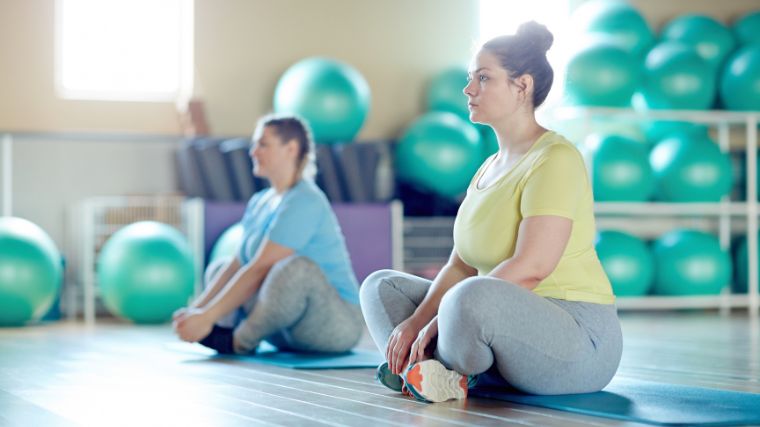
Success as you begin your fitness journey is just a click away. Check out these 12 useful fitness tips to keep in mind as you embark on a lifelong relationship with exercise:
Fitness Tips for Beginners
For the mind, for the body, for the workout.
Editor’s Note: The content on BarBend is meant to be informative in nature, but it should not be taken as medical advice . When starting a new training regimen and/or diet, it is always a good idea to consult with a trusted medical professional. We are not a medical resource. The opinions and articles on this site are not intended for use as diagnosis, prevention, and/or treatment of health problems. They are not substitutes for consulting a qualified medical professional.
Mastering the mind is a critical step to enhancing your quality of life — and your fitness journey. Control your thoughts and you’ll control your own destiny with whatever comes next: Boxing, running, jumping, or lifting.
Don’t Forget Your “Why”
Pro tip: Write down your goal on a post it note and stick it on your bathroom mirror (or the place you tend to look at the most).

[Read More: The Best Foods for Energy Before, During, and After Your Workouts ]
Before you start a detailed exercise and nutrition plan, you need to set SMART goals. SMART stands for “specific, measurable, achievable, relevant, and time-bound,” which helps goal-setters get granular about what they want to accomplish and take productive action. ( 1 )
Maybe you want to run a mile without stopping by the end of the year, or you’re looking to lose a few pounds before your wedding. Whatever your goals are, remember them on the days you need a little extra motivation . Your “why” will drive you to be consistent.
Keep Your Mindset (and Self-Talk) Positive
Pro tip: Remember to be thankful for what your body can do. Start each workout by saying (in your head or out loud) one part of your body that you’re thankful for. An example of this would be, “I’m thankful for my strong legs because they allow me to run.”
Imagine telling a friend over and over that they weren’t good at running or strong enough to lift a certain weight. You probably wouldn’t do that, right? If you wouldn’t say the negative things you’re thinking during a workout to a friend, you shouldn’t say them to yourself. Keep your mindset (and self talk) positive and encouraging .
This skill of positive thinking will extend far beyond the beginning of your fitness journey. You’ll notice that a positive mindset allows you to take future challenges and hurdles in stride (and, hello, who doesn’t want the ability to be more resilient?).
Remember the Mind-Muscle Connection
Pro tip: Turn on a playlist that helps you stay in the moment. This may look like more calming music than you’re used to, but it’ll allow your brain to focus on your movements.

[Read More: The Complete Guide to Pre-Workout Supplements ]
It can be tempting to zone out during a workout, but studies ( 2 ) show it’s actually more beneficial to focus intentionally on the specific movements as you do them. When focusing on a specific muscle, you may be able to more thoroughly engage your muscle fibers, which may improve your gains. This is a great way to practice mindfulness (your yoga instructor would be proud) as well, and stay present in the moment with your body.
Plus, if you’re trying new movements, staying in the moment and connecting your mind to muscle can help reinforce good habits and engrain proper form.
Grab a Friend
Pro tip: An intense workout is more bearable with a friend, so consider trying out something new with a pal by your side.
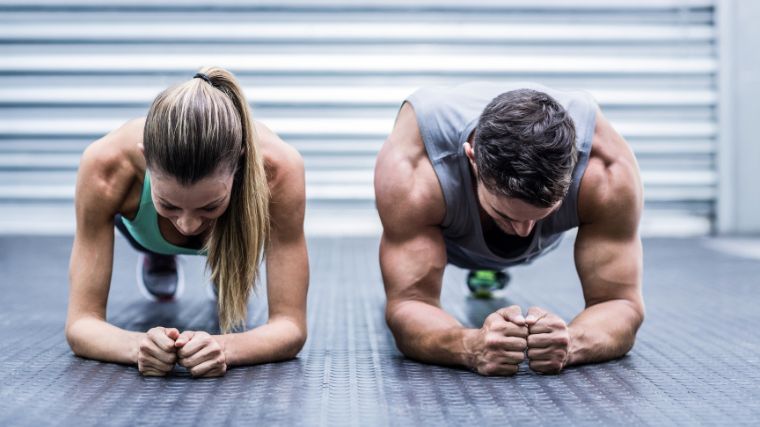
[Read More: The Gymgoer’s Guide to Whey Protein ]
Everything is more fun with a friend, right? Some data ( 3 ) even go so far as to say that when given a choice, people will choose physical activity with a friend over being sedentary alone.
So when you’re feeling less than motivated, invite a friend or two to try a workout class with you . Not only will you have a built-in spotting partner, but you’ll also have someone to cheer you on and motivate you through a tough set. What’s not to love?
The body is your vessel for exercise — and you only get one. Treat your body well and you’ll be ready to brave whatever comes your way.
Drink Enough Water
Pro tip: If hydrating is hard for you, make it fun! Purchase a colorful water bottle and you’ll likely look forward to drinking more water.

[Read More: The Best Online Workout Programs For Coaching, Cardio, Value, And More ]
Yes, drinking water is important. But did you know it can greatly affect the body’s ability to perform during intense exercise? ( 4 ) Studies consistently display that dehydration affects both the physical and mental side of exercise.
This essentially means your body may struggle to do movements and exercises you could typically do if you were better hydrated. It also means your short-term recall suffers and you may perform less, or lower-quality, work overall. Long story short? Drink more water during the day — it affects your workouts .
One gallon of water per day is an oft-cited benchmark, but can be a lofty goal if you’re not used to it. Start with 64 ounces (that’s eight eight-ounce glasses) and you’ll be well on your way, not to mention well-hydrated.
Take Rest Days
Pro tip: Stave off soreness with low-intensity workouts like walking or yoga on your off days.

[Read More: The Best Back Workout for Men, Women, Strength, and More ]
When you work out, the mechanical tension and metabolic stress creates small tears in your muscle tissue.. These small tears need time to repair to grow even stronger, which requires adequate rest and time off.
Bigger muscles aren’t the only reason taking at least one rest day every week is important. You’re also more at risk for overuse injuries if you don’t give your body the needed time to rest and recuperate . And who needs a pulled hamstring or sore hip?
Beginners can do quite well with just three days of exercise per week and four rest days. As you acclimate to the demands of exercise, you can amp up your training frequency if you wish.
Fuel Adequately
Pro tip: Healthy eating looks different for everyone. Consider consulting with a medical professional if you’re unsure of your recommended intake.
[Read More: The 8 Best Exercise Bikes On the Market ]
Your body works much like a car. If you don’t fuel your car up, it’ll eventually run out of gas and won’t move. Similarly, when you don’t give your body enough calories, you’ll begin to notice a downtick in your exercise capability (and energy). The same thought also goes for carbohydrates, which supply your body with short-term energy during a workout.
Long story short? Don’t excessively restrict your caloric intake or carbs because you think it’ll speed up weight loss. Spoiler alert: It won’t. Most folks can tolerate a 500 to 1000 daily caloric deficit. Beyond that, you’re likely to run into serious exhaustion or muscle loss.
Eat More Protein
Pro tip: Build muscle by adding protein powder to your daily smoothie.

[Read More: The 16 Best Creatine Supplements ]
Just as taking rest days are important for performance, eating enough protein is, too. And since muscle tissues are composed of protein, you can imagine recovery is better with adequate protein. Wondering what else protein is useful for?
“Proteins are important for many body processes,” a study from Sports Health ( 5 ) in 2018 explains. “Not only are they the building blocks of muscle, tendons, and other soft tissues, but they also are essential for building enzymes, hormones, and neurotransmitters for many bodily functions.”
And if you’re not sure how much protein your body really needs, it’s always best to consult a registered dietitian. However, for a general estimate, multiply your weight in pounds by 0.36 or use BarBend’s handy protein calculator:
[cal_protein]
Your workout won’t do itself. Here are some tips to get your butt in gear and crush your next (or first) session.
Wear Comfortable (Yet Supportive) Gear
Pro tip: Invest in cushioned socks and appropriate footwear above all.

[Read More: The 13 Best Protein Bars You Can Buy ]
Wearing comfortable clothes eliminates most issues. Okay, only kidding, but wearing breathable and stretchy clothing while working out helps you keep your mind on the task at hand. Look for moisture-wicking fabrics like polyester and nylon, and stay away from materials like cotton, which holds onto sweat like nobody’s business.
And if you’re planning to run, walk, or jog frequently, consider getting properly fitted for running shoes . Many running-specific stores will analyze your gait, arch, and foot strike to put you in a shoe that best supports you.
If you’re starting out with one of the strength sports (that’s powerlifting, strongman, weightlifting, or CrossFit), this holds up as well. A pair of low-cushion, flat and stable shoes are ideal for hitting the weights. For Olympic lifting specifically, a pair of heeled weightlifting shoes are mandatory.
Take Your Ego Out
Pro tip: Pro Tip: Don’t compare your training to someone else’s. You don’t know their fitness goals or fitness routine.
It’s all too easy to get caught up in your own (or other people’s) expectations. Instead of letting ego (or “shoulds”) rule your workout, figure out ways to scale difficult movements to still feel the burn.
[Read More: The 20 Best Ab Exercises for Strength and Definition ]
You don’t have to do everything exactly as prescribed in order to get the benefits from the movement (and others around you don’t care what you’re doing). For example, if you’re not quite ready to do a full burpee during a CrossFit WOD, scale the movement down by doing the push-up component on your knees or excluding the jump. You can still get a stellar workout without over-exerting yourself or trying to lift a specific weight you aren’t ready for.
Pick Workouts You Enjoy
Pro tip: Get creative about how you train. You don’t need to lock yourself up in a dingy gym or slave away on a rickety treadmill to get a good workout.
Physical exercise should add to your life, not detract from it. This of course applies to the strength gain, muscle-building, or health-related results you’re after, but it certainly counts for the enjoyment you get out of your workouts themselves.
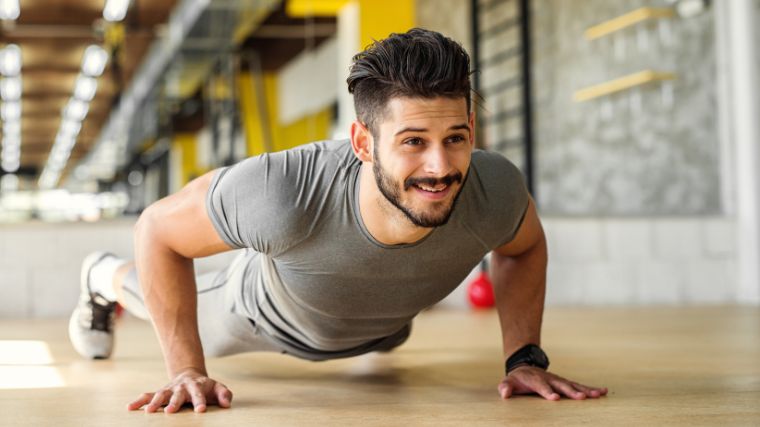
[Read More: The 9 Best Electrolyte Supplements ]
If you’ve always had a fear of water, now is not the time to torture yourself with a water aerobics class just because everyone else is doing it. Find what type of movement fuels you, and stick with that. This could look like hiking with your beloved dog, or maybe tapping back into the joy you felt doing ballet as a child and picking up a dance class.
Stick to Your Plan
Pro tip: Need an extra push? Consider working with a personal trainer . They’ll keep you accountable, and paying for a coach creates buy-in on your part.
Consistency is one of the hardest components for those beginning their fitness journeys. Deciding on a workout schedule and sticking to it is a great way to stay disciplined. Consider blocking off specific time in your calendar and honoring it like a doctor’s appointment. If you wouldn’t bail on a medical check up, then you shouldn’t bail on your set workout time.
[Read More: The 15 Best Shoulder Exercises for Stability, Power, and Aesthetics ]
Once you’ve built the habit of going to an exercise class or hitting the weights every other day, it’ll be harder for you to get out of the routine (which is exactly what you want). If you aren’t into group fitness, a simple Monday, Wednesday, Friday three-day workout routine is easy to remember and easy to stick to.
Get ‘er Done
Nothing will make you feel better except doing the work — and yes, this does pertain to your 5 a.m. CrossFit class or taking a much-needed rest day. You need to be in touch with your mind, body, and the workout you’re about to straight up crush.
And luckily, these 12 fitness tips were designed specifically to help you get in there and get the results you’re after.
- Bailey, Ryan R. “Goal Setting and Action Planning for Health Behavior Change.” American journal of lifestyle medicine vol. 13,6 615-618. 13 Sep. 2017
- Calatayud, Joaquin et al. “Importance of mind-muscle connection during progressive resistance training.” European journal of applied physiology vol. 116,3 (2016): 527-33.
- Salvy, Sarah-Jeanne et al. “Effect of peers and friends on youth physical activity and motivation to be physically active.” Journal of pediatric psychology vol. 34,2 (2009): 217-25.
- Backes, T P, and K Fitzgerald. “Fluid consumption, exercise, and cognitive performance.” Biology of sport vol. 33,3 (2016): 291-6.
- Bytomski, Jeffrey R. “Fueling for Performance.” Sports health vol. 10,1 (2018): 47-53.
Featured Image: Pressmaster / Shutterstock
About Caroline Lubinsky CF-L1
Caroline is a former NCAA D1 Women’s College Soccer player who also played in the WPSL, the second-highest level of professional women’s soccer in the United States. Although soccer was her first love, Caroline eats, sleeps, and breathes all things fitness. She credits her high school’s football coach, Jason Estep, with teaching her how to properly use a barbell at 15 years old and inspiring an enduring love for strength training. Caroline is also a CrossFit Level 1 Trainer. Her work has been featured on sites like Garage Gym Reviews, Family Handyman, Reader's Digest, Daily Meal, Yahoo!, Mashed, and more.
View All Articles
BarBend is an independent website. The views expressed on this site may come from individual contributors and do not necessarily reflect the view of BarBend or any other organization. BarBend is the Official Media Partner of USA Weightlifting.
- Spiritual Health
- Drugs & Medications
- Healthy Cooking
- Fitfluencer

Say Goodbye to Cankles with These 5 Powerful Calf Exercises!
Science-backed strategies for butt fat loss: 10 exercises & more, landmine press guide: strengthen shoulders and core, arnold schwarzenegger’s back workout: a bodybuilding legacy, how to place kickboxing stance properly: mastering proper footwork, a beginner’s guide to kickboxing 101: a dynamic fitness regimen, training like titans: unveiling the secrets of mma fighters, victor richards: the original mass monster, things we must know :the science behind the power of mindfulness, unlocking success: the power of consistence.
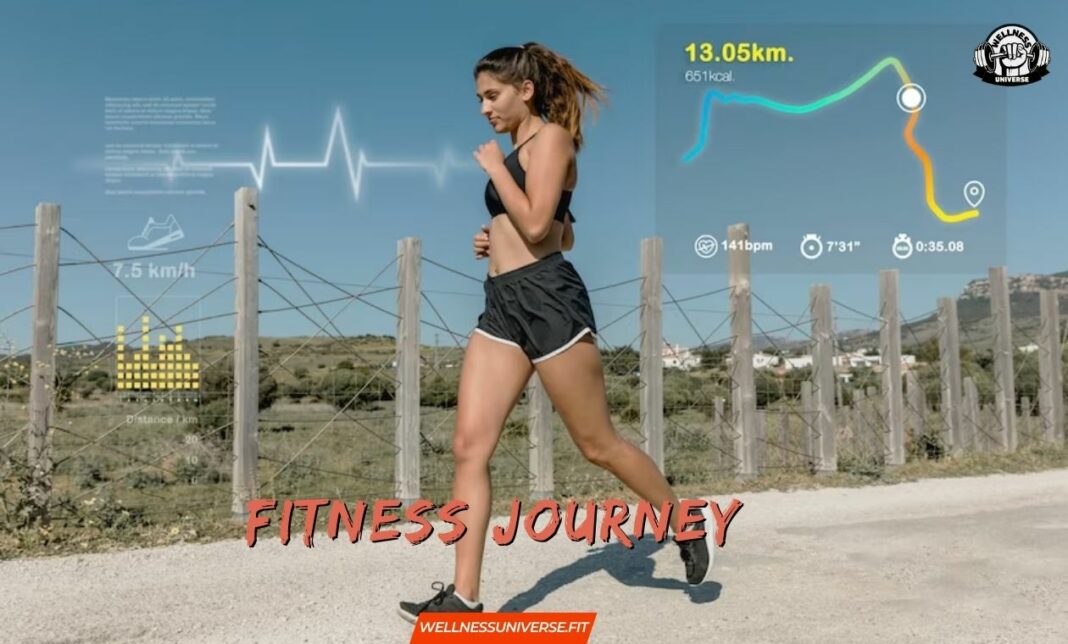
The Ultimate Roadmap to an Empowering Fitness Journey
Embarking on a fitness journey refers to the intentional and structured pursuit of improving one’s physical fitness, overall health, and well-being. It involves setting goals, adopting healthy lifestyle habits, and engaging in regular exercise and physical activity to achieve desired outcomes. A fitness journey is a personal and transformative experience that goes beyond short-term goals and focuses on long-term sustainable changes.
A fitness journey is unique to each individual, as it is tailored to their specific needs, preferences, and starting point. It can involve a wide range of activities such as cardio exercises, strength training, flexibility exercises, and mindful practices like yoga or meditation. The journey may also include modifications to one’s diet, sleep patterns, stress management techniques, and overall lifestyle choices.
Embarking on a fitness journey holds immense significance for individuals seeking to improve their health and overall quality of life. Here are some key reasons why a fitness journey is important:
- Physical health improvement: Engaging in regular exercise and physical activity has numerous benefits for physical health. It helps strengthen the cardiovascular system, improves muscle tone and strength, enhances flexibility, boosts metabolism, and promotes weight management. Regular physical activity also reduces the risk of chronic conditions such as heart disease, diabetes, and certain types of cancer.
- Mental and emotional well-being: Exercise has a profound impact on mental and emotional health. It releases endorphins, commonly known as “feel-good” hormones, which promote a positive mood, and reduce stress, anxiety, and symptoms of depression. Regular exercise also improves cognitive function, enhances focus, and increases self-confidence and self-esteem.
- Energy and vitality: A fitness journey can significantly increase energy levels and overall vitality. Regular physical activity improves circulation, delivering more oxygen and nutrients to the body’s tissues and organs. This leads to increased energy, improved alertness, and a greater sense of vitality throughout the day.
- Longevity and quality of life: Adopting a fitness journey can positively influence longevity and overall quality of life. Regular exercise has been shown to increase life expectancy and reduce the risk of premature death. It enhances functional abilities, promotes independence, and enables individuals to enjoy an active and fulfilling life well into older age.
- Personal growth and self-discovery: A fitness journey is not just about physical transformation but also about personal growth and self-discovery. It provides an opportunity to challenge oneself, push beyond comfort zones, and discover new strengths and capabilities. It cultivates discipline, perseverance, and resilience, fostering a sense of accomplishment and personal empowerment.
By embarking on a fitness journey, individuals can experience holistic improvements in their physical, mental, and emotional well-being. It offers an empowering path toward self-improvement, personal growth, and a healthier, more fulfilling life.
Starting Your Fitness Journey
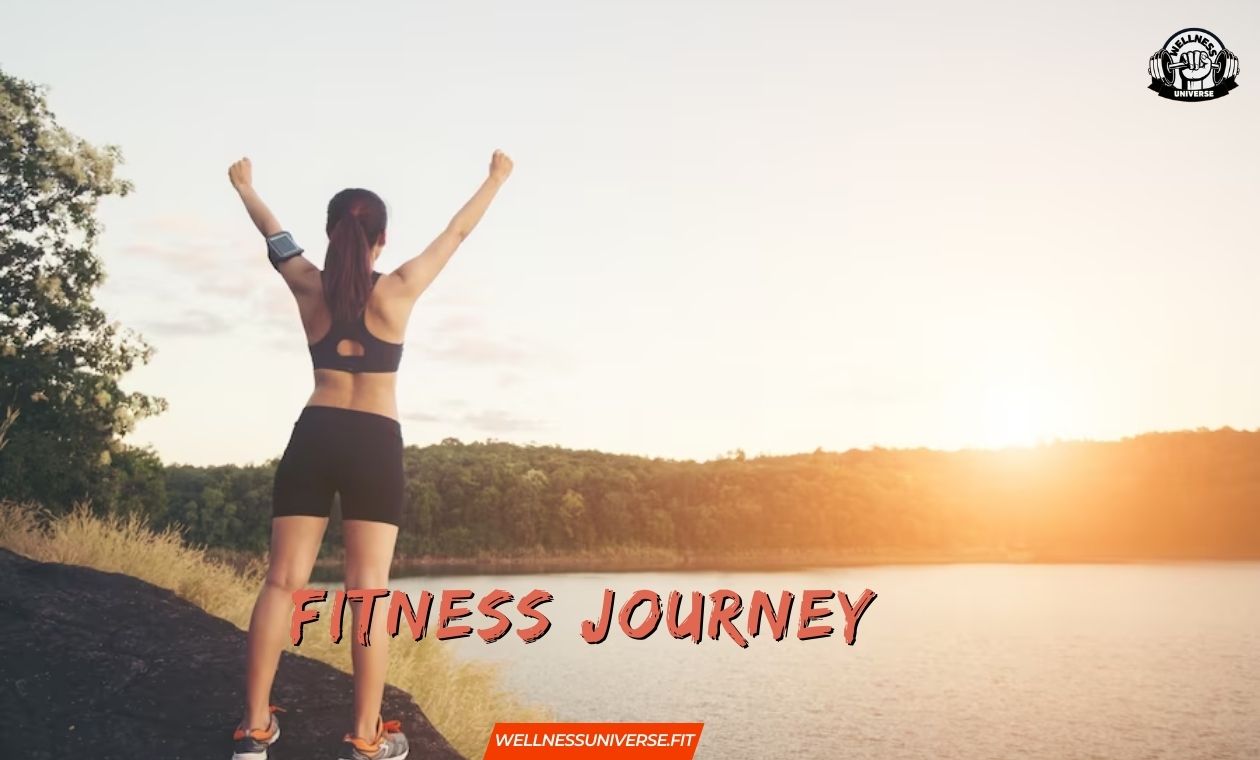
One of the first steps in starting a fitness journey is setting clear and realistic goals. Goals provide direction, motivation, and a sense of purpose throughout the journey. When setting fitness goals, it’s important to make them specific, measurable, attainable, relevant, and time-bound (SMART). This means defining the desired outcome, determining measurable indicators of progress, ensuring the goals are within reach, aligning them with personal values and aspirations, and setting a timeframe for achievement.
Examples of fitness goals could include losing a certain amount of weight, increasing strength and muscle tone, improving cardiovascular endurance, participating in a specific event or sport, or simply adopting a more active and healthy lifestyle. Setting goals that are meaningful to you will keep you focused and motivated along your fitness journey.
Before starting any fitness program, it’s essential to assess your current fitness level. This assessment helps you understand your strengths, weaknesses, and areas that need improvement. It also provides a baseline against which you can track your progress and measure the effectiveness of your fitness journey.
There are various ways to assess your fitness level. You can start by evaluating your cardiovascular fitness through exercises like walking, jogging, or cycling to determine your endurance and aerobic capacity. Strength tests, such as push-ups, squats, or lifting weights, can assess your muscular strength. Additionally, flexibility tests like reaching for your toes or performing stretches can evaluate your range of motion.
Alternatively, you may consider seeking professional help from a certified fitness trainer or healthcare professional who can conduct a comprehensive fitness assessment. They can provide a more accurate evaluation of your fitness level, identify any potential limitations or health concerns, and tailor a fitness plan that suits your specific needs and goals.
Before embarking on a fitness journey, it is advisable to consult with a healthcare professional, especially if you have any underlying health conditions or concerns. A healthcare professional, such as a doctor or a registered dietitian, can provide valuable guidance and support to ensure your fitness journey is safe and effective.
During the consultation, you can discuss your goals, medical history, and any concerns you may have. The healthcare professional can assess your overall health, provide recommendations on exercise intensity and duration, discuss dietary considerations, and offer insights into managing any health conditions or medications that may impact your fitness journey.
This consultation is particularly important if you have a history of chronic conditions, are pregnant or postpartum, are over the age of 40, or have been inactive for an extended period. The healthcare professional can help create a personalized fitness plan that takes into account your individual needs, abilities, and limitations, ensuring a safe and successful start to your fitness journey.
By setting clear goals, assessing your current fitness level, and consulting with a healthcare professional, you establish a solid foundation for your fitness journey. This proactive approach enables you to create a personalized plan that aligns with your aspirations, minimizes the risk of injury, and sets you up for long-term success.
Benefits of a Fitness Journey
Embarking on a fitness journey brings numerous benefits to your physical health. Regular exercise and physical activity have been shown to reduce the risk of chronic diseases and improve overall health. Here are some of the key physical health benefits of a fitness journey:
- Weight management: Engaging in regular physical activity helps in weight management by burning calories and building lean muscle mass. It can assist in achieving and maintaining healthy body weight, reducing the risk of obesity-related conditions such as heart disease, diabetes, and certain cancers.
- Cardiovascular health: Regular exercise strengthens the heart muscle, improves blood circulation, and lowers blood pressure. It reduces the risk of developing cardiovascular diseases, including heart attacks, strokes, and coronary artery disease.
- Stronger bones and muscles: Weight-bearing exercises, such as resistance training and weightlifting, stimulate bone growth and increase bone density, reducing the risk of osteoporosis. Additionally, strength training exercises help build and maintain muscle mass, improving overall strength and stability.
- Improved immune system: Regular physical activity has been shown to enhance the immune system’s function, reducing the risk of certain illnesses and infections.
- Better sleep: Engaging in physical activity can improve the quality of sleep, helping you fall asleep faster and enjoy deeper, more restorative sleep. It also helps regulate your sleep-wake cycle, promoting a consistent and refreshing sleep pattern.
In addition to the physical benefits, a fitness journey has a positive impact on mental and emotional well-being. Regular exercise has been linked to improved mood, reduced symptoms of anxiety and depression, and enhanced overall mental well-being. Here’s how a fitness journey can boost your mental health:
- Stress relief: Physical activity stimulates the release of endorphins, the body’s natural “feel-good” chemicals, which help reduce stress and improve mood. Exercise provides a healthy outlet for managing stress and promoting relaxation.
- Enhanced cognitive function: Regular exercise has been shown to improve cognitive function, including memory, attention, and problem-solving skills. It stimulates the growth of new brain cells and enhances the brain’s ability to form connections.
- Increased self-esteem: Achieving fitness goals, improving physical fitness, and taking care of your health can boost self-confidence and self-esteem. The sense of accomplishment from overcoming challenges and making progress in your fitness journey contributes to a positive self-image.
- Mood regulation: Exercise has a positive impact on mood regulation, helping to alleviate symptoms of anxiety and depression. It promotes the release of neurotransmitters like serotonin and dopamine, which are associated with improved mood and a sense of well-being.
Regular physical activity improves energy levels and enhances stamina. As you engage in a fitness journey, you’ll experience increased endurance, allowing you to perform daily activities with less fatigue. Regular exercise helps your cardiovascular system work more efficiently, delivering oxygen and nutrients to your muscles, which boosts overall energy levels.
A fitness journey can significantly improve self-confidence and body image. As you progress in your fitness goals, achieving milestones and overcoming obstacles, you’ll develop a sense of pride and self-assurance. Your physical transformations and increased fitness levels contribute to a positive self-perception and improved self-confidence in various areas of life.
In summary, a fitness journey offers a multitude of benefits for both physical and mental well-being. From weight management and cardiovascular health to improved mood and self-confidence, embracing a fitness journey positively impacts various aspects of your life. By committing to regular physical activity and making fitness a priority, you can reap the rewards of a healthier, happier, and more confident you.
Duration of a Fitness Journey
When embarking on a fitness journey, it’s essential to recognize that it is not a temporary endeavor but a lifelong commitment to your health and well-being. Fitness is a continuous journey that involves adopting healthy habits, maintaining consistency, and adapting to various stages of life. While specific goals may have time frames attached to them, the overall fitness journey extends beyond reaching those goals. It’s about cultivating a sustainable and healthy lifestyle that you can maintain in the long run.
The duration of a fitness journey varies for each individual and depends on several factors, including starting points, goals, commitment, and lifestyle. It’s crucial to set realistic expectations for progress and avoid comparing your journey to others. Progress is not always linear, and there may be periods of plateaus or setbacks along the way. It’s important to focus on gradual improvements and celebrate small victories, as they contribute to long-term success.
Instead of fixating on a specific timeline, shift your focus to building healthy habits and making consistent progress. Embrace the concept of sustainable change rather than seeking quick fixes or rapid transformations. Remember that the most significant transformations occur over time and require patience, dedication, and perseverance.
A fitness journey is not a destination but an ongoing process of continuous improvement. As you progress, your goals may evolve, and new challenges and opportunities may arise. Embrace the mindset of constantly striving to be better and finding new ways to challenge yourself physically and mentally.
Set new goals or milestones periodically to keep yourself motivated and engaged in your fitness journey. This could involve increasing the intensity or duration of your workouts, trying new forms of exercise, participating in fitness events or competitions, or exploring different fitness disciplines.
Furthermore, focus on holistic growth beyond physical fitness. Consider incorporating other elements into your fitness journey, such as improving flexibility, practicing mindfulness and stress management techniques, or enhancing your nutrition. The key is to maintain a growth mindset and embrace opportunities for self-improvement in all aspects of your well-being.
In summary, the duration of a fitness journey is not limited to a specific timeframe but is an ongoing commitment to a healthy and active lifestyle. Understand that progress may take time, and it’s important to set realistic expectations and avoid comparing yourself to others. Embrace the concept of continuous improvement, continually challenging yourself, and exploring new growth opportunities. Remember, a fitness journey is a personal and lifelong endeavor that extends far beyond reaching initial goals, and the key to success lies in maintaining consistency and a positive mindset throughout the journey.
Creating a Fitness Journey Plan
One of the keys to a successful fitness journey is finding activities and exercises that you genuinely enjoy. When you engage in activities you like, you’re more likely to stay motivated and committed to your fitness plan. Take some time to explore different types of physical activities, such as running, swimming, dancing, hiking, cycling, or playing a sport. Experiment with various exercises and discover what brings you joy and fulfillment.
Consider your preferences, interests, and lifestyle when choosing activities. If you enjoy being outdoors, you might opt for activities like hiking or cycling. If you prefer a social environment, group fitness classes or team sports could be a great fit. The goal is to find activities that keep you engaged, excited, and eager to participate.
A well-rounded fitness journey plan includes a combination of cardio, strength training, and flexibility exercises. Each component plays a vital role in improving overall fitness, health, and functional ability.
Cardiovascular exercises, such as jogging, swimming, or cycling, elevate your heart rate and help improve cardiovascular health, endurance, and calorie burn. Aim for at least 150 minutes of moderate-intensity aerobic activity or 75 minutes of vigorous-intensity aerobic activity each week.
Strength training exercises, such as weightlifting or bodyweight exercises, help build muscle strength, improve bone density, and enhance overall body composition. Include strength training exercises at least two days a week, targeting all major muscle groups.
Flexibility exercises, such as yoga or stretching routines, improve joint mobility, muscle flexibility, and posture. Incorporate stretching exercises into your fitness plan to enhance your range of motion and reduce the risk of injuries.
Remember to start gradually and progress gradually. If you’re new to exercise or returning after a break, begin with low-intensity activities and gradually increase the duration and intensity as your fitness level improves.
To stay organized and motivated, it’s essential to design a fitness journey plan that includes a schedule and milestones. Set aside specific days and times for your workouts, treating them as non-negotiable appointments with yourself. Consistency is key, so aim for regular exercise sessions throughout the week.
Consider your personal schedule and commitments when designing your fitness plan. Find a balance that works for you, whether it’s early morning workouts, lunchtime sessions, or evening exercises. Choose a time when you’re most likely to follow through with your fitness routine and when you feel energized and focused.
Setting milestones can provide a sense of direction and accomplishment throughout your fitness journey. Break down your goals into smaller, manageable milestones that you can work towards. These could include increasing the duration or intensity of your workouts, reaching a specific weight or body composition target, or achieving a certain fitness milestone, like running a 5K race.
Track your progress regularly, celebrating each milestone you achieve. This can help you stay motivated and provide tangible evidence of your growth and improvement. Consider using a fitness tracker or journal to record your workouts, measurements, and milestones.
In conclusion, creating a fitness journey plan involves identifying enjoyable activities, incorporating a variety of exercises, and designing a schedule with milestones. Choose activities that you genuinely enjoy and that align with your preferences and lifestyle. Incorporate cardio, strength training, and flexibility exercises to improve overall fitness and health. Design a schedule that suits your routine and set realistic milestones to work towards. Remember, the key is to find a balance that is sustainable and enjoyable, making your fitness journey a positive and fulfilling experience.
Staying Motivated During Your Fitness Journey
One of the most important factors in staying motivated during your fitness journey is finding your inner motivation and purpose. This involves identifying the reasons why you want to embark on this journey and understanding the personal benefits it will bring to your life. Ask yourself what drives you and what you hope to achieve through your fitness journey.
Some common motivations for embarking on a fitness journey include improving overall health, increasing energy levels, boosting self-confidence, managing stress, or achieving specific fitness goals. Reflect on your own aspirations and values to determine what truly inspires you. By connecting with your inner motivation and purpose, you’ll have a strong foundation to stay committed even when challenges arise.
Setting rewards and incentives along the way can provide an extra boost of motivation during your fitness journey. Rewards serve as positive reinforcement for your efforts and help you stay focused on your goals. Consider setting both short-term and long-term rewards to celebrate milestones and accomplishments.
Short-term rewards can be simple and immediate, such as treating yourself to a massage, buying new workout gear, or enjoying a favorite healthy meal. These rewards act as reminders of the progress you’ve made and encourage you to continue moving forward.
Long-term rewards can be more significant and aligned with your ultimate fitness goals. For example, if your goal is to run a marathon, treat yourself to a weekend getaway after completing the race. These rewards serve as a culmination of your hard work and dedication.
Remember that rewards don’t always have to be material. Consider rewarding yourself with non-food-related treats, like a day off to relax, a movie night with friends, or a spa day. The key is to choose rewards that are meaningful to you and that reinforce the positive behaviors you’re cultivating throughout your fitness journey.
Building a support system can greatly contribute to your motivation and accountability during your fitness journey. Surrounding yourself with positive and like-minded individuals who share similar goals can provide the encouragement and support you need to stay on track.
Reach out to friends, family members, or colleagues who have an interest in fitness or who are also on their own fitness journey. Share your goals with them and ask if they would like to join you or provide support along the way. Having a workout buddy or a group of people who understand and share your challenges and successes can be incredibly motivating.
Additionally, consider joining a fitness community or finding an online support group. These communities offer a sense of belonging and can provide valuable insights, tips, and encouragement. Engaging with others who are also striving for better health and fitness can create a sense of camaraderie and inspire you to keep pushing forward.
Don’t hesitate to lean on your support system when you face obstacles or moments of doubt. They can offer guidance, celebrate your victories, and remind you of your progress. Likewise, be a source of support for others, as helping others on their fitness journey can reinforce your own commitment and sense of purpose.
In conclusion, staying motivated during your fitness journey requires finding your inner motivation and purpose, setting rewards and incentives, and seeking support from friends, family, or a fitness community. Connect with the reasons why you want to embark on this journey and use them as a source of inspiration. Set rewards and incentives to celebrate your progress and keep you motivated along the way. Surround yourself with a supportive community that understands and shares your goals. By implementing these strategies, you’ll maintain the motivation needed to stay committed and achieve long-term success in your fitness journey.
Diet and Nutrition during Your Fitness Journey
When it comes to your fitness journey, diet and nutrition play a crucial role in supporting your overall health, optimizing your physical performance, and achieving your fitness goals. A balanced and nutritious diet provides the necessary fuel, nutrients, and building blocks for your body to function optimally.
A balanced diet consists of a variety of nutrient-dense foods from different food groups, including fruits, vegetables, whole grains, lean proteins, and healthy fats. These foods provide essential vitamins, minerals, antioxidants, and fiber that promote overall well-being and support your fitness endeavors.
To maintain a balanced diet, aim to include a wide range of colorful fruits and vegetables in your meals, as they offer an array of vitamins, minerals, and antioxidants. Incorporate whole grains like brown rice, quinoa, and whole wheat bread to provide sustained energy and fiber. Choose lean proteins such as chicken, fish, legumes, and tofu to support muscle repair and growth. Additionally, incorporate healthy fats from sources like avocados, nuts, seeds, and olive oil for their beneficial effects on heart health and nutrient absorption.
Different individuals may have different dietary preferences and requirements. It’s important to explore and find a dietary approach that aligns with your goals, preferences, and lifestyle. Some popular dietary approaches that people incorporate into their fitness journey include:
- Mediterranean Diet: This diet emphasizes whole foods, such as fruits, vegetables, whole grains, legumes, fish, and healthy fats like olive oil. It’s known for its heart-healthy benefits and is rich in antioxidants and anti-inflammatory compounds.
- Plant-Based or Vegan Diet: This diet focuses on consuming plant-based foods and excludes animal products. It emphasizes fruits, vegetables, whole grains, legumes, nuts, and seeds. It can be beneficial for those seeking a diet that is higher in fiber, lower in saturated fat, and environmentally sustainable.
- Low-Carb or Ketogenic Diet: These diets restrict carbohydrate intake and prioritize fats and proteins. They aim to shift the body into a state of ketosis, where it primarily burns fat for energy. These approaches may be suitable for some individuals, but it’s important to consult with a healthcare professional before adopting such a diet, especially if you have any underlying health conditions.
- Intuitive Eating: This approach focuses on listening to your body’s hunger and fullness cues, eating mindfully, and cultivating a positive relationship with food. It encourages honoring your cravings while also prioritizing nutrient-dense foods.
Remember, there is no one-size-fits-all approach to nutrition. What works for one person may not work for another. It’s essential to experiment, listen to your body, and find a dietary approach that supports your fitness goals while nourishing your body and promoting overall well-being.
If you find yourself unsure about the dietary aspects of your fitness journey, it can be helpful to seek guidance from a registered dietitian (RD) or a nutritionist. These professionals are trained in nutrition science and can provide personalized advice based on your specific needs, goals, and health conditions.
An RD can assess your current dietary habits, help you identify areas for improvement, and provide practical strategies for incorporating nutritious foods into your daily routine. They can also address any concerns or questions you may have regarding supplements, portion sizes, meal timing, and navigating social situations that involve food.
Working with an RD can provide you with the knowledge, support, and accountability necessary to optimize your nutrition and achieve your fitness goals in a safe and sustainable manner. They can tailor their recommendations to your unique circumstances, ensuring that your dietary choices align with your fitness journey.
In conclusion, during your fitness journey, it’s important to prioritize a balanced and nutritious diet to support your overall health and fitness goals. Aim for a variety of nutrient-dense foods from different food groups and explore different dietary approaches to find what works best for you. If you need further guidance, consider consulting with a registered dietitian or nutritionist who can provide personalized advice and support. By nourishing your body with the right foods and seeking professional guidance when needed, you’ll optimize your nutrition and enhance the benefits of your fitness journey.
Embarking on a fitness journey is a transformative and empowering experience that can positively impact your life in numerous ways. Whether you’re just beginning your journey or have been on it for a while, remember that every step you take toward a healthier lifestyle matters. Take pride in the progress you make, no matter how small, and celebrate your achievements along the way.
If you haven’t started your fitness journey yet, now is the perfect time to take that first step. Embrace the opportunity to prioritize your health, well-being, and happiness. Remember, every fitness journey is unique, and there is no right or wrong path to follow. It’s about finding what works for you and creating sustainable habits that align with your goals and values.
Your fitness journey is not just about physical transformation; it’s also about improving your mental and emotional well-being. It’s an opportunity to discover your inner strength, challenge your limits, and unlock your full potential. Embrace the journey as an opportunity for self-discovery and growth.
Throughout your fitness journey, it’s essential to practice self-compassion and kindness. Be patient with yourself and recognize that progress takes time. There will be ups and downs, setbacks and obstacles, but remember that each setback is a chance to learn, grow, and come back even stronger.
Surround yourself with a supportive network of friends, family, or like-minded individuals who share your passion for a healthier lifestyle. Seek inspiration from success stories and individuals who have overcome challenges similar to yours. Their stories can serve as a reminder that you’re not alone and that your goals are achievable with dedication and perseverance.
Lastly, remember that a fitness journey is not just a temporary phase but a lifelong commitment to your well-being. Embrace the changes you make as lasting lifestyle choices rather than quick fixes. Continually reassess your goals, set new challenges, and adapt your routines as you progress. Embrace the joy of movement, nourish your body with wholesome foods, and prioritize self-care in all aspects of your life.
Your fitness journey is an ongoing adventure, full of growth , self-discovery, and opportunities for a healthier and happier life. Embrace it with enthusiasm, dedication, and an open mind. Believe in yourself, stay committed to your goals, and never forget the incredible potential that lies within you.
As you embark on or continue your fitness journey, remember that the power to transform your life is in your hands. You have the ability to create a healthier, stronger, and more vibrant version of yourself. Embrace the journey, enjoy the process, and savor the rewards of a fitter, happier, and more fulfilling life.
Thank you for joining us on this fitness journey! We hope you found our The Ultimate Roadmap to an Empowering Fitness Journey blog insightful and inspiring. Our aim is to provide you with valuable information, expert advice, and motivational content to support you in your wellness endeavors.
Related Post :-
- How To Do Wall Pushups
- Hand Size Demystified
- CrossFit Unleashed
- Barbell Lunges
- Forearm Fortitude
- Kettlebell Circuit
- Squat Mastery
Shoulder Exercises
FAQs about Fitness Journey
What is a fitness journey.
A fitness journey refers to the process of adopting a healthier and more active lifestyle with the goal of improving physical fitness, overall well-being, and achieving personal fitness goals.
How do I start my fitness journey?
To start your fitness journey, begin by setting clear and realistic goals, assessing your current fitness level, and designing a fitness plan that includes a variety of exercises and activities. Start with small steps and gradually increase intensity and duration as you progress.
What are the benefits of embarking on a fitness journey?
Embarking on a fitness journey offers numerous benefits, including improved cardiovascular health, increased strength and endurance, weight management, stress reduction, enhanced mood, and mental well-being, increased energy levels, and reduced risk of chronic diseases.
How long does a fitness journey usually take?
The duration of a fitness journey varies for each individual and depends on factors such as starting fitness level, goals, consistency, and dedication. It is important to view fitness as a lifelong journey rather than a short-term endeavor, as maintaining a healthy lifestyle is a continuous process.
What should I include in my fitness journey plan?
Your fitness journey plan should include a combination of cardiovascular exercises, strength training, flexibility exercises, and adequate rest and recovery. It should be tailored to your goals, preferences, and fitness level. It is also important to incorporate proper nutrition and hydration into your plan.
How do I stay motivated during my fitness journey?
To stay motivated, set specific and realistic goals, track your progress, celebrate achievements, find activities you enjoy, vary your workouts, seek support from friends or a fitness community, reward yourself for milestones, and remind yourself of the benefits and positive changes that come with a consistent fitness routine.
What are some common challenges people face during their fitness journey?
Some common challenges during a fitness journey include lack of motivation, time constraints, plateaus in progress, dealing with injuries or setbacks, balancing fitness with other responsibilities, and overcoming self-doubt or negative thoughts. It is important to stay resilient, adapt to challenges, and seek support when needed.
Can I embark on a fitness journey without a gym membership?
Absolutely! A fitness journey can be pursued without a gym membership. There are numerous options for home workouts, outdoor activities, bodyweight exercises, and fitness classes or programs available online. It's important to find activities that suit your preferences and fit your lifestyle.
What are some effective exercises for a fitness journey?
Effective exercises for a fitness journey include activities such as running, walking, cycling, swimming, strength training with weights or resistance bands, yoga, Pilates, HIIT (High-Intensity Interval Training), and functional training exercises that engage multiple muscle groups. Choose exercises that align with your goals and preferences.
How can I track my progress during my fitness journey?
You can track your progress by keeping a fitness journal, recording workout sessions, tracking measurements, monitoring changes in weight or body composition, using fitness apps or wearable devices, and assessing improvements in endurance, strength, flexibility, or performance. Regularly review your progress to stay motivated and make necessary adjustments to your fitness plan.

Meet Pradeep Singh, your go-to guide for all things fitness, health, and motivation. With over 7 years in the field, Pradeep brings a blend of expertise and real-world experience to his writing. From workout tips to healthy living insights, he simplifies complex topics, making fitness accessible for everyone. His authentic approach and genuine passion aim to inspire and support your wellness journey. Get ready to embark on a path to a healthier lifestyle with Pradeep as your trusted companion and motivator.
RELATED ARTICLES MORE FROM AUTHOR
Leave a reply cancel reply.
Save my name, email, and website in this browser for the next time I comment.

10 Proven Ways to Weight Loss Without Breaking a Sweat in 2024
The Pros and Cons of Metabolic Confusion: Fad Diet or Fat-Burning Genius?
12 Weeks Pregnant: Symptoms and Baby Development Guide
Popular posts, becoming the dark knight: the epic batman workout revealed, fierce and fit: empowering female through muscle growth, bmi breakthrough: transform your body, popular category.
- Workout 143
- Lifestyle 20
- Nutrition 8
- Spiritual Health 5
- Motivation 3
- Healthy Cooking 3
It’s time for your 2023 fitness journey—here’s how to get started
Here's how to help the new you achieve those fitness goals.
By Sandra Gutierrez G. | Published Jan 15, 2023 9:00 AM EST
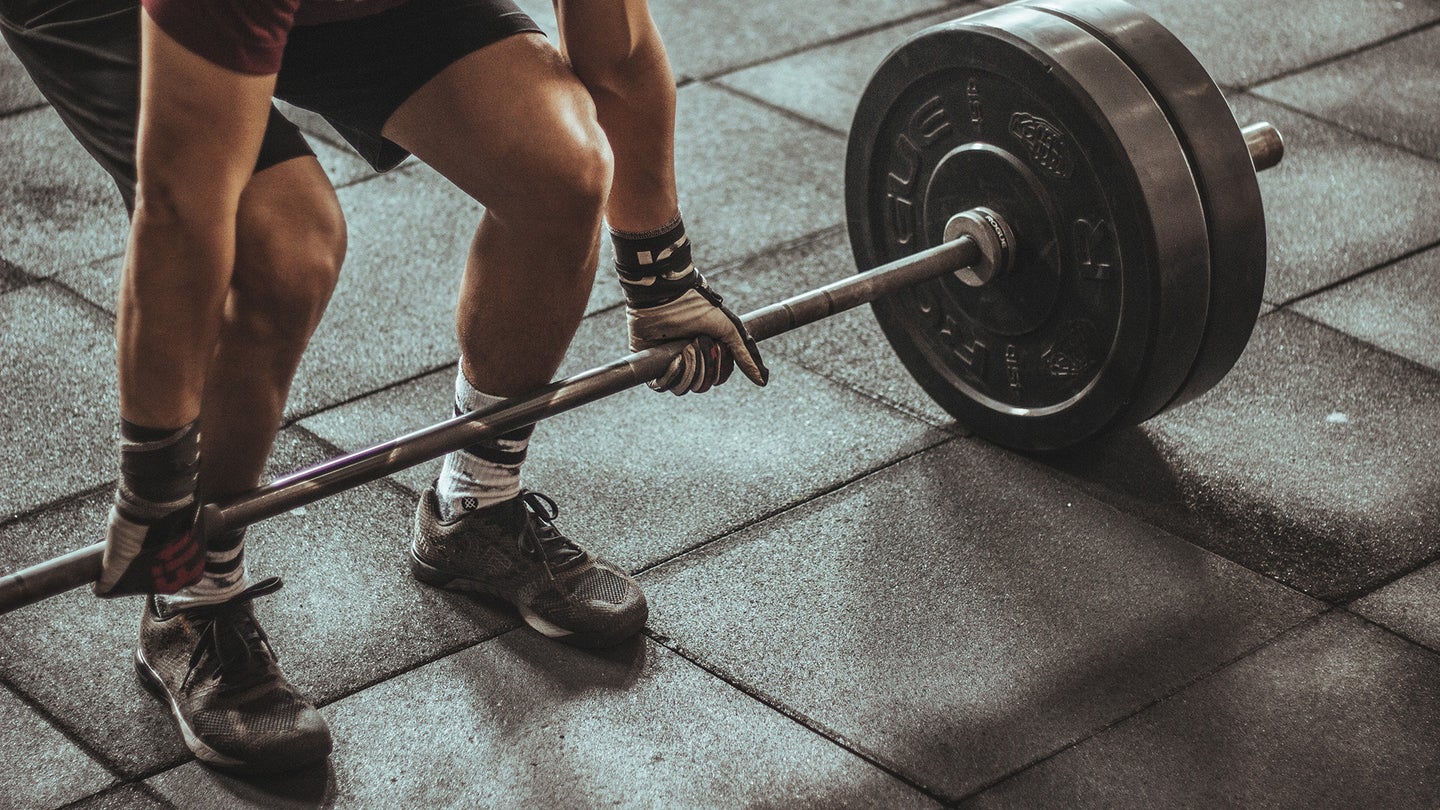
A new year is always a fresh opportunity to start your fitness journey. This can mean anything, whether you’d just like to get off the couch more often, want to run a 5K, or are hoping to win a bodybuilding competition by 2024.
You may not be sure about how to achieve your goals, but that’s ok. Having the motivation to get out there is half the battle, and we want to help you along your way.
PopSci has a number of science-backed fitness stories to guide you in this new era. You’ll learn how to make the best of your workouts, how to get gains safely and consistently, and how to keep your body healthy along the way.
Understand how to build muscle
Fitness novices might think getting buff is just about lifting heavy objects over and over again. In a nutshell, it sort of is, but there’s a lot more to it. Learning about muscles and how your body builds them will help you understand concepts like hypertrophy and failure, and allow you to get the most out of each workout.
Our guide on how to get muscle gains will walk you through that process and explain how resting is as important as going to the gym, and how protein is a crucial element your body needs to build more mass.
[Related: You should definitely rotate your workouts ]
Food restrictions like veganism can seem like an added layer of difficulty when it comes to including enough protein in your diet, but getting those gains doesn’t require you to become a carnivore. If you need guidance, head on over to our vegan guide on how to get muscle gains and learn about the foods that will give you the nutrients you need to achieve your fitness goals.
Don’t forget to warm up
Whatever sport or discipline you choose, one of the most common mistakes fitness noobs make when they start working out is to skip warmups. They can seem boring and pointless because you may feel like you don’t actually need them, but trust us: your body does. Warming up properly before you go for a jog or start lifting will help you perform better and prevent injuries in the long run, which will allow you to take your fitness journey even further.
But before you repeat the same stationary stretches you might remember from PE class, give dynamic warmups a try . These exercises will not only tell your brain it’s time to move—which is especially important after sitting at a desk for a while—but will also prepare your body for physical activity by getting your blood flowing and your heart rate up.
Help your body recover
You may think that when it comes to exercise, more is better. And since you’re already motivated and proud of your effort, why not keep going? Well, giving your body time to recover is also essential to your fitness journey.
But other than resting, there are other techniques you can use to help your muscles feel better after a heavy workout . That annoying and painful soreness you feel around 24 hours after your last gym session is a result of muscle damage, and recovery techniques can help you handle the pain and help tissue heal faster.
From classic stretching to foam rollers, ice baths, and massages, our guide on what works when it comes to recovery can be exactly what you need when your muscles are so sore that getting off your chair comes with excruciating pain.
Once you’re at least a couple of months into your journey and have made a little progress, you might find yourself hitting a wall that makes results harder to come by. This is normal and happens to a lot of people as their bodies change. To get back on that progress train, you might need more data about what you’re putting into your body, and tracking your nutrition can be incredibly useful for that.
Knowing your maintenance rate—the number of calories you burn simply by existing—can give you a baseline to adjust the number of calories you eat every day to keep the muscles growing and fat-burning going.
It’s important to know that monitoring your food can be a slippery slope to unhealthy habits, so make sure to do it only for short periods of time, and to follow experts’ recommendations regarding calorie surplus and deficit. And if you don’t know what those are, don’t worry—it’s all in our guide.
Measure progress
Data not only shows you how much to eat but also how far you’ve come. Gathering information about your workouts will make it easier to measure your progress, and you’ll be able to celebrate even the smallest victories so you can push yourself a bit further.
Getting a fitness tracker can help compile all the statistics you need to keep going and improving—all you need is to put it on and go do your best. And if you don’t know which wearable to get, we have some recommendations that might lead you in the right direction.
The type of device you get will highly depend on your budget and your preferred activity, but there are a lot of options to choose from, and they can all give you that extra motivation you need to face another day of your fitness journey.
Try getting a little help from supplements
Nutritional supplements can help get your body what it needs to perform better, stay healthy, and build muscle. But a quick trip to your local drugstore is enough to get anyone incredibly confused. The market is saturated with options, so which supplements actually work?
[Related: The three strength exercises everyone should do ]
When it comes to building muscle and improving performance, science has only found two supplements that will help . Learning how to take them and how they work for your body will help you have a better understanding of your process. Keep in mind that you may need to consult a doctor before you start supplementing your nutrition, and also remember supplements don’t do miracles. Moving, resting, and, above all, patience, will keep you on a good path to your fitness goals.

Sandra Gutierrez is the former Associate DIY editor at Popular Science. She makes a living by turning those “Wait, I can make that!” moments she has while browsing the internet into fully-fledged stories—and she loves that. Contact the author here.
Like science, tech, and DIY projects?
Sign up to receive Popular Science's emails and get the highlights.

The Beginner’s Guide To Starting A Fitness Journey
- July 25, 2017

- Getting rid of medications that are unnecessary with lifestyle changes.
- Being able to keep up with your kids/grandkids and enjoy life with them instead of watching from the sidelines.
- Being a good role model for those in your life who are looking to you for guidance.
- Managing or even better, eliminating chronic disease and illness born from poor lifestyle.
- Clothes fitting looser. Okay, so the scale hasn’t moved yet. But you’re clearly getting smaller which was the goal, right? So stop obsessing over an arbitrary numbers machine and actually pay attention to the changes in your body.
- Getting better sleep and feeling vibrant. It’s a by-product of regular exercise, so when this lovely side effect hits you, embrace it with wide open arms.
- Feeling HAPPIER from that endorphin glow each day. Starting or ending your day with an amazing workout and that lovely life elixir called sweat.
- Being more PRODUCTIVE because you have more energy to show up for your life in a really positive way.

- Afternoon home spa pampering yourself or go get a mani/pedi.
- Donate your now-too-big clothes to charity.
- Use stickers to note the date of your milestone achievements on your calendar.
- Plan a healthy day trip with friends such as hiking.
- Get a massage.
- Schedule a professional photoshoot .
- Plan and execute your dream vacation.
- Buy new workout gear.
- Make a new playlist.
- Go shopping … in your own closet!
- Snag a fresh bouquet of flowers at the farmers market.
- Find a new plant to add to your garden.
About Inspired Wellness We are a wellness movement aimed at cultivating greatness in all areas of life. We believe that everything is connected and that having the body of your dreams shouldn’t come at the price of your mental and emotional health. You CAN have it all; you just need some determination, grit and the desire to truly change your life!
Catch us locally in sunny Sacramento CA inspiring lives at our wellness center with fitness, nutrition and lifestyle programs, or online doing the same thing with our new online training site + community coming soon!
Want more content like this delivered straight to your inbox? Get a weekly dose of inspiration by subscribing here .
Let’s get social! Come connect with us in these places:
Free Wellness Group : facebook.com/groups/iwagaccgroup Facebook : facebook.com/theinspiredwellness Instagram : instagram.com/inspirewellness
Inspired Wellness
I had established a great work routine and got into the gym a minimum of 5 days a week. Then I hit a bit of a tragedy with the death of my mom and brother and just couldn’t get myself to go anymore. So really excited to get back into working out.
I’m going to remind myself that I love myself enough to do this for me, and that I’m not comparing myself to or competing with anyone. I’m celebrating my milestones by getting massages!
Exercise makes me a better mom and partner. It is therapy!
The one thing that initially drew me to Inspired Wellness and has kept me coming back for more (despite the killer workouts) is the AMAZING sense of community – there is no judgment only an incredible, supportive group of individuals who come together and lift each other up.
This isn’t my first challenge but this still resonates. Thanks!
I need to remind myself that I am worth it and everything is hard before it’s easy!
I believe community really is a huge part of our wellness all around! I hope to meet some new friends through this experience.
I think the #1 tip is the one that resonates the most with me! I’ve recently started the Inspired Wellness Get Fit Challenge and while it can be a challenge, I stay motivated by reminding myself why I am doing this. It’s important to me to understand what I’m putting in my body and when I have kids one day I want to make good nutritional decisions for them as well. Thinking of these reasons makes the Wellness journey a lot more simple and fun!
Leave A Comment Cancel reply
Save my name, email, and website in this browser for the next time I comment.
You might be interested in...

3 stress-free ways to say NO
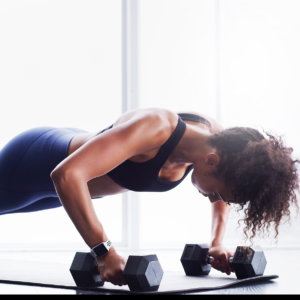
End 2023 with a giant exclamation point

Most powerful version of YOU
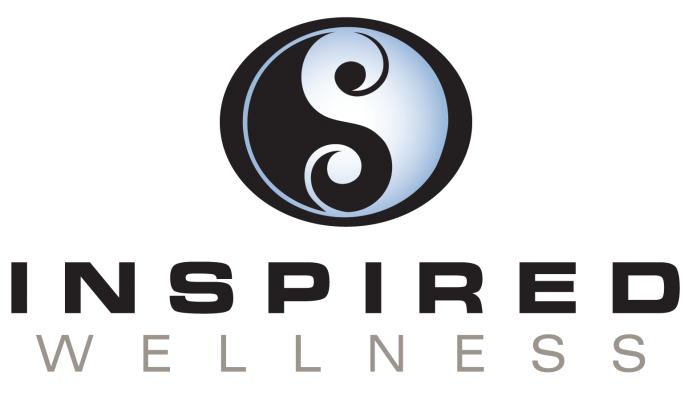
- (916) 235-3453
- [email protected]
- 2724 24th St STE 100, Sacramento, CA 95818, United States
Weekly Newsletter
The Ultimate Guide To Staying Motivated On Your Fitness Journey
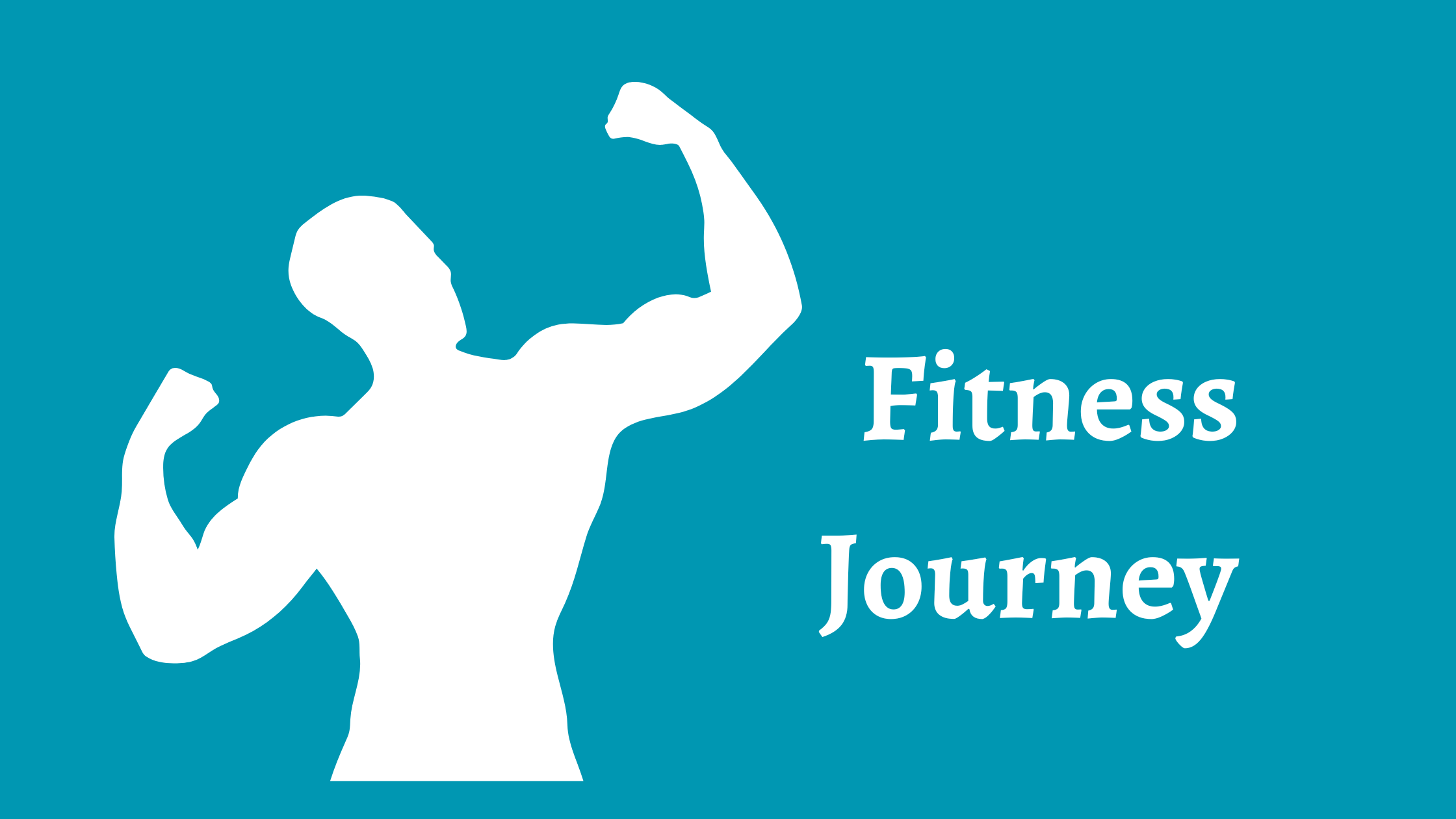
Embarking on a fitness journey is a transformative experience that promises a healthier, happier, and more vibrant version of yourself. However, staying motivated throughout this journey can often be a daunting task. There are days when fatigue sets in, self-doubt creeps in, and the allure of skipping a workout becomes tempting. Not to mention that distractions can come from anywhere that could disrupt you from resuming your daily fitness routine.
Thankfully, there are certain strategies and techniques you can do to keep your motivation soaring high and stick to your fitness journey. So, keep reading and get ready to unlock your full potential and discover the secrets to staying motivated as you embark on the transformative path toward a healthier and fitter you.
- Set Realistic Goals
One of the challenges of regular exercise is easily losing focus in such a short time. This can happen when you start a fitness routine without any goal in mind. Exercising without any objective can make it easy for you to lose focus since you don’t have any clear direction or purpose. It’ll also be harder for you to track your progress and see any results when you don’t have any goal.
Thus, before starting your fitness journey, ensure to set realistic goals first. Define both short-term and long-term objectives and break down your goals into smaller milestones. Furthermore, don’t forget to celebrate these smaller victories to keep you motivated and reinforce your progress. Remember, the success of your fitness routine is in the journey, not in the results.
- Find Your ‘Why’
Understanding your personal motivation is vital to sustaining your fitness journey. Reflect on why you started in the first place. Whether to improve your health, boost self-confidence, or enhance your overall well-being, remind yourself of these reasons regularly. Your ‘why’ will be a powerful driving force to keep you on track when motivation wanes.
- Create A Routine
Creating a routine is a powerful strategy that can significantly contribute to your motivation and success in achieving your fitness goals. The routine will provide structure, organization, and consistency, helping you overcome obstacles and stay focused on your fitness journey.
Create a regular workout schedule that syncs with your daily routine and ensure to stick to them. A routine teaches consistency, consistency breeds discipline, and discipline fuels motivation. Make exercise a non-negotiable part of daily life, like brushing your teeth. The more it becomes a practice, the easier it will be to stay motivated.
- Find Accountability
Some people find it hard to stay motivated in their fitness routine when they’re alone or don’t have anyone to share the goal with. To keep you focused and committed to your routine, you can enlist the support of a workout buddy or join a fitness community. Sharing your journey with others creates a sense of accountability and camaraderie.
Having someone to lean on during challenging times can also be incredibly motivating. Consider finding a workout partner, hiring a personal trainer, or joining fitness classes to stay connected and inspired.
- Embrace Variety
Sooner or later, your fitness routine can become monotonous, leading to a loss of motivation. Spice up your fitness routine by incorporating various exercises, like strength training, cardio, yoga, or outdoor activities. Exploring new workouts not only challenges your body but also keeps your mind engaged and excited about your fitness journey.
- Track Your Progress
Tracking your progress is crucial in staying motivated on your fitness journey. So, document your achievements, whether it’s inches lost, pounds shed, or strength gained, as these details provide tangible evidence of your hard work. You can use a fitness journal, mobile app, or wearable fitness tracker to monitor your progress, steps, and even heart rate with the new technologies like Fitbit HRV accuracy , these tools provide valuable insights into your fitness journey . Seeing how far you’ve come can reignite your motivation during challenging times.
- Reward Yourself
Celebrate your milestones and achievements with rewards. Treat yourself to something you enjoy, like a massage, a new workout outfit, or a day off from your regular routine. Rewards act as positive reinforcement, making your fitness journey more enjoyable and satisfying. However, do remember that rewards are a tool to motivate and celebrate your progress. They should be used strategically and in a way that supports your long-term goals. Avoid using ‘rewards’ as an excuse to return to your unhealthy habits.
- Practice Self-Care
Taking care of yourself holistically is essential for maintaining motivation. Prioritize rest, sleep, and proper nutrition. Treat yourself with kindness and listen to your body’s needs. Nurturing your physical and mental well-being will optimize your energy levels and overall motivation.
The Bottom Line
Staying motivated on your fitness journey is a lifelong process. By setting realistic goals, finding your why, establishing a routine, seeking accountability, embracing variety, tracking your progress, rewarding yourself, and practicing self-care, you’ll be equipped with the tools to maintain your motivation and achieve lasting success. Remember, the most important step is to start, and with unwavering motivation, you’ll soar to new heights on your fitness journey.
Leave a Comment Cancel reply
Save my name, email, and website in this browser for the next time I comment.
- Weight Management
- Nutrition Facts
- Nutrition Basics
- Meal Delivery Services
- Fitness Gear
- Apparel & Accessories
- Recipe Nutrition Calculator
- Weight Loss Calorie Goal
- BMI Calculator
- Body Fat Percentage Calculator
- Calories Burned by Activity
- Daily Calories Burned
- Pace Calculator
- Editorial Process
- Meet Our Review Board
6 Weeks to Fitness for Absolute Beginners
:max_bytes(150000):strip_icc():format(webp)/PaigeNew-594a893c3df78c537b843956.jpg)
Verywell / Ryan Kelly
Whether you've taken a long break from exercise or you're just getting started, this six-week program is the perfect place to begin. You'll establish an exercise routine with simple, straightforward workouts that progress from week to week.
The workouts provided are only suggestions and won't work for everyone. You can modify them as needed to fit your fitness level, schedule, and preferences.
Prepare for Your Workouts
Before you get started, there are a few key points to make sure you have addressed:
- Consult with your healthcare provider. You should always talk to your doctor before starting or intensifying a workout routine, especially if you have any injuries or health conditions.
- Gather your equipment . For the strength workouts, you'll need home workout equipment like dumbbells, an exercise ball, resistance bands , a medicine ball , and a mat. If you're new to strength training, make sure that you familiarize yourself with the basics and know how to choose the right weight.
- Record your vital statistics . This information will be especially important if you want to track weight loss progress.
- Prepare for your workouts . The cardio workouts are designed to be done on any cardio machine or outside. If machines aren't your thing, you can substitute your own workouts (videos, classes, outdoor exercise, etc.) or choose something else you enjoy.
Focus on Monitoring Intensity
Intensity is an important aspect of your cardio workouts. Monitoring intensity can help you learn how your body feels during different activities. You can monitor intensity in several ways, including:
- The Talk Test
- Monitoring Your Heart Rate
Your goal this week is to focus on the intensity of your workouts . During each cardio workout , use one of the methods above to track how you feel and match your Perceived Exertion to the suggested levels.
Most workouts will be at a moderate level , which means you'll be just out of your comfort zone but not huffing and puffing. Pay attention to how you do this week to get a sense of your exercise intensity.
Day 1: Cardio, Strength, and Stretch
These workouts are short and simple and should take you 35 to 45 minutes.
- Workout 1 : Beginner cardio — Length : 20 minutes
- Workout 2 : Basic strength — Equipment Required : Light dumbbells, an exercise ball , or chair and a mat— Length : 10 to 15 minutes
- Workout 3 : Soothing stretch
Day 2: Walking and Stretch
Today you don't have a structured workout schedule to follow, but a simple walking workout and a seated stretch to relax your shoulders, neck, and back.
- Workout 1 : Take a brisk 10-minute walk
- Workout 2 : Seated stretch
Day 3: Cardio, Strength, and Stretch
Today your schedule is the same as Day 1 but with a new cardio workout. Today you'll choose either a 13-minute walking workout or a 10-minute cycling workout, but feel free to combine the workouts if you want something longer.
- Workout 1 : Beginner walking or cycling — Length : 10 to 13 Minutes
- Workout 2 : Basic strength— Equipment Required : Light dumbbells, an exercise ball or chair, and a mat— Length : 10 to 15 minutes
Day 4: Active Rest
There's nothing on your schedule today, but try to stay active by taking breaks, walking, stretching, and moving. Here are a few ideas:
- Sit on an exercise ball while watching TV
- Take the stairs at least 3 times
- Use your lunch break to take a 10-minute walk
- Walk the dog for an extra 5 minutes
Day 5: Walking and Stretch
- Workout 2 : Seated stretch— Length : 5 to 10 minutes
Day 6: Cardio, Strength, and Stretch
- Workout 1 : Beginner cardio— Length : 20 Minutes
- Workout 3 : Basic stretch
Week 2 brings some small changes that will help you slowly progress. You'll have new, longer cardio workouts and you'll be doing an added set of each exercise during your strength training workouts.
You can modify the workouts to fit your fitness level, schedule, and goals. Listen to your body and take extra rest days as needed.
Focus on F.I.T.T.
- Frequency . This week, you'll be doing cardio 3 times and strength training 3 times, which follows the basic exercise guidelines for improving your health. You'll gradually add more frequent exercise as you progress through the program.
- Intensity. During the first few weeks, you'll focus on achieving moderate intensity—about a Level 5 to 6 on the Perceived Exertion Scale . As you progress through the program you will gradually change the intensity levels of your workouts with interval training and other techniques.
- Time . Your workouts started at about 10 to 20 minutes. Each week, you will gradually add time to your workouts to build endurance and help you burn more calories.
- Type . It's important to do activities you enjoy, but you also want to cross-train and mix things up to keep both your body and mind engaged. You'll choose new activities to add to your routine later in the program.
This week, your focus is on the F.I.T.T. principle, which guides us in setting up workout programs. This principle includes:
When you workout at a sufficient intensity, time, and frequency, you'll start to see changes in your weight, body fat, endurance, and strength. Once your body adjusts to your current FITT levels, you'll need to manipulate one or more of them—and this program will help you learn how to do that.
Your cardio workout this week builds on last week's basic workout by adding 5 minutes. Your strength workout is the same, but you'll do 2 sets of each exercise with a brief rest in between.
- Workout 1 : 25-minute cardio
- Workout 2 : Basic strength— Equipment Required: Light dumbbells, an exercise ball or chair, and a mat— Length : 2 sets of each exercise, 10 to 20 minutes
You'll do your walking workout with an added 5 minutes today and finish up with the seated stretch for the back, neck, and shoulders.
- Workout 1 : Take a brisk 15-minute walk
- Workout 2 : Seated stretch
Your new cardio workout involves interval training with any machine or activity of your choice.
- Workout 1 : Basic intervals — Length : 21 minutes
- Workout 2 : Basic strength— Equipment Required : Light dumbbells, an exercise ball or chair, and a mat— Length : 2 sets of each exercise, 10 to 20 minutes
There's nothing on your schedule today, but try to stay active by taking breaks, walking, stretching, and moving. Here are some ideas:
- Do crunches or pushups while you watch TV
- Play an active video game like the Wii Fit Plus
- Stretch for a few minutes before bed
- Workout 1 : 25-Minute cardio
- Workout 2 : Basic strength — Equipment Required : Light dumbbells, an exercise ball or chair, and a mat— Length : 2 sets of each exercise, 10 to 20 minutes
This week, you'll see some big changes in your schedule. You'll be upping the ante by splitting your cardio and strength workouts, giving you 3 days of cardio and 2 days of strength training.
By splitting your workouts, you can give more energy to each routine, which can help improve your performance and do more with your exercise time.
Focus on Tracking Progress
One of the most important things you'll do on your exercise journey is to track your progress. Knowing where you are and how you're improving is essential for staying motivated and knowing you're on the right track. Here are a few suggestions:
- Health improvements. Exercise can do more for you than just help you lose weight. It can also improve your health . You might sleep better, have more energy, or feel like your daily tasks are easier. Think about what you'd like to improve (e.g, being able to walk up the stairs at work without passing out, being able to play with your kids or grandkids without getting tired, etc.) and make a note of it in your weekly checklist. Each week, check to see how far you've come.
- Strength and endurance. It's motivating when you see and feel yourself getting stronger. Keeping track of how many sets, reps, and how much weight you're using each week can tell you if you're getting stronger. You might also notice exercises are getting easier.
- Weight loss. Weight loss is another common gauge of how you're doing with your workout, but remember that weight loss is often slower than you might expect and it can take weeks or months to see significant changes. Weighing yourself, taking your measurements , getting your body fat tested , and/or noticing how you look or how your clothes fit can help you keep track of your progress.
- Workouts completed. You might decide to focus less on the results and more on your fitness journey. Setting a goal to complete a certain number of workouts each week can help you stay focused on the process while celebrating your accomplishments.
Day 1: Cardio and Stretch
Today's cardio workout builds on previous workouts, taking you up to 30 minutes of continuous exercise.
- Workout 1 : 30-minute cardio
- Workout 2 : Stretch with bands
Day 2: Total Body Strength and Yoga
Today's strength training workout offers more exercises than previous workouts, which means more intensity and challenge. For this workout, you'll perform 2 sets of 15 reps of each exercise, resting 20 to 30 seconds between sets.
- Workout 1 : Total body strength — Equipment Required : Dumbbells, a barbell (substitute dumbbells if needed), a step or bench, an exercise ball, and a resistance band— Length : 2 sets of 15 reps, 30 to 45 minutes
- Workout 2 : 10-minute yoga (optional)
Day 3: Active Rest
There's nothing on your schedule today, but stay active by taking breaks, walking, stretching, and moving. Here are a few ideas:
- Walk around the house every time a commercial comes on during your favorite TV show
- Walk 2 laps around the parking lot at work before you start your day
- Wear a pedometer throughout the day and try to get at least 5,000 steps
Day 4: Interval Cardio and Stretch
Today's new interval workout increases your workout time to 25 minutes and it also takes you a little further out of your comfort zone.
- Workout 1 : Interval cardio — Length : 25 minutes
Day 5: Total Body Strength
- Workout 1 : Total body strength — Equipment Required : Dumbbells, a barbell (substitute dumbbells if needed), a step or weight bench, an exercise ball, and a resistance band— Length : 2 sets of 15 reps, 30 to 45 minutes
Day 6: Cardio and Stretch
You get a breather this week to take some time to settle into your new workout schedule. You'll do the same workouts as last week with no new routines, challenges, or changes.
Give yourself time to master the exercises, get into the habit of showing up for your workout, and reflect on how the routine is working for you.
Focus on Rewarding Yourself
Staying motivated to exercise isn't always easy, but rewarding yourself for accomplishing your goals can help. This week, your goal is to figure out how to reward yourself. Here are a few suggestions:
- Download new music
- Plan a future trip or adventure
- Schedule a massage, facial, or other spa treatment
- Spend some time doing your favorite activity
- Take some time to read a book, listen to music, or relax
How will you reward yourself this week? Plan it now so you can look forward to it all week long.
Day 1: Cardio and Stretch
Day 2: total body strength.
- Workout 1 : Total body strength — Equipment Required : Dumbbells, a barbell, a step or weight bench, an exercise ball, and a resistance band— Length : 2 sets of 15 reps, 30 to 45 minutes
Day 3: Active Rest
There's nothing on your schedule today, but you can stay active by:
- Declaring a "no TV" night and play games with your family
- Seeing how many activities you can do today without sitting down
- Sitting on an exercise ball while working on the computer
- Taking a 20-minute walk
Day 4: Interval Cardio and Stretch
- Workout 1 : Interval cardio
- Workout 2 : Stretch with bands
Day 5: Total Body Strength
- Workout 1 : Total body strength— Equipment Required : Dumbbells, a barbell, a step or weight bench, an exercise ball, and a resistance band— Length : 2 sets of 15 reps, 30 to 45 minutes
Day 6: Cardio and Stretch
- Workout 1 : 30-minute cardio
You're getting to the end of the program and, after last week's rest, you're increasing the challenge this week with brand new workouts and a bonus exercise day. You'll be exercising 6 days this week (though you can always take an extra rest day if you need it).
Focus on Stress Relief
This week, focus on your stress levels. Specifically, how stressed are you, and are your workouts helping relieve some of that stress? Whether you're doing intense cardio or a relaxing stretch, exercise may help relieve tension, improve your concentration, and give you the energy to accomplish more each day.
How do you feel after your workouts? Do you feel energized and ready to face the day? If so, you're on the right track. If you feel drained, that can be a sign that you're doing too much and may need more rest.
Day 1: Cardio Medley and Stretch
Today's cardio workout takes you through a 40-minute routine using a treadmill, elliptical trainer, and a stationary bike.
- Workout 1 : Cardio medley — Equipment Required : Treadmill, elliptical, and stationary bike (or any 3 cardio machines)
- Workout 2 : Basic stretch
Day 2: Total Body Supersets and Yoga
Today's strength workout takes you to the next level with new (and tougher) exercises and a brand new format that adds intensity and saves time.
- Workout 1 : Total body supersets — Level : Beginner/Intermediate— Equipment Required : Barbell (can sub dumbbells here if needed), various weighted dumbbells, a step or bench, and an exercise ball— Length : 40 to 60 minutes
- Workout 2 : Morning and evening yoga
There's nothing on your schedule today, but try to stay active as much as you can by taking breaks, walking, stretching, and moving.
Today you get a brand new interval cardio workout that involves both hills and sprints to push the intensity to a Level 8 on the Perceived Exertion Chart.
- Workout 1 : Interval cardio — Length : 30 minutes
- Workout 2 : Seated stretch
Day 5: Total Body Supersets
- Workout 1 : Total body supersets — Equipment Required : Various weighted dumbbells, a step or platform, barbells, and an exercise ball— Length : 40 to 60 minutes
Today's workout is simple and straightforward, moving between Level 5 and 6.
- Workout 1 : Cardio endurance Workout 2 : Stretch with bands
Day 7: Bonus Cardio
This week, you're increasing the challenge by adding a bonus cardio workout. Choose any activity and work at a steady, moderate pace for at least 20 minutes.
Congratulations for making it this far! It isn't easy to start an exercise program, and it's even harder to sustain it. You've done just that by sticking with the program.
You're wrapping up this week with the same schedule and workouts you followed last week.
Focus on What's Next
It's important to maintain the momentum you've worked so hard to create. One way to do that is by thinking about what's next. You can continue with the same routine or you can change up your workout or learn about exercise progression .
- Workout 1 : Cardio Medley— Equipment Required : Treadmill, elliptical and stationary bike (or any 3 cardio machines)— Length : 40 minutes
- Workout 2 : Basic stretch
Even though there's nothing specific planned today, get creative about finding ways to stay active throughout your day.
- Workout 1 : Interval cardio Workout 2 : Seated stretch
- Workout 1 : Total body supersets— Equipment Required : Dumbbells, a step, barbells, and an exercise ball— Length : 40 to 60 minutes
- Workout 1 : Cardio Endurance— Length : 35 minutes
- Workout 2 : Stretch with Bands
Stick with the same bonus cardio you did last week or choose something new.
Romero SA, Minson CT, Halliwill JR. The cardiovascular system after exercise . J Appl Physiol (1985) . 2017;122(4):925-932. doi:10.1152/japplphysiol.00802.2016
Spees CK, Scott JM, Taylor CA. Differences in amounts and types of physical activity by obesity status in US adults . Am J Health Behav . 2012;36(1):56-65.
Ruegsegger GN, Booth FW. Health benefits of exercise . Cold Spring Harb Perspect Med . 2018;8(7):a029694. doi:10.1101/cshperspect.a029694
Koliaki C, Spinos T, Spinou Μ, Brinia Μ-E, Mitsopoulou D, Katsilambros N. Defining the optimal dietary approach for safe, effective and sustainable weight loss in overweight and obese adults . Healthcare (Basel) . 2018;6(3):E73. doi:10.3390/healthcare6030073
Strohacker K, Galarraga O, Williams DM. The impact of incentives on exercise behavior: a systematic review of randomized controlled trials . Ann Behav Med . 2014;48(1):92-99. doi:10.1007/s12160-013-9577-4
Childs E, de Wit H. Regular exercise is associated with emotional resilience to acute stress in healthy adults . Front Physiol . 2014;5:161. doi:10.3389/fphys.2014.00161
By Paige Waehner, CPT Paige Waehner is a certified personal trainer, author of the "Guide to Become a Personal Trainer," and co-author of "The Buzz on Exercise & Fitness."
- Conditionally
- Newsletter Signup
18 Fitness Tips These Trainers Always Give Their Beginner Clients
By Alexa Tucker

If you're new to working out (or if you're just thinking about incorporating fitness into your life), first thing's first—congrats. Deciding to be more active is an incredible first step to cashing in all of the amazing benefits of exercise , from better moods to improved sleep to all-around higher confidence.
But once you've resolved to start working out , that's where things can get a little overwhelming. With all of the chatter about the magic workout to do or the perfect amount of time to spend in the gym, it's hard to know where to start. And if you're not clear about what you're doing (or why you're doing it), it can be easy to throw in the towel when things don't go as planned.
Let these 18 star trainers be your guide. They help clients progress from beginners to fitness fanatics all the time, so they know what it takes to set yourself up for success. And, hey, they were all once beginners, too. Here are the habits, strategies, and mindsets they swear by for people who are new to working out.
"The first step is truly taking the time to figure out your why, what, and how. The questions I ask my clients are: Why are you adding fitness and wellness into your life now? In what ways will your life be different when you have fitness in your life on a regular basis? And how are you going to include fitness into your lifestyle today, and this week? Once you know the why, what, and how, the mindset is 'just do it.' Nike got it right with that one." —Amelia DiDomenico, owner of Amrose Fitness Studio , @amrosefitness
"If you are just starting a new workout program, don't overcommit or over-perform! Try starting with three days a week, and schedule it into your week like a doctor's appointment. No need to take a full class—stay for 30 minutes, or try a short private training session or an at-home workout. You want to make sure you are working yourself into shape safely and effectively. Then, after week four, try adding another 30 minutes every other week. You'll be surprised how empowered you'll feel!" —Anna Kaiser, celebrity trainer and founder of AKT , @theannakaiser
"You are better off doing a 45-minute, moderate-intensity strength circuit three times per week than to do a two-hour, high-intensity workout six times a week, and then burning out in three weeks because it’s not sustainable. And remember that it takes time and consistency to build your body, but one workout can put you in a better mood. You leave it all in the gym: the annoying boss, the argument with your best friend, being stuck in traffic… It’s like you get to press reset." —Valerie Waters, celebrity trainer and creator of Valslides , @valeriewaters
"Motivation is what gets you started, but making things a habit is how you keep the longevity of an active lifestyle. Having friends, family, and coworkers that exercise with you can help you to persevere. Try to find workout buddies to do healthy things together. Also, what you do outside the gym will have a big influence on the workouts you do inside the gym—making positive changes in your nutrition, hydration, sleep, and stress levels will create big results." —Noam Tamir, founder of TS Fitness , @tsfitnessnyc
“My best advice for beginners is to find something you enjoy and focus on small, incremental progress each day. I believe that we get the best results from consistency, and in order to be consistent we need to enjoy the journey. That’s why I like to focus on small daily goals—small goals completed each day make for big progress over time and give us a sense of accomplishment daily.” —Milan Costich, celebrity trainer and owner and founder of PREVAIL Boxing , @milancostich
"Wearing old, broken-down shoes can negatively impact your joints and ligaments, especially if you're running, sprinting, or doing plyometrics. So selecting the correct shoes for your workout is important: For instance, tennis shoes are built for lateral movements. If you're lifting weights, you will want a harder, flatter bottom of your shoe so you feel more connected to the floor. And if you are a runner, most specialty running stores will give you a stride assessment to help decide what shoes are best for your arch, heel strike, and foot width. Invest in the shoe that can be as diverse as possible in the gym and outside, but gives you the correct support your foot needs." —Ashley Borden, celebrity trainer, @ashleybordenfitness
"Start slow, set realistic goals, be gentle with your body and take breaks as often as necessary. Making the commitment to begin a new workout is hard enough, so if you’re not honest about your physical fitness level and go too hard, you’re setting yourself up to potentially burn out or get injured, and that’s so far from the intended goal." —Lauren Kleban, celebrity trainer and creator of LEKfit , @lekfit
"Be patient with yourself—you will have setbacks, and every day will not be perfect. The key is to be persistent and keep moving forward. The only thing constant in life is change, so we should be prepared to make changes to be the best version of ourselves." —Latreal Mitchell, celebrity trainer and Previnex fitness ambassador, @latrealmitchell
"I always want my new clients to know that the journey they're about to embark upon tends to be the road less traveled. Those mental battles are hardest to deal with in the beginning stages so stay humble, stay committed, and know that the benefits far outweigh any difficulties. Wake up every day and remind yourself that self-care in all forms is the best decision you can make.” —Nick Malizia, master instructor at Burn 60 Studios , @burn60studios
“Warm-up before starting your routine—a proper warm-up [with dynamic stretching] is important to get the body ready for injury-free movement. Take time to stretch after your workout, and take rest days. There's plenty of time to build and progress. My other tips: Go into your new venture with a fun, can-do mentality. Set goals and reward yourself upon meeting them, like a massage, new gear, or a weekend away. Stay hydrated, and get yourself on a good nutrition plan—you need proper fuel in your body to succeed." —Julie Diamond, master instructor at Burn 60 Studios , @burn60studios
"Keep it basic, and don’t over-complicate your workouts. Too often people skip foundational exercises for workouts that look cool and are trendy. Mastering the basics truly takes time, so don’t rush through. A progressive basic workout program including exercises like squats, rows, lunges, and chest presses totally work and get great results." —Hannah Davis, founder of Body By Hannah , @bodybyhannah
"Be willing to look silly and make mistakes without judging yourself. Keep trying, and with every workout you’ll get better and better. Remember, the goal is progress, not perfection. And in a group environment, don’t compare yourself to anyone else in the room. While others may move seamlessly and appear to have superhuman strength, remember that they were once beginners too. Don’t compare your chapter one to someone else’s chapter eleven." —Franci Cohen, founder and CEO of Spiderbands , @francifit
“People come in with the expectation of long-term results happening fast, but people should look at fitness as a big picture and making exercise a part of their life routine, as opposed to an acute, momentary mindset. Also remember that working out is multi-faceted, and it's the combination of healthy eating and training together that creates the best results." —Jason Walsh, celebrity trainer and founder of Rise Nation , @risemovement
"Focus on the feels. Most fitness goals are long-term projects, but the one exception to this is how we feel, which can immediately and profoundly improve after a single workout. If you’re just starting out, tune into the positive vibes you feel after exercise and let that be your reward. Remember, even as a newbie, you’re only one workout away from a good mood." —Rob Sulaver, founding trainer at Rumble Boxing and Bandana Training , @bandanatraining
"I tell someone starting out to wear a heart rate monitor so they know how their body is responding to the physical stress of training. Workouts are much more fun if they make sense. That goes along with my motto: train smarter, not harder." Quick note: A heart rate monitor is a device you wear that tells you your heart’s beats per minute, so you can check it in real time during your workout. This gives you objective information about how hard your body is actually working, regardless of how hard you feel like you’re working, which is known as your rate of perceived exertion. How hard a workout feels can be influenced by factors like how much enjoy it, the temperature and humidity of the room you’re in, and more—but how you feel isn’t always entirely representative of how hard your body’s actually working. —Michelle Lovitt, celebrity trainer and founder of Lovitfitness , @mllovitt
"Set something other than an aesthetic goal. This can be a certain amount of weight you want to try to squat with, a distance you want to run, or maybe you just want to be able to do a push-up on your toes [instead of your knees]. The issue with aesthetic goals is that they're fleeting, and they won't keep you engaged enough to continue working during those tough times when you want to quit. There's no better feeling than accomplishing that goal. Trust me—that's how I got into fitness!" —Diana Mitrea, co-founder of Stronger With Time , @diana.fitness
"Make it easy for yourself not to find excuses. Lay your clothes out the night before or pack your bag. Sign up for classes or a trainer at the beginning of the week and put it in your calendar. Order your meals or meal prep or plan out your meals for the week, and make a list of go-to spots that have healthy food near your work, home, and gym. You could also sign up for a race—this gives you a specific training time frame. I know I can commit to things when there is a clear start and end date. It forces me to put in my best effort, and once I cross that finish line, I am overjoyed I accomplished it and ready for another challenge." —Rebecca Kennedy, founder of A.C.C.E.S.S. , @rksolidnyc
"Be grateful for where you are, right now, and have a clear picture of where you'd like to be. From there, take on a simple plan that aligns with your goals and doesn't bore you to death… and tackle it one step at a time. And remember to enjoy the process. Getting too caught up in where you want to be can rob you of your joy, today. And that just sucks. Happiness isn't something that should be reserved for some imagined future. Your body is an absolutely amazing thing. Take a few moments, every day, to appreciate that. Believe or not, that simple gratitude can help you create the strongest body of your life." —Adam Rosante, founder of Dollar Sweat Club , @adamrosante
- 9 Steps to Take If You Want to Start Working Out for the First Time
- Why Comparing Yourself to Others Won't Help You Meet Your Fitness Goals
- Why Some People, Like Brittany Snow, Can Naturally Build More Muscle

SELF does not provide medical advice, diagnosis, or treatment. Any information published on this website or by this brand is not intended as a substitute for medical advice, and you should not take any action before consulting with a healthcare professional.


How to Start Your Fitness Journey
We’ll start by admitting that starting anything new is hard. There’s a reason it’s so common for people to give up on their New Year’s resolutions by February—because building a new habit is an uphill battle from the start.
Exercising more is the most common New Year’s resolution , and it’s also the first one to go out the window.
If you’re reading this—whether it’s January or June—you probably don’t want that to be your story. And our goal is to set you up for success from the start.
This guide has plenty of tools, advice, and resources to help you begin a lifelong habit of exercising. New to fitness or new to actually understanding it, this is the knowledge you need to move forward.
How to Set Goals
Setting goals might sound like a simple thing, but it’s challenging to set realistic and motivating goals that keep you going. People tend to run into these common roadblocks when setting goals:
- You set goals that are completely out of reach . You’re not going to be able to go from zero to 10 pull-ups in your first month of exercising. That’s a fact. But many people set goals that are similarly unrealistic.
- You set goals you don’t really care about . All too often, we set goals for ourselves that are really being driven by someone else, whether that’s a family member, a coworker, or even the media. If your goal isn’t personally meaningful to you, you’ll have a hard time drumming up enough motivation to work on that goal.
- You set goals that are too vague to really be actionable . “Exercise more” is a really good example. What does that mean, exactly? How will you know if you’re making progress?
There are thousands of books about goal setting because this is universally challenging. With a good framework, though, you can learn to set goals that are both achievable and motivating. Let’s look at a few strategies to help you set meaningful goals.
Start With Why
There’s a great book by Simon Sinek called, Start with Why (you can also watch his TED Talk on the same topic if you’re short on time). It’s more geared toward entrepreneurs and business leaders, but his main idea is just as essential to setting goals with a new fitness program.
It’s all about taking a step back and defining why you’re doing this—beyond the vague “get in shape.”
What’s your real purpose in starting an exercise program?
For many people, it’s about getting overall healthier so they can be comfortable with their bodies or, thinking of longevity, being able to tackle a flight of stairs without thinking about it.
For others, it’s about reconnecting with an old athletic hobby that used to bring them a lot of joy. And for others still, it might be about getting past chronic pain they’ve lived with for years.
Choosing to start an exercise journey is hard, and you should be proud of yourself for even making that choice. When we make hard choices like that, there’s always a deeper reason for doing so, even if we don’t realize it right away.
If your goal is to lose 20 pounds, think through your personal “why” behind that goal. There’s no right or wrong answer, as we each have different things that are important to us. If your motivation is tangible and meaningful to you , that’s something you can keep coming back to, especially on those days when the last thing you want to do is exercise.
Many people skip this step when setting goals, but you’ll be glad you took the time to think through the deeper purpose driving you to put in this work.
Find What Motivates You
Knowing your “why” is a big part of staying motivated and setting goals accordingly. Another important piece is tapping in to what psychologists and social scientists refer to as intrinsic motivation and extrinsic motivation.
- Intrinsic motivation comes from the thing itself—in this case, exercise. People who like exercising or feel really good when they work out can draw on that intrinsic motivation.
- Extrinsic motivation comes from something external. That could be a reward of some kind—“If I do 20 workouts, I’ll buy a new pair of shoes”.
Research shows that these different kinds of motivation are pretty much equally effective . Just having a clear motivation is what makes the difference in success with achieving goals.
One theme that will come up throughout this guide is that the key to success is knowing what works for you. If a certain tool or approach works really well for your friend or colleague, that doesn’t mean it will work well for you.
So, if intrinsic motivation is an effective tool for you, then great. Let’s say you just feel better when you exercise—that doesn’t mean you’ll automatically have the motivation to exercise. You’ll need to remind yourself about how exercising makes you feel (and how not exercising makes you feel), and draw motivation from that.
Maybe you’re more motivated by extrinsic things, like rewards. You might print out a picture of the reward you want and hang it on your fridge or in front of the treadmill—whatever works.
Set SMART goals
This mnemonic device for goal setting is popular for a reason—because it works. SMART stands for:
- Specific . Make sure your goal is specific rather than being broad and vague. For example, instead of a goal of “get stronger,” a better goal might be to “build up the strength to do push-ups.”
- Measurable . Your goal should also be quantifiable so that you can track your progress. So, that might be: “build up the strength to do 10 consecutive push-ups.”
- Achievable . How realistic is this goal? If you’ve never done a push-up in your life, 10 push-ups might not be so achievable right now. Maybe that goal needs to be dropped down to five, or three, or even one.
- Relevant . This brings us back to your “why.” Is the goal you’re setting relevant to what’s most important to you? Let’s say your “why” is being able to stand up on a surfboard. Being able to do a push-up might be a great goal then, since that strength translates into being able to push yourself off the board and onto your feet.
- Timebound . Finally, setting time limits to any goal is a good idea so you can check in periodically. Though, It’s important to realize that progress is not linear, and time limits are usually pretty arbitrary. So, if you set a goal of “build up the strength to do one good push-up within two months,” just remember that you can adjust that time along the way.
This formula is not set in stone, but is a good framework for defining your goals, especially after you’ve gone through the work of figuring out the deeper purpose behind them.
Write it Down
This might be the most important step of all. You might dismiss this as unnecessary, but we recommend doing it anyway.
You might write this down in a journal, in a note on your phone, or on a scrap piece of paper you stick to your bathroom mirror. Whatever you do, jot down the answers to the following:
- What is my “why,” my deeper purpose for starting this exercise program?
- What works better for me, intrinsic motivation or extrinsic motivation? What, specifically, can I draw motivation from?
- How is my goal SMART?
Once you’ve answered these questions, you should wind up with a very clear and meaningful goal, like the one we identified in the previous section:
“I want to build up the strength to do one push-up within the next two months so that I can easily get up off the board when I learn to surf in California.”
Come back to this goal periodically to remind yourself about why you’re doing this and what you’re working toward. That way, you can assess whether you’re making progress toward that goal or if you need to adjust what you’re doing.
Creating Accountability
We’re all human. Sometimes, even motivational strategies, like reminding ourselves of our deeper purpose for exercising, just won’t cut it. When you can’t get yourself going, having someone else holding you to your commitment can be the kick you need to follow through. That’s why establishing a specific plan for accountability is big.
Accountability can come in different forms, and you may need to try a couple of strategies before you find what works for you. Here are some possibilities:
Find an Accountability Buddy
For many people, it can be really helpful to have a friend, coworker, or family member going through this process at the same time. That might mean someone who goes to the gym with you or a friend you exchange texts with on your planned workout days.
This helps in both directions. You know someone else is paying attention to whether or not you’re showing up, but you also have the motivation to help another person stay committed. It’s a win-win.
Try Group Training
Group training doesn’t work for everyone, but it’s an effective accountability and training tool for a growing number of exercisers. There are plenty of options for group training, including classes in your gym, a fitness studio, a local community center, or at the local park.
There are also new online group training options cropping up every day. You can find exercise classes covering a wide range of goals and approaches held over video platforms like Zoom or dedicated streaming services.
Training in a group is like having multiple accountability buddies. If you stop showing up, the teacher or other people in the class will likely notice your absence and can check in with you.
Additionally, if you find yourself paying for a gym membership to access classes, you’ll be more motivated to go and get your money’s worth.
There are hundreds, if not thousands, of apps on the market now to create accountability and help you build new habits, many of which are specifically for tracking exercise. You can set up reminders and notifications through any of these apps. Here are just a few that might help:
- Fitness tracker apps, like MyFitnessPal or Strava
- Productivity or habit-building apps, like Done
- Apps for specific training modalities, such as the Peloton app or the Nike Run Club app
Don’t underestimate the power of accountability. When we know someone else (even if that’s an app) is counting on us, we’re much more likely to keep showing up.
How to Choose a Program
You’ve set a clear goal, you know your deeper purpose for starting this journey, and you’ve got some accountability and motivation tools in place. All you’re missing now is a training program.
You have two primary options: w ork with a pre-existing program or build your own program.
In this section, we’ll cover the first option and give you some guidance on how to choose a pre-existing program. In the following section , we’ll go over how you can build your own program.
Choose Something You’ll Enjoy
Not everybody loves to sweat, but you don’t have to hate it, either.
Often, when people dismiss exercise out of hand, it’s because they see “exercise” as a pretty narrow thing. It’s lifting weights in the gym, or running on the treadmill, or doing squats. Maybe a dance or spin class.
It’s true—all of those things fall under the umbrella of exercise. But plenty of other things do, too.
Here is just a small sampling of different things you might try:
- Weightlifting
- Martial arts
- Rock climbing
- Bodyweight training
- Mountain biking
- Indoor cycling
- Circus arts
- Obstacle course training
- Ice skating
- Organized sports (like basketball, soccer, football, or hockey)
There are probably dozens more that could be added to that list, but this should give you an idea of just how many options are available to you.
“Exercise” is a broad term and, especially when you’re new to this, the most important thing is to start moving your body regularly. If you try to force yourself to do something you hate, you probably won’t be able to keep doing it consistently. You’re much better off choosing something you really enjoy and can look forward to doing at least a couple of times per week.
Different Types of Programs Available
Just like “exercise,” the term “program” can be pretty broad, too. There are programs available online, in books, streaming video, apps, as well as our own training plans .
If you decide to go with a more recreational activity, like swimming or martial arts, the club you join will likely have a suggested program you can follow to make sure you’re progressing as expected. That might be as simple as showing up to a certain number of classes per week, but it’s important to go into this with a plan.
Even for more solo activities, like hiking or walking, you can find programs online to help you work on your form or breathing, with recommendations on how to build up your endurance.
We’re big proponents of varied workout programs with a focus on bodyweight exercises and based on our experiences, these are the training programs we can recommend:
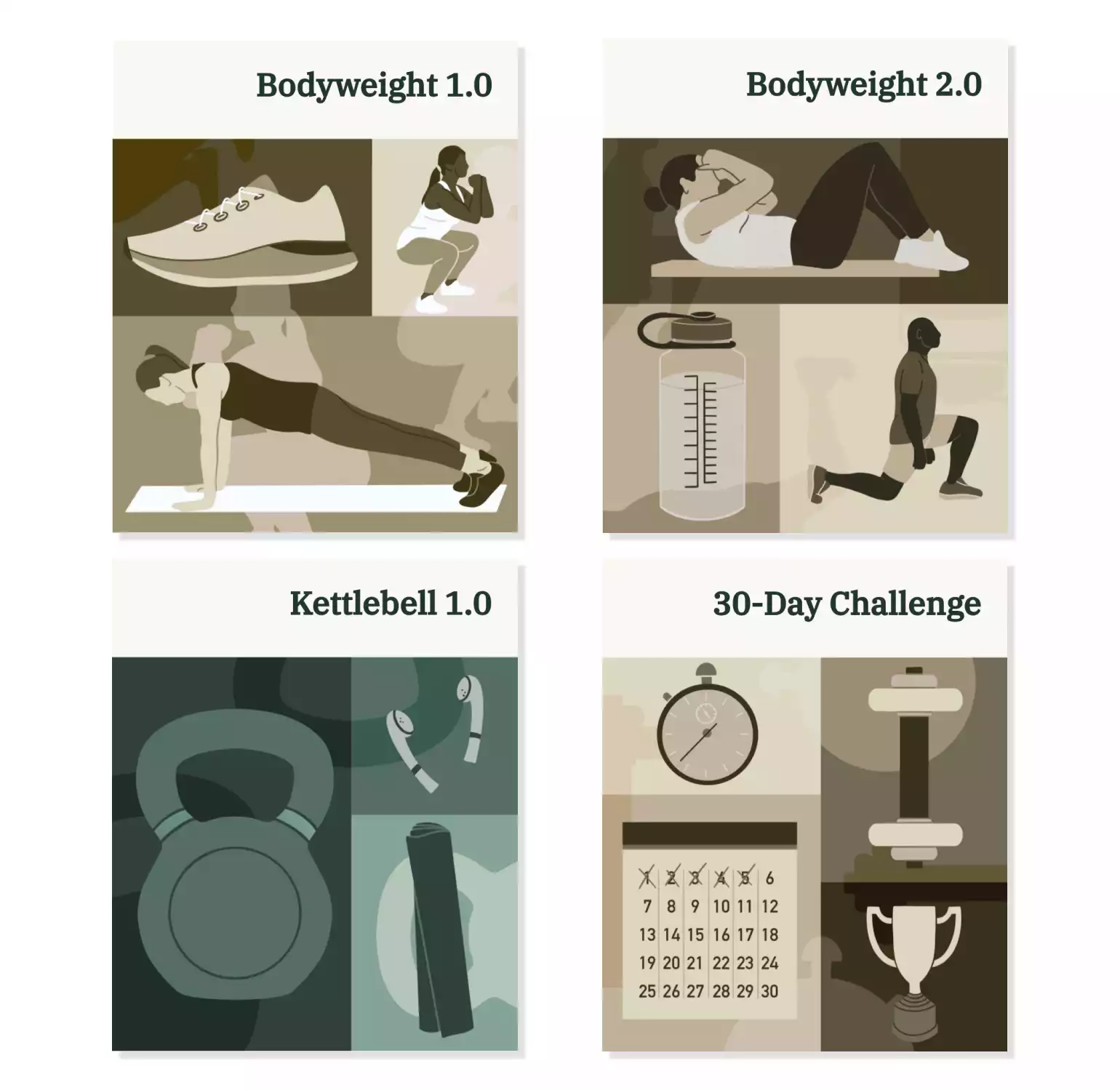
- Bodyweight 1.0
- Bodyweight 2.0
- Kettlebell 1.0
- 30-Day Challenge
- Bonus module: Intro to Nutrition and Healthy Eating
- Over 12 weeks of calisthenics workouts
- Beginner to intermediate levels
- Progressive calisthenics: Start with the basics and improve with time
Choose a Program Based on Your Goals
No matter what activity you choose as your primary mode of exercise, it’s important to pick a program that aligns with your goals. If your main goal is to work on your endurance so you don’t get winded as easily when hiking, a program that’s primarily focused on building muscle wouldn’t be as effective as an endurance program.
Some programs don’t really have a stated goal and are more focused on general fitness. That is okay too, but be careful not to choose something that’s too vague. Just like your goals should be specific and measurable, the goals of the program should be, too. Ideally, those goals will be pretty well aligned.
Make Sure the Program Matches Your Level
As a beginner, you’ll want to make sure you’re not biting off more than you can chew. A common mistake people make is buying the flashiest, most popular program on the market, only to find they can’t possibly keep up.
When choosing a program, look at the program’s expectations.
- Do many of the starting exercise variations look impossible to you?
- Does the program entail nonstop work at a relatively high level of intensity?
- Are there clear explanations for exercise technique, or does the program assume you already know what to do for basic exercises?
Be honest with yourself about where you’re starting from and evaluate the program accordingly. Don’t choose a program just because a friend raves about it—you may not be starting from the same place as them.
Building Your Own Training Program
You might decide to build your own exercise program instead of buying or using a ready-made one.
Maybe you have a specific goal that requires a more tailored approach. Or perhaps you’re looking to save money.
Whatever your reason, experimenting with making your own program is a great way to understand exercise methodology.
You can build a workout in many ways, but we’ll give you a framework for understanding which components are most important.
Minimum Effective Dose
The concept of “minimum effective dose” is uncomfortable for many people because it goes against what so many of us have been taught. It’s the direct opposite of “more is better.”
Rather than trying to do as much as you can before collapsing, this concept challenges you to do the least amount possible to see results. Before building an exercise program, try to adopt this mindset that you don’t need to do a lot to see results—especially as a beginner.
Start with less. You can always add more later if you are able to.
General Program Structure
With the “less is more” mindset, you’ll be able to build a healthy and sustainable exercise program. From here, there are four components you’ll need to decide on:
This is what type of exercise you’ll be doing. As we discussed in the section on choosing a program , you can really choose anything. As long as you’re moving your body and the type of exercise you’re doing supports your goals, everything else is a personal choice.
We recommend, of course, choosing a mode of exercise you enjoy. If it feels like a chore every time you do it, you’re just not as likely to keep showing up.
You’ll need to decide in advance how often you want to work out. We recommend three to five times per week, but this is ultimately going to depend on your lifestyle and preferences.
If you have commitments like a rigorous job or small children at home, it might be more realistic to start with fewer dedicated workouts each week. Or, you might find you’re more consistent in your training when you work it into your schedule more often.
Think about your life realistically, and plan on a frequency that you can stick to. This allows you to get a baseline, which you can always adjust or build upon as you progress.
Here’s where you’ll decide how intensely you want to be working. There are objective and subjective ways of determining intensity.
Objective measures include things like setting a target heart rate, speed on a treadmill, or revolutions per minute (RPM) on a bike.
There are various scales for subjective measurements of intensity, but a good one is the ratings of perceived exertion (RPE) scale:
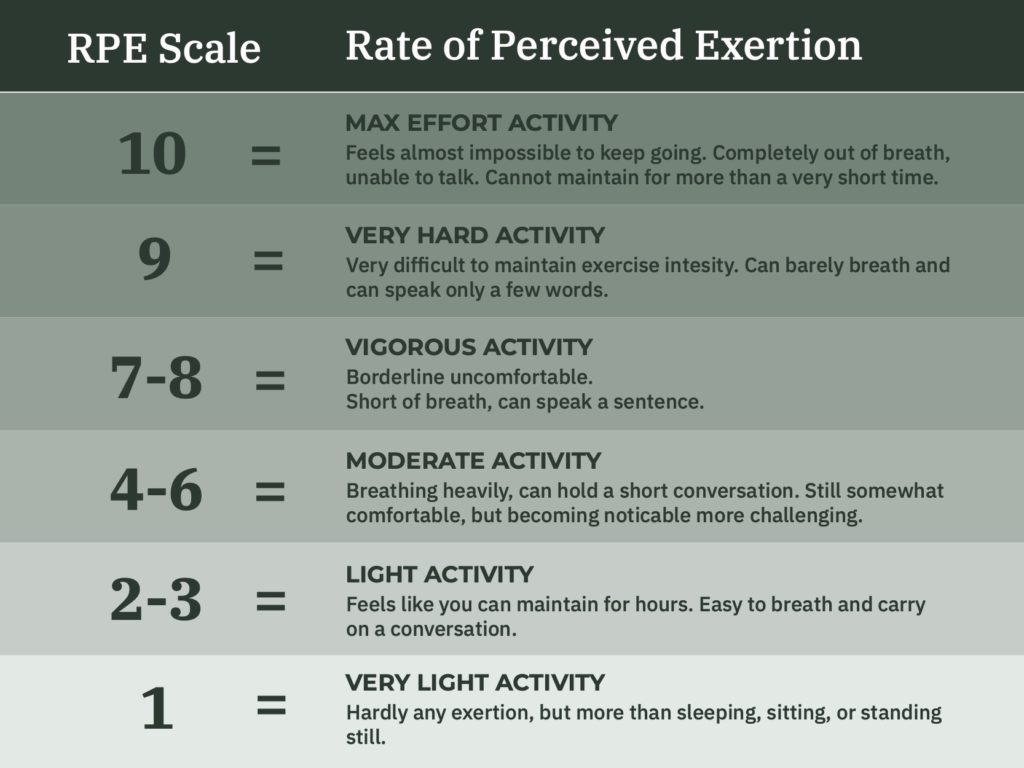
You may want to create your program with a mix of higher- and lower-intensity activity. It’s not a good idea to be at a 9 or 10 on the RPE scale with every single workout (most people really don’t need to go above a 7/8 ever).
This last component defines how long your sessions will be. It doesn’t have to be the same every time, and it’s important to build some flexibility into your planning since life is rarely predictable and steady.
With that said, try to think about what would be an ideal amount of time to spend on a workout session.
If you’re one of those people who has a lot of internal motivation for exercising and you just love working out, you might relish an hour-long exercise session. For the rest of us, remember it’s about quality over quantity. If you only have 20 minutes you can devote to a workout, then plan for that. Whatever’s realistic.
Creating a Workout for Different Goals
If you choose a less traditional form of exercise (say, dance or swimming), you’ll still want to think about frequency, intensity, and duration, but you may be better off turning to experts on the particular activity for help building a training program.
With more traditional forms of exercise (like bodyweight training or weightlifting), it’s a bit simpler to provide guidance on building workouts.
In general, here’s what we recommend depending on your goal:
- Building strength : use a relatively harder variation of a given exercise for 2–4 sets of 4–6 repetitions per exercise.
- Hypertrophy (building muscle) : work with a relatively easier variation that you can do for 2–4 sets of 8–12 repetitions per exercise.
- Building endurance : choose an even easier variation that you can do for 2–4 sets of 12–20 repetitions per exercise .
To gauge the difficulty of an exercise variation, you’ll want to pick a variation where you can do the recommended number of repetitions while keeping a couple of reps in the tank.
So, for example, if you’re working on squats with a goal of building strength, you’ll want to pick a variation of the squat where the absolute maximum you can do is eight reps, but you’ll stop at six. That way, you always stay fresh and can make sure to do each exercise with proper and safe form.
Going From Zero to Advanced Exerciser
How do you progress from absolutely zero knowledge all the way to an advanced exerciser? We’ll show you. Understand, though, that progress is rarely linear.
These benchmarks will give you some general guidelines for navigating through different stages of training. Along the way, though, you might advance more quickly in one area than in another. Or, you might move backward in certain areas at different points in time. That’s okay.
As you’ll see, the key to becoming a lifelong exerciser is to be as consistent as possible in your efforts, and that’s true no matter what stage you’re starting from. We’ll look at four levels:
- Intermediate
Starting From Zero
There are many people starting an exercise program who need to take a step back from even beginner-level exercises.
It’s possible you’ve gone years without moving your body in a purposeful way.
There’s no judgment or shame in being honest with yourself about your level of activity. It’s important to know where you’re starting from so that you can take this important step in an enjoyable and sustainable way.
If you’re starting from this place of zero activity, what can you do to get yourself to beginner level? Start with gentle movements, like:
- Easy hikes in nature
- Basic bodyweight movements like marching in place or squatting while holding onto a support.
The most important thing at this stage is creating a consistent habit. Don’t worry too much about achieving lofty goals. Your only real goal should be to make movement a regular part of your life—something you do every day for at least a few minutes.
At this early stage in your journey, one of the best things you can do is start a consistent walking program—some of the most successful and sustainable exercise programs are based on walking alone.
Start with a walk around the block every day, then build up to a mile or two per day. This might not sound like a lot, but it can be quite challenging if you’re starting from zero. And making this a part of your daily routine will help you stay consistent with more advanced training as you improve.
Progressing to Beginner Level
Once you’re moving more regularly and are comfortable with basic movements and stretches, you can start working on beginner-level exercises. Here are some ways you can bump up your level of intensity:
- Increase your distance on your walking program, or begin speed walking or jogging.
- Start doing hikes at a moderate level of intensity.
- Make your stretching more dynamic by including yoga fundamentals.
- Try some standard bodyweight exercises, like beginner variations of push-ups or squats. (See our Bodyweight Training Guide for detailed beginner-friendly exercises.)
At this level, it’s important to go back to the goal-setting exercises from earlier. Setting clear goals will help you maintain the consistency you’ve been building. Staying consistent at every level is the necessary ingredient for making this a lifelong endeavor.
Moving up to Intermediate Level
You’ve been at this for a while now. You’re comfortable doing beginner-level progressions of bodyweight exercises like push-ups, squats, and deadlifts. You’re stretching regularly, and you’re on a consistent walking or jogging program. You’re doing activities you love (or have learned to love), so you’ve successfully made exercise a sustainable habit. This is a part of your life now.
At the intermediate level, you can start to:
- Add sprints or intervals into your jogging sessions.
- Do more advanced bodyweight exercise variations.
- Incorporate some weighted strength training with barbells or kettlebells. (See our Strength Training Guide for detailed strength-based exercises.)
As you progress, revisit your goals as necessary—what motivated you at level zero isn’t necessarily going to motivate you now.
Becoming an Advanced Exerciser
This is the goal for many people—to achieve an advanced level of skill and ability. It’s not the right goal for everyone, though. You have to know yourself and understand what’s a realistic, motivating, and healthy goalpost for you.
If you do decide you want to achieve this level of exercise, here’s what that might look like:
- Add hill sprints into your running sessions.
- Do high-intensity interval training (HIIT).
- Use heavier kettlebells or barbells, or practice more technically advanced exercises (such as the Turkish get-up).
- Work on advanced bodyweight exercises like handstands, pull-ups, and gymnastic ring exercises.
The sky’s the limit with what you can work on when you reach a certain level of skill and ability with your exercise. Just pay attention to the following:
- Are you able to maintain your consistency when working at such a high level?
- How does your body feel? If you’re getting injured all the time doing advanced exercises, that’s not going to be sustainable.
- Is this advanced level of work having any impact (positive or negative) on your mental health?
There isn’t a right or wrong answer to any of these questions. It’s important, though, to pay attention to these things, especially as you keep advancing.
Managing Plateaus or Setbacks
There’s something magical about those early days of a new exercise program. You feel excited about the work you’re putting in, and you see consistent results adding up with almost every workout session.
…until you don’t.
After a few weeks or a few months, you hit a wall. It gets harder to muster up excitement for your training sessions, even when you use all the techniques we’ve described throughout this guide. What now?
Don’t Panic and Don’t Give Up
When you hit a plateau like that, it can be tempting to lean into one of two feelings:
- Panic. This is never going to work!
- Resignation. I’m just going to quit while I’m ahead.
We’ve all been there, so we get it. Let’s take a step back to set some realistic expectations.
Reality check #1: Plateaus are inevitable.
No matter your experience level or the amount of effort you’ve put into setting yourself up for success, you’ll likely come across plateaus or setbacks at some point.
Our bodies and minds adapt quickly, especially when starting something new, so when it’s not so new anymore, you’re not as likely to see the same results consistently.
That’s okay. Actually, it’s a good thing. Hitting plateaus means you’re putting in consistent effort.
Reality check #2: Setbacks are unavoidable.
Setbacks can happen for all sorts of reasons—injury, depression, vacation, new job, pandemic, etc. The key is knowing that when a setback happens, it doesn’t have to mean the end of all your progress.
With these realistic expectations in mind, we can go over some strategies for managing setbacks and plateaus when they happen.
How to Manage a Plateau
A plateau is usually seen as a bad thing in the context of an exercise program. It’s when you hit a period of little to no progress and things stay pretty flat for a while.
Here are two main ways to deal with a plateau:
Ride it out
Sometimes, the best way to deal with a plateau is to embrace it and ride it out. It’s unlikely that you’ll be stuck at that same plateau for very long. Often, if you lean into the plateau and just keep showing up, you’ll find yourself on the other side of that plateau within a couple of weeks. If a month or so goes by and you’re still in the same spot, though, it’s probably time to go into troubleshooting mode.
Troubleshoot
Switching things up may mean changing your program entirely or adjusting specific aspects of your program. Go back to the four components of your program we discussed earlier: mode, frequency, intensity, and duration.
Perhaps you need to try a different mode of exercise for a change, or it could be that your body needs a rest in which case you might cut back on intensity or frequency temporarily.
It may take some trial and error to see if changing one or more of these components gets you back on track.
Getting Back on Track Right Away
When you hit a setback and miss a planned session, it can be tempting to go into all-or-nothing mode.
James Clear, who’s a master at habit-building, talks about the importance of “avoiding the second mistake.” Or, as we like to say: Don’t miss twice.
Just because you missed one workout doesn’t mean all of your efforts at exercising should go out the window. Consistent work is the most important thing in building this lifelong habit, and means showing up next time, even if you couldn’t get yourself to the gym this time.
Go back to square one and figure out what changes you need to make to your routine so that you have the best chance of showing up to your next session.
Making This a Lifelong Journey
So, how can you sustain this new exercise journey for the rest of your life? It comes down to three things:
- Staying consistent
- Engaging in self-reflection
- Expecting nonlinear progress
Consistency is Key
Showing up consistently is far more important than all the other details of your exercise program.
It’s more important than what type of exercise you do, how intensely you work out, or even how frequently you exercise. Find something you enjoy and just keep showing up. That’s what creates a sustainable habit.
People overestimate what they can do in an hour and underestimate what they can accomplish in a decade. We think that if we work as hard as possible in an hour-long workout, we should see results right away. When that doesn’t happen, we’re disappointed and may be tempted to give up.
But any accomplishment takes time, and exercise is no different. Even when you’re just getting started, remember that this is a lifelong journey and results accumulate over time.
Your “Why” Will Change
As you get older and have different life experiences, your “why” is going to change. Very few people have the same motivating factors at 20 as they do at 40.
What’s important, then, is continuing to be self-reflective.
Revisit the exercises from the beginning of this guide periodically to make sure you’re clear on what’s most important to you. We recommend going through those exercises at least once a year, reminding yourself of your “why” throughout the year.
Progress Isn’t Linear
You’re going to face ups and downs in your exercise journey, and there will be times when you feel like you’re not making any progress at all—or worse, like you’ve gone backward. You haven’t. Just keep showing up consistently and it will lead to progress.
One year from now, you can look back and know that you’ve made progress because you started this journey—and starting is half the battle.
If you have started and are ready to move forward, check out our guides and training plans to see if there’s a good fit for you.
Other Guides
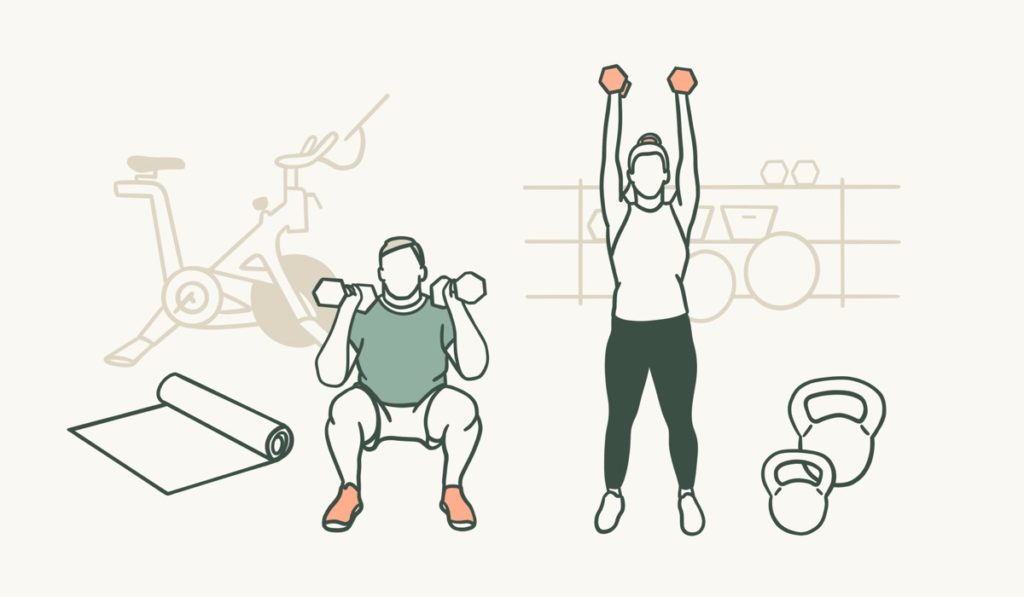
Intro to Strength Training


Intro to Nutrition & Healthy Eating

The Paleo Diet Explained
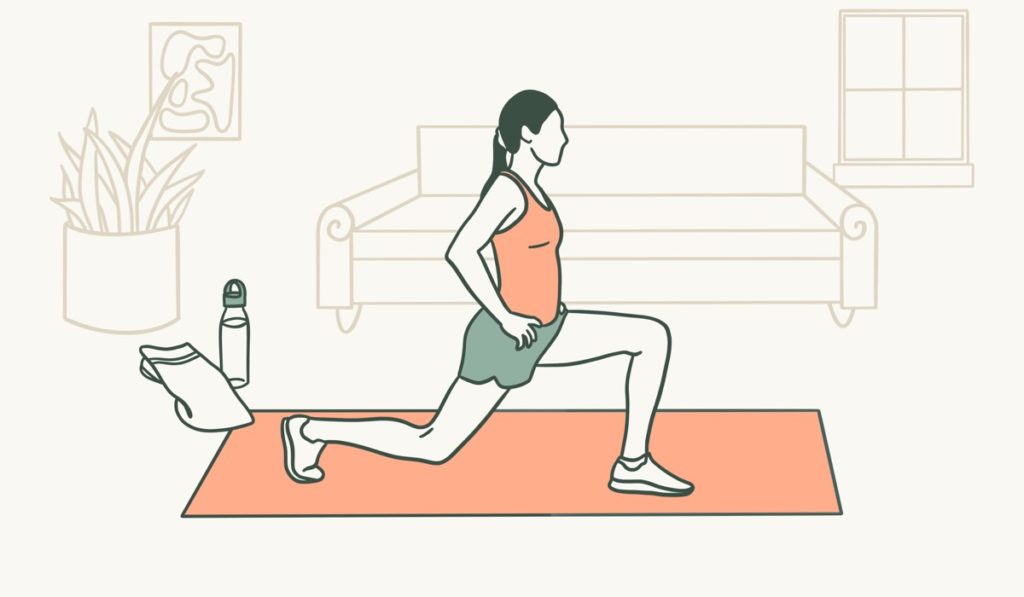
Guide to Bodyweight Training
Sign up to receive a free workout every Wednesday!!

If you’re willing to put in the work, we’ll provide the resources to help propel you forward.
TOP CATEGORIES
TheHybridAthlete.com does not intend to provide medical advice. We go to great lengths to help our readers better understand their bodies and their health; however, the content on this website is not a substitute for medical guidance. For more information, please read our privacy policy .
© 2022 All Rights Reserved
Affiliate programs.
TheHybridAthlete.com is a participant in the Amazon Services LLC Associates Program, an affiliate advertising program designed to provide a means for sites to earn advertising fees by advertising and linking to Amazon.com. *Amazon and the Amazon logo are trademarks of Amazon.com, Inc., or its affiliates. Additionally, TheHybridAthlete.com participates in various other affiliate programs, and we sometimes get a commission through purchases made through our links.
16 Clever Ways to Boost Workout Motivation, According to Trainers
These pro tips will help you get moving.

While getting into a regular workout routine can be tough—it’s not impossible. Once you form the habit and start feeling stronger, you’ll find yourself really looking forward to moving your body. The hardest part, of course, is just getting started.
If you need a little inspiration or motivation to embark on your fitness journey, try these 16 tips and tricks from certified personal trainers and group fitness instructors to help you achieve your goals.
Find something you enjoy

If you find an activity you enjoy doing, you”ll start to look forward to your workouts more, Katelyn Hissong , a Pilates instructor and the founder of the Elevate with Kate app, explains. “That could be a walk in the park, a hot yoga class, or a sport like tennis. When you find and do what you love, you’ll naturally keep gravitating back towards it,” she says. Makena Rae Diehl, Equinox group fitness instructor, agrees. “Discovering a workout routine that brings you joy is key to maintaining consistency and staying committed to your fitness journey, especially on those days when the motivation is low,” she shares.
Reward yourself

Sometimes all you need is a little incentive. Fitness trainer Stephanie Butterfield, CEO and founder of Activate House , suggests treating yourself when you reach certain milestones or stick to your workout routine. “These rewards don’t have to be extravagant. They can be as simple as a relaxing bath, a favorite healthy treat , or even a guilt-free Netflix binge. Connecting positive experiences with your fitness journey reinforces the idea that exercise is a rewarding and enjoyable part of your lifestyle,” Butterfield adds.
Make it social

“Meet up with a friend at your workout class, or add in additional cardio with a walk or hike to really chat and catch up,” suggests certified trainer and Pilates instructor Dylan Davies, co-founder of LIFT Society . “Creating a social schedule around your workouts versus food and alcohol is a fantastic healthy alternative.” Having some banter and company as you get through a tough workout makes the whole thing so much more fun.
Invest in yourself and classes
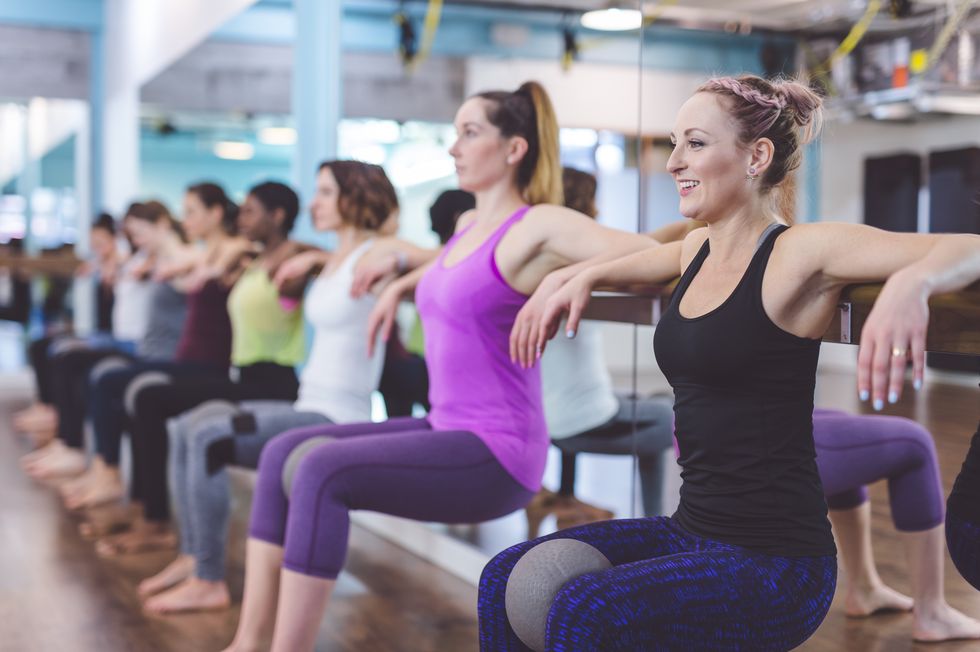
If you pay for a class or even a session with a trainer, you’re going to want to show up. “When you’re spending your own money, it’s that much harder to avoid working out,” says AJ Mason, an ACE-certified trainer at Studio SWEAT onDemand . “Invest in tried-and-true classes like spinning, yoga, boot camp, or barre, where you can get the most bang for your buck. Trust me, there’s no better workout motivation than knowing you’ve got an entire class and dedicated trainers expecting you there!”
Grab a workout buddy

Finding a workout buddy can make all of the difference when it comes to motivation. “Having someone there with you not only keeps you accountable, but it’s more fun, too. Plus, studies have shown that working out with someone who motivates you can increase your performance by up to 200%,” says Mason. “Try creating goals with friends that you can work on reaching together and make a scheduled weekly gym date so you both stay on track.”
Switch up your workout routine

“Repetitive workouts can quickly become monotonous, leading to a loss of motivation,” notes Butterfield. To keep things fresh and exciting, she suggests incorporating variety into your routine. “Try new classes, explore different forms of exercise, or even take your workout outdoors. Keeping your body guessing not only yields better results but also keeps you mentally engaged and eager to see what’s next.”
Start Small
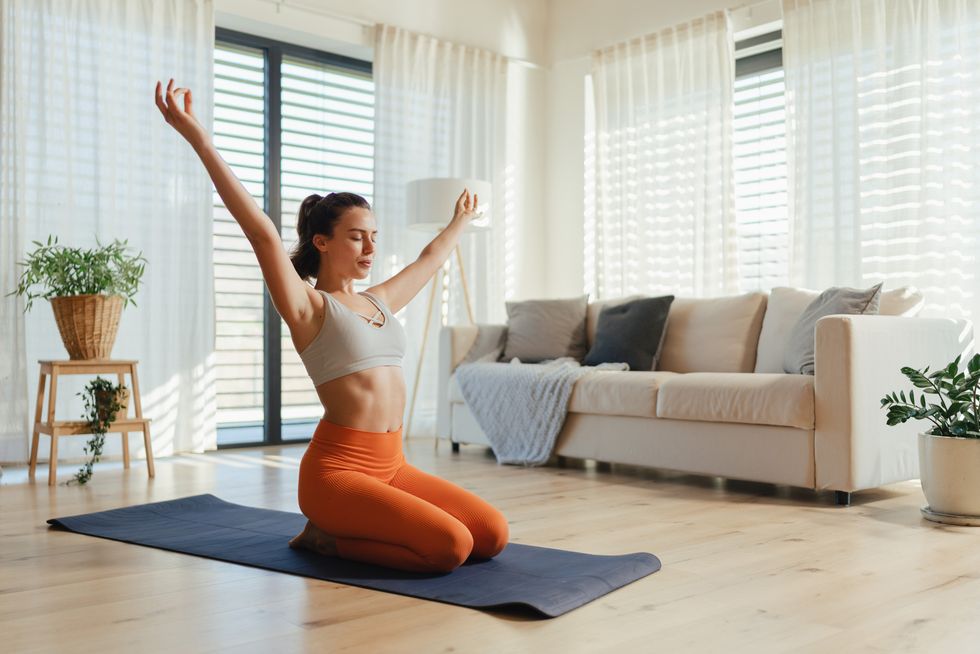
Baby steps are key. If exercise is new to you, Maeve McEwen , the director of programming and head trainer at Pvolve , recommends committing to just ten minutes of working out a day, a few times a week. This way, you’re not overwhelmed. “This may mean running on a treadmill, lifting weights, or just standing up and doing a few stretches,” she says. “Simply moving your body boosts endorphins , [increases] blood flow, and can improve mood.”
Redefine what “exercise” means to you

“Find ways outside of going to the gym or following a workout program to move your body,” says McEwen. Incorporating more activity into your everyday routine with some creativity will leave you feeling great. “Try walking instead of driving, taking the stairs instead of the elevator, or encouraging others to walk with you on a work break.”
Put it on the calendar

To enhance consistency, Diehl advises treating your workouts as non-negotiable appointments in your daily schedule, akin to a work meeting. “Over time, this mindset shift transforms the question from whether you’ll exercise today to when you’ll prioritize your physical well-being. Making these adjustments transforms exercise from a task to an integral part of your routine, promoting a healthier and more sustainable lifestyle,” Diehl notes.
Create a dynamic workout playlist
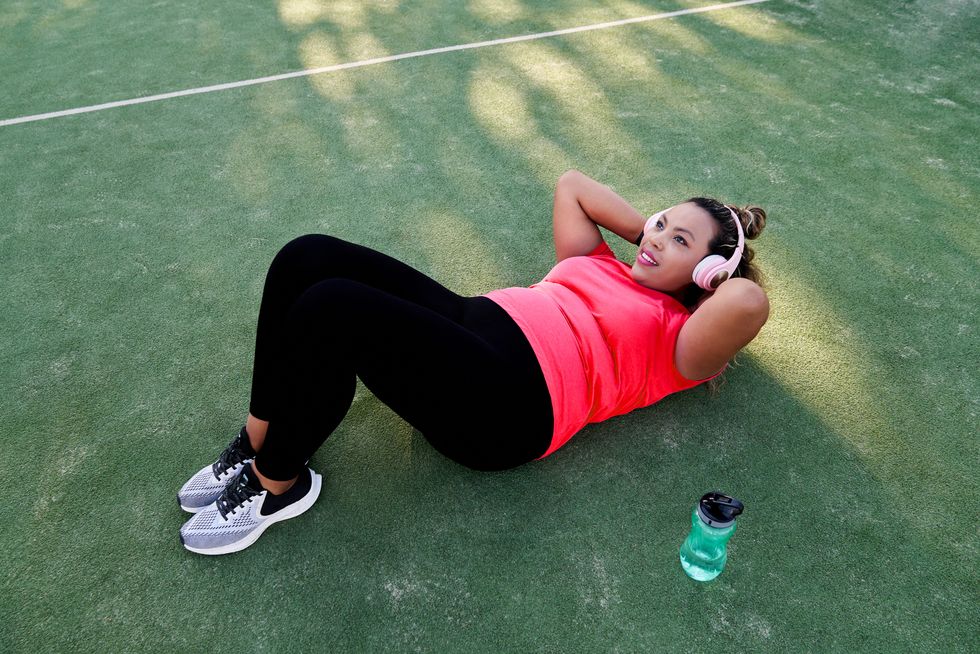
Everything’s better with a little music, and according to Butterfield, playing some tunes has an incredible impact on our mood and motivation. “Craft a playlist that resonates with your energy and the type of workout you’re planning. Upbeat tunes with a rhythm that matches your pace can turn a mundane session into an exhilarating experience.” She encourages people to explore different genres and build playlists that speak to their personal preferences.
Prepare for success
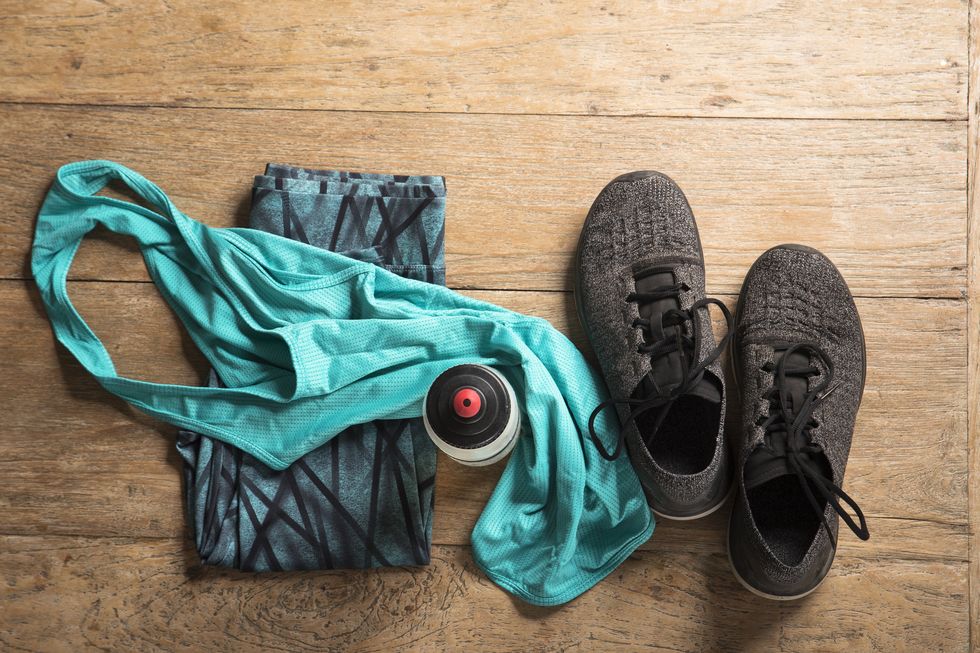
Planning ahead will make working out so much easier, according to Xavier Munden, personal trainer, exercise physiologist, and the CEO of Xtreme Fitness Solutions . “What are you going to listen to? Do you have your earbuds ? Do you have something to drink?” Being overly prepared—even picking out your clothes in advance—can be the extra motivation that gets you out that door.
Dress for success
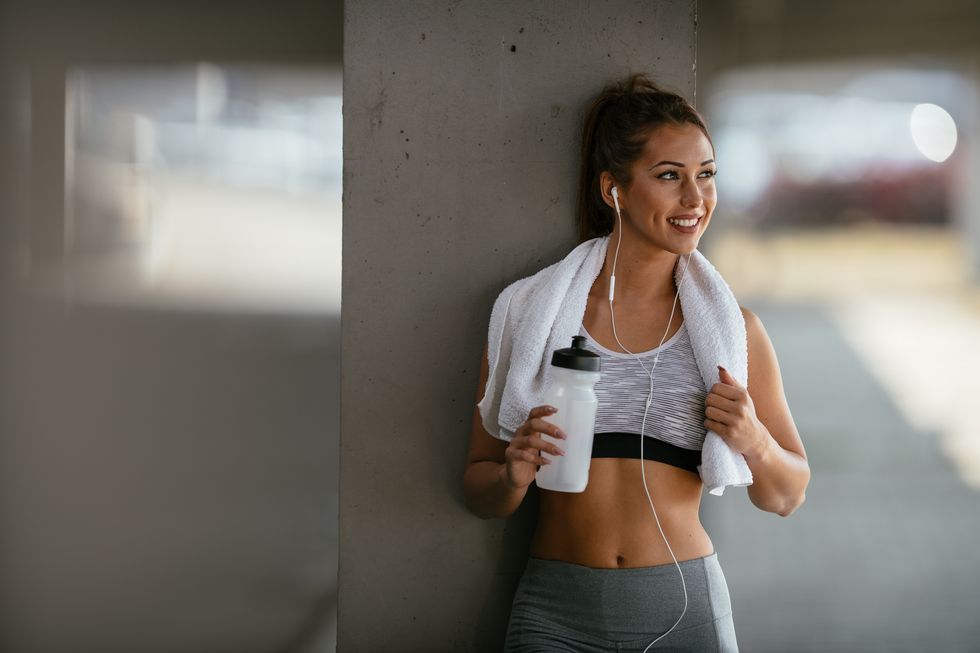
If a cute new workout outfit or brand new pair of running shoes motivates you, go for it! “How many times have you had a first date or a job interview and you wanted to put your best foot forward?” asks Munden. “Look at your gym appointment as the best first date you should keep with yourself, for yourself.”
Touch the Machines
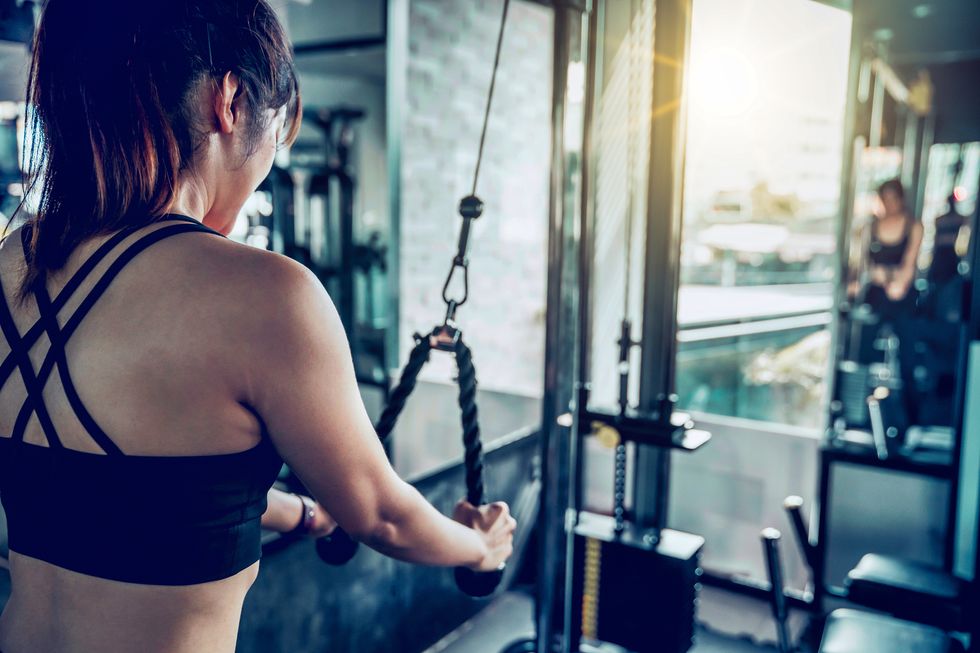
“Get up out of bed or push away from your desk. Walk or drive to your fitness center, walk in, touch a machine, and leave,” says Munden. It may sound silly, but this simple first step can help motivate you to work out, especially if the task of going to the gym feels insurmountable. “It’s about creating a habit, a lifestyle change. Your workout journey is about self care and keeping a promise to you, for you. We want to develop positive habits, and getting there is half the journey,” he notes. “Who knows, while you’re there, you may even work out a little bit.”
Pair exercise with something fun

Personal trainer Vincent Celeiro , suggests planning a fun activity before or after your sweat session. “Something that sparks your joy so that you can look forward to it! Go out to lunch, treat yourself to some retail therapy, or culture yourself and go see a Broadway show!”
Track your progress

“Wearable fitness trackers are a fantastic way to track your workouts,” says De La Haymon Holly , assistant fitness manager and certified personal trainer at Bay Club . “Some have features that allow you to receive notifications whenever you or your friend completes a workout. They also allow you to set up friendly competitions with each other to make it more fun.”
Set a specific timed goal
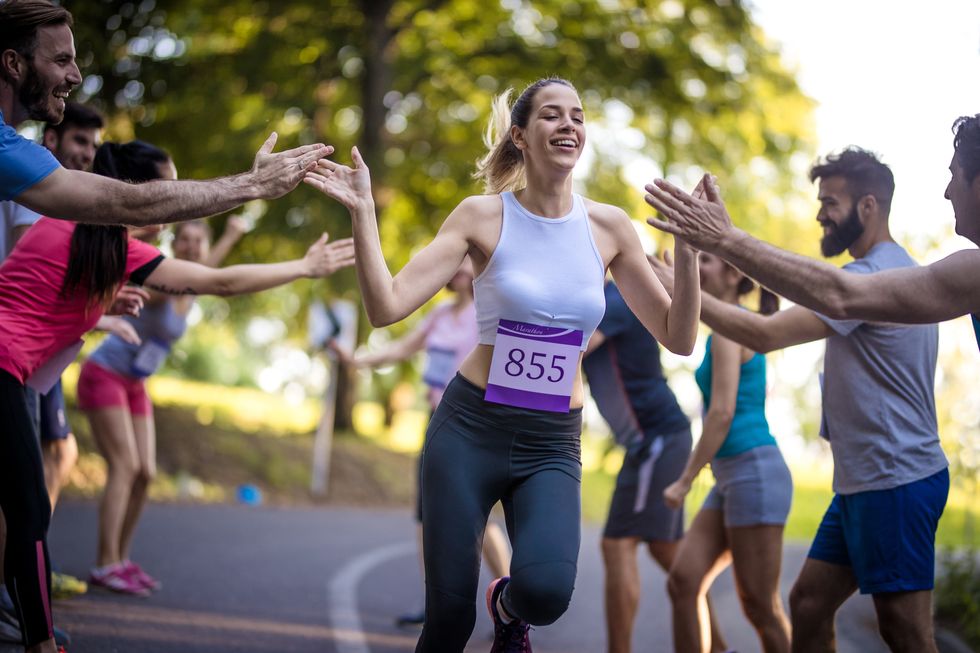
Oliver Nam, a personal trainer and owner of Thrive Training in Orange County, CA, suggests being super specific with your goals. “Use SMART: Specific, Measurable, Attainable, Relevant, and Timely goals,” Nam explains. “If you can become as detailed as possible, with a deadline, you have something to shoot for rather than an ambiguous thing.” This could mean signing up for your first 5K or half marathon , which will give you a great crash course in sticking to a workout routine as you prepare.

Fitness Tips

Denise Austin’s Tips for Staying Motivated to Move

How Exactly to Lose Arm Fat

A Fit Family's Guide to Disney World

Eva Longoria Shows Toned Legs in High-Slit Gown
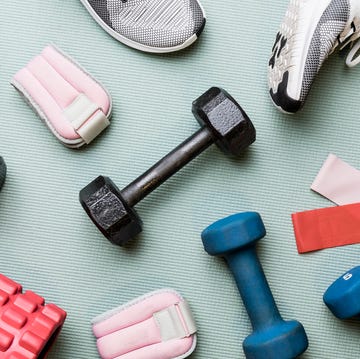
A Guide to the Benefits of Compression Recovery

The Best Shoes for Comfy Winter Walking
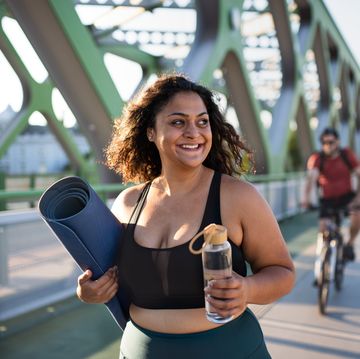
How Many Calories Does Walking Burn?
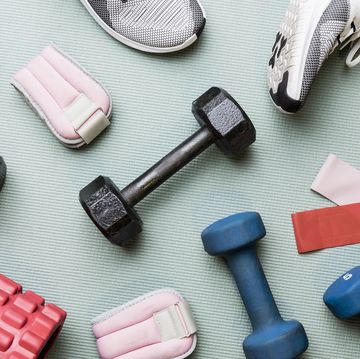
How to Get a Workout in While Traveling
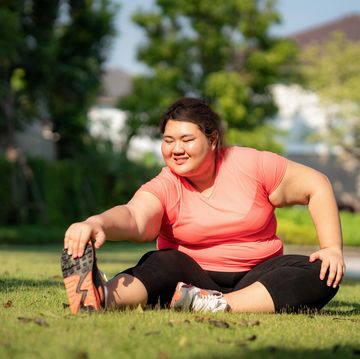
Four Workouts To Help Manage Your Type 2 Diabetes
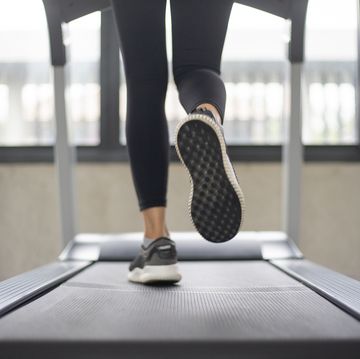
Should You Do Cardio Before or After Weights?
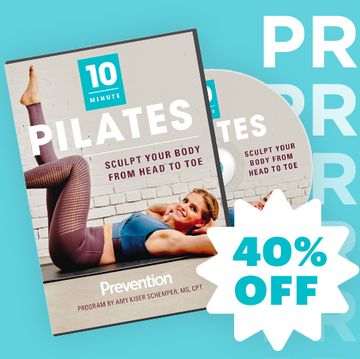
This 10-Minute Pilates DVD Is 40% Off for Prime
JUSTIN THOMAS MILLER
How do I start my fitness journey? A free 12-week beginner plan

How to start your fitness journey for beginners.
I went down a Reddit rabbit hole and stumbled upon this question.
I’m finally starting my journey of losing weight which has been much needed for a while now. The only thing is that I am extremely out of shape and have difficulty completing exercises and workouts I find online. So I was wondering if anyone had any suggestions for a workout plan or videos you like. I’d really appreciate it. If so and thank you so much in advance.
Which led me to write this article.
Just so we’re clear, I’m defining a beginner as anyone that has been training and working on their nutrition consistently for less than 6 months. Consistently is the keyword here.
Table of Contents
Using the “how to start your fitness journey for beginners guide”
First things first, bookmark this page or email it to yourself. You’ll want to come back to it later.
- Read the entire article
- Download the free habit tracker
- Practice and establish each skill for 2 weeks before leveling up to the next one
- Contact me if you need some help navigating it
Pretty simple, right?
How to start your fitness journey for beginners pre-work: Know what to expect
I’ve coached thousands of clients in-person and online and there are five challenges I can guarantee will present themselves when starting your fitness journey.
- You won’t always feel motivated
- At some point, you’ll feel tired
- Stress will make things hard and you may feel like you have a lot on your plate
- You’ll get bored with your routines, workouts, meals, and more
- You will not be perfect. You will make mistakes
All of this is ok and to be expected. The best thing you can do is to accept and embrace these challenges. There are two simple strategies I recommend practicing over the course of your journey.
Strategy #1: Never two in a row (and always something)
This means exactly what you think it means. It’s ok to make mistakes but never two in a row.
Eat a shitty meal? Cool, just not two in a row. Miss a workout? Cool, just not two in a row.
The second part of this is to focus on always something. Do something, anything, that helps you move closer to your goals. Can’t do your full workout? Cool, do one set of everything.
Can’t do one set of everything? Cool, just do the first exercise. Can’t do that? Ok, do 10 push-ups. That’s not going to work? Walk to the mailbox and back.
Do these small actions get you closer to your goals? No, but they keep you in the game and there’s something to be said for showing up every day.
Strategy #2: The if-then strategy
Here’s how it works.
If I’m not motivated, then I will [insert a small action you’re confident you can take].
For example, if I’m not motivated to cook, then I will order a meal that I know is healthy and meets my calorie needs.
If I don’t have time to go to the grocery store, then I will order them online for delivery. And set this up to recur each week until I have more time.
I’m sure you’ve heard the cliche take it day by day. Which I get and totally understand. When you make mistakes it’s nice to wipe the slate clean and pick it right back up at your next workout or next meal. But I’d also like you to look at the bigger picture.
Think of all the workouts you’ll be doing this year. Imagine all the healthy and calorie-friendly meals you can create for yourself this year too. For example, say your plan is to work out 3 times per week and eat 1 healthy meal each day. Over the course of a year, that’s 156 workouts and 365 meals.
Let’s say you miss a workout and enjoy some of the best pizza of your life in Chicago. That’s 1 out of 156 or 99%.
Now let’s get a little more realistic. You miss 10 workouts and eat 10 bowls of ice cream for dinner because butter pecan is the best. Disagree with me and I will fight you. That’s 146 out of 156 workouts or 93% and 355 out of 365 meals. Say what? That’s awesome.
Ok, let’s keep going down this rabbit hole. You miss 20 workouts and 20 meals. That’s 136 out of 156 or 87% and 345 meals out of 365. That’s pretty amazing.
I say all this because health and fitness are a long game and while taking it day by day is a great strategy seeing the bigger picture for health is just as important.
Rabbi Shlomo Zalman Bregman has a beautiful quote I love.
I have a phrase that I live by: ‘Add some zeros to it.’ There is not any one thing you can do that will be enough to get you the results you want. For example, working out at the gym one time isn’t going to help you lose a lot of weight. However, if you add some zeros to it, and repeat that one workout 100 times or 1,000 times, you’re going to get somewhere.
It starts with that single workout or meal. But it’s that workout or meal repeated over time that leads to results, and the good news is you don’t need to be perfect to be successful.
You just need to be good enough.
How to start your fitness journey for beginners: Weeks 1 & 2, start walking and explore meaningful movement
Change is more about consistency and momentum and less about motivation and willpower . Sure, there is a certain level of those things that are needed, but relying on them to get started and maintain progress is a common mistake I see.
One way to get around this is by creating a keystone habit for yourself. A keystone habit is a habit that usually leads to other habits falling into place. One of the easiest keystone habits to develop is a regular walking routine.
If you’re like most people, at best you have 30 to 60 minutes, two to four times per week that you can dedicate both physically and mentally to a strenuous workout. But finding a few minutes here or there to walk is much easier.
Some benefits of walking daily:
- Helps with recovery by improving blood flow throughout the body
- Low-intensity activity that doesn’t take away from weight training recovery
- Burns calories without exhausting you
- Keystone habit for a lot of people
- Physical and mental health benefits, stress relief, and can boost mood and energy ( 1 )
- A great way to connect with loved ones or get time away on your own.
- Lower blood pressure ( 2 )
I love a good run. There’s nothing like that high you get after it. But running is a high-impact exercise that can make it tough on the joints and muscles and even increase appetite.
While there is a difference in calories burned walking one mile versus running you can use walking and NEAT as a great way to expend calories.
NEAT stands for non-exercise activity thermogenesis. It is all the activity that is not exercise you do in a day, Things like walking, playing with your kids, cleaning, and fidgeting can all help you burn more calories.
Making time for more steps
Take mini-breaks to get some steps in or play. Start and end your day with a walk, park further away, and walk to local places.
- Aim to walk a few times this week. Even if it’s just to the mailbox and back
- Record your steps and then try to slowly increase by 100, 200, or even 500+
- Eventually aim for 8-15k per day
- Make it fun. Take the mile everyday challenge.
- Use it for conversation, podcasts, and audiobooks.
One of my favorite ways to move more outside of walking is to build a meaningful movement routine.
Recommended reading: Getting started with movement guide: Meaningful movement. Move your body in ways you enjoy .
How to start your fitness journey for beginners: Week 3 thru 10, fix your diet
Eating healthy and nutrition for maintaining a healthy body weight has been made way too difficult. There isn’t the best diet, perfect macro percentage, or certain foods you HAVE TO start or stop eating.
Here’s a big secret. Every single diet works for weight management.
- To lose weight the diet needs to create a calorie deficit. This means you need to eat fewer calories than the body needs.
- To gain weight the diet needs to create a calorie surplus. This means you need to eat more calories than the body needs.
This is regardless of what you eat. So yes, you can eat carbs and lose or gain weight. You can eat ice cream and lose or gain weight. You can drink wine and lose or gain weight. You can eat meat and lose or gain weight. You can “eat clean” and lose or gain weight.

Now, this doesn’t mean the quality of food does not matter, it absolutely does. It’s only a reminder that calories and how much you eat determine weight management.
When making changes to your diet it’s ok to start small. You don’t need to change everything overnight. Below is a series of simple practices you can try that will make a huge difference in improving your diet.
Week 3 & 4: Start creating more calorie awareness
Get a good idea of how many calories you need each day to reach your goals. I like the bodyweight planner from the National Institute of Diabetes And Digestive And Kidney Diseases. But you can also use the simple formula below to get yourself started.

Is this perfect? No, but it gives you a target and with a target, it’s much easier to aim.
- Fat loss: Bodyweight x 10-12
- Maintain weight: Bodyweight x 13-15
- Gain weight: Bodyweight x 16-18
- Example: 150 x 10 = 1,500 and 150 x 120 = 1,800 (Between 1,500 and 1,800)
You don’t need to count calories to be successful. But as Yale researchers showed us, for fat loss creating a calorie deficit is important .
Use this number to give yourself a rough idea of how many calories to eat per meal. For example, if 2,100 calories are needed to reach your goals, and you like to eat 3 meals a day with no snacks. You now know this is roughly 700 calories per meal.
You can look at nutrition labels or nutrition info online to learn more about the foods you’re eating. Apps like Myfitnesspal, Lifesum, Chronometer – and websites like Calorie King can help with this too.
Today, we’re looking to improve calorie awareness by taking on two small tasks.
- Reading labels or looking up nutrition info online or in an app
- Learning about calorie density and choosing foods that fill us up without a ton of calories
MISSION 1: READ LABELS AND LOOK UP NUTRITION ONLINE
We are notoriously bad at estimating how much we’re eating. So today we’re going to create better awareness by learning about the calories in the foods we make at home and when we go out to eat.
- If you’re eating anything with a label pay attention to the serving sizes and calories per serving.
- If you’re eating anything without a label (an apple for example) look it up in an app like MyFitnesPal or Calorie King. Simply type in the food and learn about the calories in different serving sizes.
Before going out to eat see if the restaurant provides nutrition info online, and choose what to get before you arrive. If not, see if they have the nutrition info on the menu when you get there.
Interesting that the salad you were thinking of getting is actually 1,000 calories
Take note of the recommended calories per day to reach your goals. This will give you an idea of how many calories to take in per meal as you eat out or create meals of awesome on your own.
MISSION 2: CHOOSE LESS CALORIE-DENSE FOODS
Calorie density can simply be summed up as more food with fewer calories.
More specifically, it’s the number of calories in a given weight of food. A food high in calorie density has a large number of calories in a small weight of food (i.e. olive oil). Food low in calorie density would have a small number of calories in the same weight as food (i.e. broccoli).
Choosing foods lower in calorie density is important because these foods are satiating and fill our stomachs without adding tons of calories to our diet.
Generally speaking, vegetables and fruit are the lowest in calorie density, followed by whole food starches, animal proteins, and finally liquid calories, nuts, seeds, and oils. Highly processed foods like cookies, candy, ice cream, and fries would also be calorie-dense foods.

Now, this doesn’t mean we can never eat these foods. It just means to be aware of them, eat them in moderation, and adjust their consumption of them based on our current goals.
If you’re up for it, look for a few places to swap some calorie-dense foods with less calorie-dense options.
- Orange instead of orange juice
- Side of fruit or a side salad instead of fries
- Mustard in place of mayo
- Seltzer water with lime instead of soda or an adult beverage
- Fresh fruit instead of dried fruit or trail mix
- Zucchini noodles instead of regular
Week 5 & 6: Start including a serving of protein and veggies with most meals
Protein is important for maintaining muscle when you’re in a calorie deficit and trying to lose weight and body fat. Protein when combined with resistance or strength training helps to keep your body from using muscle as a fuel source when in a calorie deficit. This is important because you want to maintain as much lean muscle as possible. It keeps your metabolism high and frankly helps you look better naked.
It’s also very satiating. When you’re training and reducing calories to lose fat and weight you will most likely be hungry at points. Protein (especially when combined with veggies) will keep your appetite at bay and feel fuller for longer stretches.
Vegetables are low in calories but high in vitamins, minerals, fiber, water, and other filling things. It would take eating a ton of them to get to a calorie level that leads to weight gain.
But how much protein and veggies per meal?
- For men: 2 palms of protein or roughly 6-8 ounces and 2-3 fists of veggies
- For women: 1 palm of protein or roughly 3-4 ounces and 1-2 fists of veggies

To help you include a source of protein and veggies with each meal download this simple food list . Mix and match your favorite sources and get creative with herbs, spices, and various seasonings to create meals you’ll enjoy.
Week 7 & 8: Self-care before snacking
Snacking is rarely related to physical hunger. I’ve found that self-care before snacking is the most effective strategy for coaching clients that need to reduce snacking for weight management goals.
Set up a reminder. Something that reminds you to practice self-care before snacking. Sticky notes, an alert on your phone, whatever works for you.
Choose a very specific action that you can practice when you feel like you want to grab a snack. There will be times when you blackout and catch yourself in front of the pantry with a spoon in a jar of peanut butter. If you catch yourself during or after mindless snacking, still practice the action.
- drink a glass of water
- do tow push-ups
- step outside for some fresh air
- take 5 deep breathes
Whatever slows you down, gives you a break, and makes you feel good
Reward yourself for practicing the action with something other than food. This could be something as simple as a checkmark on a calendar.
And if you are physically hungry and need a snack, choose something low-calorie like a piece of fruit – just enough to tide you over until your main meal.
Week 9 & 10: Adjust carbs and fats for weight loss or gain
Carbs are not the enemy and they alone don’t make us fat. Hopefully, by now you’re starting to see that what influences weight gain or loss is the calories consumed.
If you prefer low-carb, cool. Go for it. Your body can run fine without them, and you can lose or gain weight eating them depending on your overall calorie intake.
However, carbs are a great source of energy. Especially if you’re a very active individual or someone that trains very hard.
Healthy fats are very satiating, great for hormone health, and a wonderful source of energy. They can also add great flavor and variety to meals.
The point of all this is that calories, protein, carbs, and fats all play important roles in our diet and are important for our health. The way and how much you consume each is totally up to you.
But if we are looking at them in terms of overall importance for body fat and weight loss, it would look like this.

Recommended reading: Getting started diet guide: Improving your nutrition
Week 11 & 12: Reflect and adjust
Use these two weeks to continue what you’re doing and also to reflect.
- What went well these 10 weeks?
- What did not go as well as you would have liked?
- What one or two adjustments can you make to improve that thing that did not go well?
How to workout: Staring your strength training journey
Feel free to start strength training at any point in your journey.
The internet has made this way more difficult than it needs to be. We spend too much time arguing over reps, sets, rest time, liner, and non-linear. Honestly, just make sure you’re applying progressive overload over time and you’ll be fine.
Without progressive overload, it’s virtually impossible to get stronger or build muscle. In order to get stronger, build, or maintain muscle – The stimulus has to be more than it is used to. If you do the same thing over and over again nothing will change.
There are multiple ways you can do this.
- Intensity: Lifting more weight in your next training session.
- Volume: Doing more reps, sets, or exercises.
- Frequency: Doing more training sessions than the week before.
- Tension: Increasing the duration of each repetition within an exercise. For example, taking 5 seconds to lower yourself in a push-up.
Focus on compound movements.
This doesn’t mean you have to squat, bench, and deadlift. You’re fine starting with machines or your body weight. Below is an example of a routine using machines, body weight, or free weights that use similar movement patterns.
Machine Workout
- Seated leg press : 3 sets, 8-15 reps
- Machine row : 3 sets, 8-15 reps
- Machine chest press : 3 sets, 8-15 reps
Dumbbell Workout
- Goblet squat : 3 sets, 8-15 reps
- Single-arm dumbbell row : 3 sets, 8-15 reps
- Dumbbell chest press : 3 sets 8-15 reps
Barbell Workout
- Barbell squat : 3 sets, 8-15 reps
- Barbell bent-over row : 3 sets, 8-15 reps
- Bench press : 3 sets 8-15 reps
Bodyweight Workout
- Bodyweight squat : 3 sets, 8-15 reps
- Inverted row : 3 sets, 8-15 reps
- Push up (regular, knee, or elevated): 3 sets 8-15 reps
Each of these can be done Monday, Wednesday, and Friday (or Tuesday, Thursday, and Saturday) for a few weeks. And yes, you can do the same workout 3 times per week. You’ll get to practice some of the most important movement patterns and focus on form.
For most of us that want to get stronger and to look and feel better with and without our clothes on this will be fine and you can do it forever as long as you use progressive overload
Recommended reading: Getting started strength training guide
Making adjustments as you move through your fitness journey
Just because you do X doesn’t mean you get or deserve Y. Sometimes you’re going to work really hard for something and it’s not going to work out the way you had hoped for or at the rate you expected.
Patience is a virtue.
Pause, reflect, take a mini-break, or ask for help. Review what’s going really well for you and where there could be room for 1% better.
Getting started with the 12-week how to start your fitness journey for beginners plan
This article is one of many ways you could start or restart your fitness journey. My hope is that it takes some of the confusion and overwhelm out of it for you.
- Pre-work: Mindset, weekly reflection, decide which week you want to strength train
- Week 1 and 2: Walking Routine and meaningful movement
- Week 3 and 4: Calorie awareness
- Week 5 and 6: Protein and veggies
- Week 7 and 8: Self-care before snacking
- Week 9 and 10: Adjust carbs and fats
- Week 11 and 12: Reflect and adjust
Best of luck,

Photo credit
GET THE FREE 5-DAY COURSE
- First name *
- Email Address *
GET A FREE SHAKER ON ORDER ABOVE 5000/-
- BMI Calculator
- Login/Sign Up

- All Accessories Best Sellers Clearance Sale Gainers General Wellnes Glanbia Goals Gym Accessories Gym Bags Membership Proteins Shakers Strength & Stamina Uncategorized Vegan Protein Weight Loss Search for:
No products in the cart.
- Whey Protein
- Whey Isolate
- Whey Hydrolysed
- Casein Protein
- Vegan Protein
- Peanut Butter
- Protein Snacks
- Mass Gainers
- Weight Gainer
- Carbohydrates
- Pre Workouts
- BCAAs & Aminos
- Nitric Oxide
- Fat Burners
- L-Carnitine
- Multivitamins
- Fish Oil & Omegas
- Joint Support
- Liver Support
- Testosterone Boosters
- Growth Hormone Support
- Allmax Nutrition
- ANS Performance
- Applied Nutrition
- BigMuscles Nutrition
- Bulk Sports
- Cloma Pharma Laboratories
- Dymatize Nutrition
- Dedicated Nutrition
- Doctor’s Choice
- Domin8r Nutrition
- Dragon Pharma
- Dynamik Muscle
- Enhanced Athlete
- Evlution Nutrition
- Gaspari Nutrition
- HealthFarm Nutrition
- HF Nutrition
- Innovative Labs
- Insane Labz
- International Protein
- Kevin Levrone
- Killer Labz
- Labrada Nutrition
- Libertylabz
- Muscle Club
- Muscle Science
- MusclePharm (MP)
- Nutrex Research
- Nutrition Bizz
- One Science Nutrition
- Optimum Nutrition
- Performax Labs
- Pole Nutrition
- Revange Nutrition
- RiteBite Nutrition
- Ronnie Coleman
- RSP Nutrition
- Sunline Alaska
- Ultimate Nutrition
- Terror Labz
- UP Nutrition
- VitaXtrong (VX)
- Universal Nutrition
- Diuretic / Water Loss
- Authenticity
- Store Locator
- Top 10 Supplements
- Bmi-Calculator
- Clearance Sale
Blog , Health & Lifestyle
10 effective tips for starting a fitness journey.

Embarking on a fitness journey can seem daunting, particularly if you’re unaccustomed to physical activity and wellness practices. Nevertheless, by adopting a positive attitude and a strategic method, you can successfully attain your fitness objectives and revolutionize your lifestyle.
Here are 10 Effective Tips for Starting a Fitness Journey:
1. set realistic goals.
To begin a fitness journey, it is important to establish practical objectives/goals. These objectives should be attainable, precise, quantifiable, and have a time limit. For instance, rather than aiming to shed 50 pounds in a month, strive to lose 1-2 pounds every week for six months.
2. Find an Exercise You Enjoy
To maintain a consistent fitness regimen, it is crucial to discover an exercise that brings you pleasure. Whether it is jogging, swimming, biking, or practicing yoga, select an activity that suits your lifestyle and that you eagerly anticipate engaging in.
3. Start Slowly and Gradually Increase the Intensity
To avoid injury and ensure long-term strength and endurance, it is crucial to begin your workouts slowly and gradually increase the intensity.
4. Make Time for Exercise
Make exercise a priority in your daily routine. Schedule it into your calendar and treat it like any other appointment. Sticking to your fitness routine and turning it into a regular habit can be facilitated by this.
5. Get a Workout Buddy
To maintain your motivation and responsibility towards your fitness routine, having a workout partner can be beneficial. Look for a friend or family member who has similar fitness objectives as you and plan regular workout sessions together.
6. Mix Up Your Workouts
To achieve optimal results in exercise, it is important to maintain variety in your workouts. This can be achieved by incorporating different activities, changing your routine, and including both strength training and cardio exercises. Varying your workouts can help you maintain engagement and provide your body with diverse challenges.
7. Fuel Your Body with Healthy Foods
To sustain your body and achieve your fitness objectives, it is crucial to consume a nutritious diet. Incorporate entire, nutrient-dense foods such as fruits, vegetables, lean protein, and healthy fats.
8. Stay Hydrated
Staying hydrated is important for your optimal health and fitness, as it helps regulate your body temperature, lubricate joints , and aid in digestion. Monitor your urine color to ensure you’re adequately hydrated. Make sure to consume sufficient water both during your exercise routine and throughout the day.
9. Get Enough Rest and Recovery
To attain your fitness objectives, it is equally crucial to prioritize rest and recuperation as much as exercising. Take rest days, get proper sleep, and add stretching and foam rolling into your regimen.
10. Celebrate Your Progress
Finally, celebrate your progress along the way. Whether it’s hitting a new personal record or simply sticking to your routine for a week, take time to acknowledge your achievements and reward yourself for your hard work.
Embarking on a fitness journey can pose difficulties, however, by implementing these ten practical suggestions, you can establish a strong foundation for triumph and attain your objectives. Remember to stay committed, stay positive, and enjoy the journey!
Starting a fitness journey is an exciting adventure, and choosing an exercise program that you love is a critical step toward long-term success. By trying different types of exercises, considering your preferences and interests, setting realistic expectations, mixing up your routine, and finding a workout buddy, you can discover activities that bring you joy and make your fitness journey more enjoyable.
Remember that everyone’s fitness journey is different, so listen to your body, establish reasonable objectives, and make modifications as required. Maintain consistency, motivation, and, most importantly, have fun along the journey. With these helpful hints, you’ll be well-equipped to begin your fitness adventure and reach your desired health and wellness objectives. So lace up your shoes, find your rhythm, and get ready for an adventure. Here’s to a fruitful and rewarding fitness adventure!
Fitnesstack

Username or email address *
Password *
Remember me Log in
Lost your password?
Email address *
Subscribe to our newsletter
Your personal data will be used to support your experience throughout this website, to manage access to your account, and for other purposes described in our privacy policy .
6 Expert-Approved Tips to Make Exercise a Habit
Going to the gym once is a good start, but exercising consistently can help you lose weight and stay healthier and happier. Here are six tips from a fitness expert that will help you learn how to make exercise a habit.
How to Make Exercise a Habit
Finding time to exercise and starting a daily exercise routine are some of the first steps to incorporating more physical activity in your daily life. Once you've started a routine and found a time and place to work out , it's important to start thinking about how to make exercise a habit.
How Long Does it Take to Make Exercise a Habit?
Conventional wisdom has long held that it takes 21 days to form a new habit . However, the 21-day timeframe has little or no research to support it and is based on a misinterpretation. It's been repeated so often that over time, people simply began to assume it was true.

Getty Images
The 21-day mark may have originated with Dr. Maxwell Maltz, a plastic surgeon, who wrote in his 1960 book "Psycho-Cybernetics" that it took approximately 21 days for his surgical patients to let go of their pre-surgery mental image and accept their new appearance. How that observation transformed and amplified is a bit of a mystery, but it is so widely stated and believed that researchers decided to put it to the test.
Recently-published research used machine learning to track thousands of participants and uncover how quickly a behavior change might turn into a habit. The two habits they looked at were gym attendance, an incredibly complex behavior, and hospital handwashing, a simpler behavior.
They found that while it took weeks to develop the handwashing habit , six months or more often passed before people developed a habit of regular gym attendance .
These findings confirm that a complex behavior like exercising will take a longer time to become a habit. If you were to sign up for a gym membership with the expectation that 21 days later you’ll be a committed long-term exerciser , you’d likely be setting yourself up for failure.
Many variables impact whether you complete your daily exercise routine on any given day: work responsibilities, family responsibilities, illness, injury, fatigue, stress and more. Overcoming those obstacles on a consistent basis can be a real challenge, no matter how long you’ve been working to solidify the habit.
Compare that to something far simpler, like washing your hands when you enter a hospital room or flossing your teeth before bed, and it’s easy to see that no two habits are the same; so why would the timelines be the same? It’s time to strip the 21-day habit myth from our understanding of human behavior.
Fitness Tips for Life
While it may be discouraging to hear that you aren't likely to make exercise a habit in 21 days, there are some strategies you can use to become a committed exerciser.
1. Begin with small steps, and engage in activities you enjoy.
A successful physical activity program has to be safe and effective, fit within your daily schedule and be realistic. While that early-morning high-intensity interval training (HIIT) class may be effective, it may not match your current fitness level. Consider also whether it's reasonable to expect yourself to make it to the gym before work.
Self-awareness is essential to habit formation. Take time to realistically consider when you’re likely to consistently make it to the gym and what workouts are right for you . Enjoying your workouts is also a key element of long-term adherence, so your program has to be something you look forward to each day and something you’re good at. Exercise should be an escape from your daily stress , not an added stressor.
2. Prioritize regular physical activity.
In order to make physical activity a priority, schedule time in your calendar. Putting your workouts on your calendar gives them importance and permanence akin to a doctor's appointment or a work assignment. Having workouts on your calendar also lets other people in your life, like family members or coworkers, know the value you place on your health and well-being.
3. Join a group or find a partner.
Socializing with a workout partner, joining a group fitness class or finding a community-based exercise program is a great way to make it more fun. Not only that, but studies indicate that social support can increase optimism and self-esteem , reduce stress and depressive symptoms, and may make you more likely to stick to the program. Having social support through a team sport or workout partner can add accountability to your participation, which may help you make it to the gym on those days when your motivation is waning.
4. Set smart goals and track your progress.
Setting both short-term and long-term goals can help you make consistent progress. People tend to focus on long-term, outcome-focused goals related to weight loss or athletic performance, but it’s important to also have short-term, process-oriented goals . For example, a process-oriented goal could be: “I will attend a group fitness class on Monday, Wednesday and Friday each week this month.”
That way, you have something measurable and attainable that you can accomplish on a regular basis. Those small stepping-stone goals can help keep you motivated and are easier to track progress on. Keep a journal or download an activity-tracking app that can help you know whether you're reaching those goals.
5. Align your plan with your values.
You may have a goal of losing a certain amount of weight, but it’s important to explore why this is important to you. This is often referred to as "finding your why."
Maybe you want to lose weight so you’re better able to play with your grandchildren . Or you'd like to be able to play golf without spending the next several days feeling sore. Any reason why you're exercising is valid, and knowing why exercise is important to you can keep you motivated.
6. Finally, stay positive and be patient.
Developing an exercise habit takes time and consistent effort, but also patience and grace with yourself . If you place too much emphasis on perfection by setting a goal like “I will go to the gym every day after work” without any flexibility, you’re setting yourself for frequent “failure.” Instead, set that goal for yourself, but acknowledge that sometimes life simply gets in the way. Understanding that you will experience setbacks on your fitness journey is vital to long-term success, so stay positive and be kind to yourself every step of the way.
5 Tips for Warming Up Before a Workout

Tags: exercise and fitness , Heart Health , weight loss
Most Popular

OTC Medicine & Health Products

Patient Advice

Senior Care

health disclaimer »
Disclaimer and a note about your health », you may also like, exercises for osteoarthritis.
Vanessa Caceres March 29, 2024

When to Stop Exercising Immediately
Elaine K. Howley and Anna Medaris Miller March 25, 2024

Best Workouts for Women Over 50
Cedric X. Bryant March 14, 2024

Yoga for Knee Pain
Jake Panasevich Feb. 29, 2024

You Should Use These 9 Gym Machines
Ruben Castaneda , K. Aleisha Fetters and Payton Sy Feb. 23, 2024

Exercise: How Much Do You Need?
Cedric X. Bryant Feb. 15, 2024

How to Prevent Pickleball Injuries
Cedric X. Bryant Jan. 25, 2024

Are Energy Drinks Bad For You?
Elaine K. Howley and Anna Medaris Miller Jan. 19, 2024

Mind-Blowing Benefits of Exercise
Vanessa Caceres and Stacey Colino Jan. 10, 2024

Staying Fit During the Holidays
Cedric X. Bryant Dec. 8, 2023

Choose a Location.
Launching your fitness journey: a guide to gym routine for beginners.

Starting a gym routine can be intimidating, confusing and even frustrating, especially after a long hiatus from working out. With so many options and a plethora of information available at your fingertips, it can be a challenge to navigate and know how to get started. With some planning and goal setting, you can find a manageable routine that can have long lasting physical and mental health benefits. There really is no right or wrong way – the reality is, to be successful you must find a routine you can be consistent with and incorporate into your daily life on a regular basis. View our Frequently Asked Questions that we have curated over the years to learn more about the Orangetheory Fitness workout.
Too many people get caught up in the mindset of “is this the best way to work out?” instead of adopting the mindset of “is this the best way to work out for my life right now?” Before you start setting your goals or workout routine plans, first spend some time considering how much time you can realistically spend each day exercising. Be real with where you are: if you currently don’t exercise at all, do not jump to working out five or six days a week. Instead, try two or three times a week. Chances are, as you begin to feel the benefits you will start problem solving for how you can fit it in more—but give yourself time to establish consistency first. Learn more about the importance of a “Cooldown” to reduce the risk of injury and more!
The Importance of Starting with Low Intensity
Once you figure out a reasonable amount of time you can dedicate to exercising each week, think about your long-term goals. Are you looking for improved health markers, increased stamina, greater strength or fat loss? Are you wanting to train for a specific event like a 5K, adventure race or hiking trip? No matter the goal, if you are a beginner or coming back after a significant time off, you will need some short-term goals to improve your fitness foundations before you start catering your routine to specific long-term goals.
Long-term goals provide motivation, while short-term goals build the foundation necessary to achieve your larger aspirations. A few key fitness foundations incorporate cardiovascular endurance, muscular strength, joint mobility and stability and recovery. You want a strong foundation to build upon! If you do not build this foundation first, you run the risk of injury or burn out which will set you back from reaching those bigger goals.
Beginner-Friendly Workouts Explained
- Cardiovascular Endurance: Begin with low-impact exercises like cycling, treadmill walking or swimming. Start with short sessions (10-20 minutes) and over time increase the duration. Once you get up to 30-60 minutes you can go back to the shorter sessions but increase the intensity (i.e. adding incline to your treadmill). The best cardio exercise? The one you like the most!
- Muscular Strength: Incorporate resistance training exercises using your body weight, light-to-moderate loads or bands. Aim to get in two or three sessions a week and do a minimum of one set for each major muscle group. To maximize your time, do compound movements that involve more than one muscle group at a time (i.e. squats, push-ups, lunges and rows). Include joint stability and core into your program (i.e. planks, bridges).
- Joint Mobility: You can incorporate this by starting each exercise session with a dynamic warm-up that focuses on joint mobility (i.e. hip and arm circles).
- Recovery: Include rest days in your routine to allow your body to adapt to the stress of exercise. Nutrition, hydration and sleep are keys to adequate recovery too.
Constructing Your Weekly Workout Plan
Below is a sample weekly routine you can follow or use for inspiration to get started. It includes the major movements you want to incorporate (push, pull, squat, lunge, hinge and core). Remember, if you are aiming for 20 minutes of cardio, that could mean you do ten minutes in the morning and ten minutes in the afternoon. Start each workout with a dynamic warm-up and finish with a cool-down/stretch.
This plan has an upper and lower strength training session that is quick. Then, put these together for two longer workout sessions the next week. Have less time? Ditch the upper and lower workouts and do the total body workout two to three times a week. In general, you can do lower and upper strength training on consecutive days, but you will want to allow time for your muscles to rest in between total body strength sessions. Keep in mind recovery needs variation and change as your fitness level changes.
Be sure to have some way to track your workouts – you deserve to give yourself credit for your hard work! A visual display of your progress (whether in an app or on your desk) can help you stay motivated. At Orangetheory Fitness, we track all your workouts within our mobile app so that our members can see their progress in real-time and over time.

Incorporating Community Wisdom
Managing your own fitness programming can be challenging—especially if you don’t know how to adapt and evolve your workouts as you progress. This is where a fitness professional can help guide you, whether that be a personal trainer, online workout program or a boutique studio like Orangetheory that provides daily programming and a coach to customize each workout to your needs. A studio like Orangetheory also provides a community of people with similar aspirations to yours to foster accountability and help you be successful.
No matter what your goals or weekly routine look like, the most important aspect of your success is consistency. It can take several months before you start seeing and feeling the effects, so be patient, be consistent and stay the course. One of the most important things you can do for your long-term health is exercise – you are worth the work!
Rachel Vaziralli, Orangetheory Fitness's Director of Fitness Design, oversees the creation of their heart rate-based workout program, leveraging science, technology, and coaching to help members live a longer, more vibrant life. With a rich background in fitness, including roles at Equinox and extensive education in dance and exercise physiology, Rachel brings a wealth of experience to her current position. Based in Boca Raton, Florida, she remains dedicated to helping individuals unlock their maximum fitness potential.

Free Intro Class*
- Skip to main content
- Keyboard shortcuts for audio player
- Dear Life Kit
- Life Skills
Why Working Out Should Be About More Than What You See In The Mirror

Andrew Limbong
Audrey Nguyen

Ornella Corazza, a professor of addictive behavior at the University of Hertfordshire, says there was more anxiety about body image during the lockdown. Photo Illustration by Catie Dull/NPR hide caption
Ornella Corazza, a professor of addictive behavior at the University of Hertfordshire, says there was more anxiety about body image during the lockdown.
Like a lot of folks, I started working out a bunch during the pandemic. I'm talking real jock stuff — swinging and cleaning and pressing hunks of metal. And I started noticing my body change which was cool! I'd never lifted weights before, so this was new to me.
But then I noticed myself noticing my body more often. Suddenly the ever-changing glob of skin and bones that I was seeing in the mirror wasn't changing enough ... my traps weren't big enough, my core not toned enough.
Explore Life Kit
This story comes from Life Kit , NPR's family of podcasts to help make life better — covering everything from exercise to raising kids to making friends. For more, sign up for the newsletter and follow @NPRLifeKit on Twitter .
It turns out a lot of people were feeling similarly. "There was a greater anxiety about body image during the lockdown," says Ornella Corazza , professor of addictive behavior at the University of Hertfordshire.
We talked to experts for tips on how to keep comfortable with your body, even as it changes. Here's what they had to say.
Examine your motivations for getting in shape

Maillard Howell, head of fitness at Reebok and co-owner of Dean CrossFit, doesn't promise clients they'll be the most ripped person on the beach. Instead, he tells them, "you're going to be able to play with your kids without getting out of breath." Catie Dull/NPR hide caption
Maillard Howell, head of fitness at Reebok and co-owner of Dean CrossFit, doesn't promise clients they'll be the most ripped person on the beach. Instead, he tells them, "you're going to be able to play with your kids without getting out of breath."
Instead of focusing on aesthetic changes, consider how exercising can improve your quality of life. Study after study shows exercise is good for your physical health , as well as your mental health. Exercise can help lower your risk of heart disease . Aerobic exercises have been proven to reduce anxiety and depression .

Shots - Health News
Heart disease is still a killer. here's how to reverse it.
Maillard Howell is the head of fitness at Reebok and co-owner of Dean CrossFit. When he works with clients, he doesn't promise them they'll be "the most ripped person on the beach" or that they'll get strong enough to qualify for the CrossFit games. Instead, he tells them, "you're going to be able to play with your kids without getting out of breath." The process of "getting into shape" isn't just a physical journey but a mental and emotional one as well, Howell says.
Corazza agrees, adding that "we need to remember that we not only have a body, but we are our body." Our bodies aren't machines. They have other needs, too, she says.
"We need to get in touch with feelings, with sensation ... asking ourselves how we feel," Corazza says.
Keep an eye on your behaviors for any indications that you might be veering into unhealthy territory
Corazza says that seeing fitness as purely a means to get more attractive can lead people to compulsive exercise, disordered eating, depression, and performance-enhancing drugs.

How Weightlifting Helped One Writer Work Through Her PTSD
It's normal to shift your behavior as you're working towards or training for a fitness goal, but Corazza says, "the key question is who is in control? Are you in control of your life, or [are] certain behavioral things controlling you?"
Here are some questions to consider:
- Do you feel like you have control over your exercise habits, or do they feel compulsive?
- If you aren't able to exercise, do you feel any kind of withdrawal?
- Are you repeatedly canceling plans with friends and family in order to exercise?
- How is your exercise routine impacting your eating behavior or sleeping patterns?
- Do you feel the need to obscure the amount you exercise?

How Body Positivity Can Lead To Better Health
Try not to compare yourself — or your progress — to others.
"Comparison is the thief of joy," says Howell. "Focus on you. Focus on your self-confidence. Focus on your journey."
It's hard to not get caught up in comparing yourself to others in this age of hyperconnectivity. If you find yourself scrolling through Instagram and constantly comparing your body to other bodies populating your feed, remember that we're all built differently. "We all do different things for a living. I don't have any kids ... You might have four or five kids at home. There's so many variables," says Howell.
For advice on how to have a healthier relationship with social media overall, check out this Life Kit episode.
Figure out a way to move your body that doesn't feel like a total chore

Exercise can look like a lot of different things — lifting weights and doing circuits, yoga and spin classes.
"Find a fitness facility that resonates with you," suggests Howell. Gyms and studios often offer free trials. Take advantage of those offers to feel out the vibe of each spot. If a certain class or studio feels aimed at a goal that's not a right fit for you, head over to the next one.

Biology's A B*tch: 5 Reasons It's So Hard To Keep Weight Off
If the idea of exercise for exercise's sake doesn't work for you, consider more recreational activities, like hiking, rock climbing, or a recreational soccer team.
When you do find your thing, remember exercise doesn't have to leave you absolutely wrecked for it to "count." Research shows that just a little bit counts in big ways . For long-term benefits, consistency is key.
Set a realistic goal
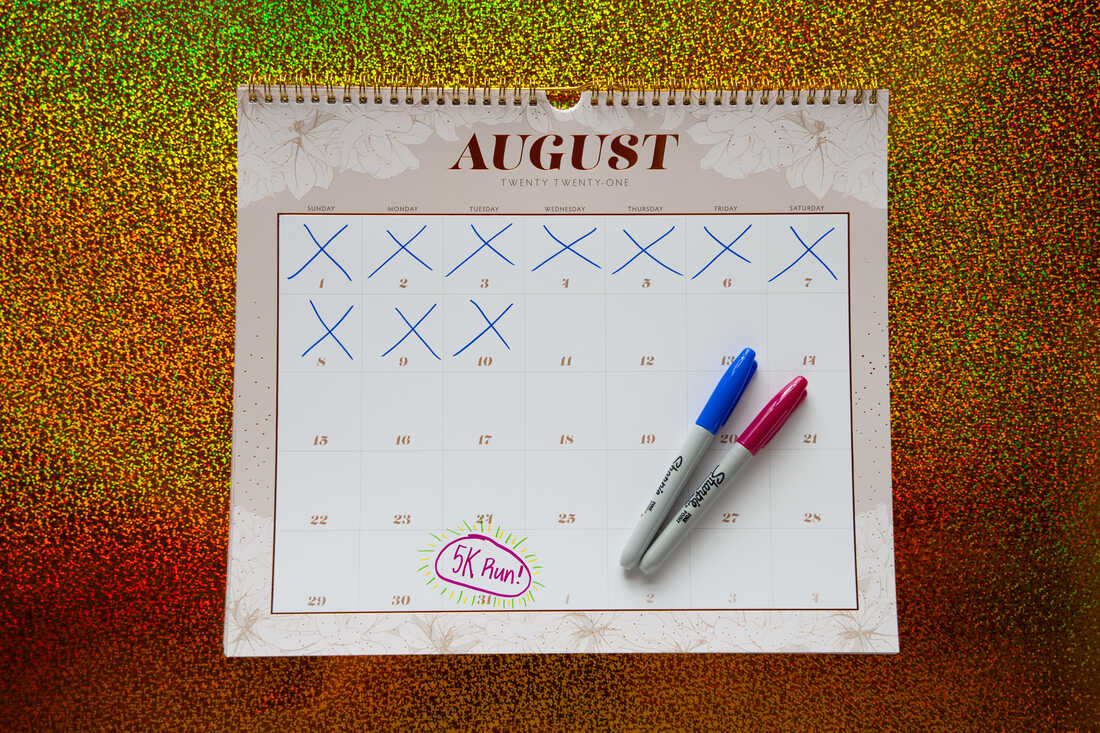
It can be hard to stay motivated . It helps to have something concrete and specific to work towards — something challenging, but achievable.
If you need help identifying a goal, Howell suggests working with your doctor to figure out what you can do to improve your health. Ask about the different facts and figures on your medical chart, like resting heart rate or blood pressure, he suggests. "What does it mean, and how does it relate to my day-to-day?"

A Behavioral Scientist's Advice For Changing Your Life
Once you've set your goal, figure out when you want to accomplish it and work backward from there. Identifying the small steps you can take makes the larger task feel more achievable, which can help keep you motivated.
On days you're not feeling up to it (rest days aside), Howell says to remember, "Today is important. [Your activity today] doesn't have to be a big thing. Just go in the general direction of [your long term] goal."
Can't run your miles? Go for a short walk. Feeling sore? Do some stretch work.
"I know what I do today is going to have an effect no matter how tiny it is," Howell says. "That drop in the pan today is going to help that three-month goal. And that's what keeps me focused."
The podcast portion of this story was produced by Audrey Nguyen with help from David West Jr. Engineering support from Alex Drewenskus. Fact checking by Janet W. Lee
We'd love to hear from you. If you have a good life hack, leave us a voicemail at 202-216-9823, or email us at [email protected]. Your tip could appear in an upcoming episode.
If you love Life Kit and want more, subscribe to our newsletter.
- Life Kit: Life Skills
Welcome to Renpho

- Eye Massager
- Massage Gun
- Foot Massager
- Leg Massager
- Handheld Massager
- Neck & Back Massager
- Smart Body Scale
- Smart Food Scale
- Smart Tape Measure
- Air Purifier
The Ultimate Guide To Starting Your Fitness Journey
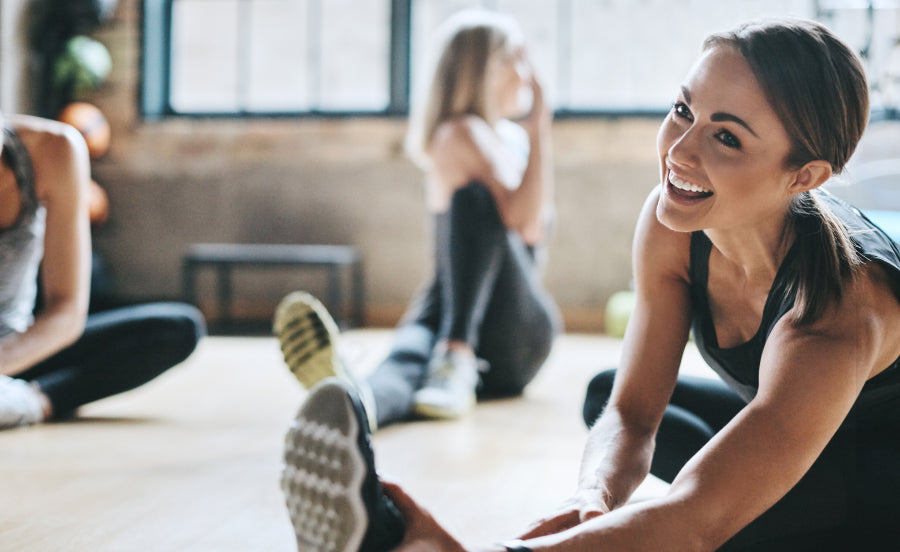
Stay tuned to our latest news
Recommended Products
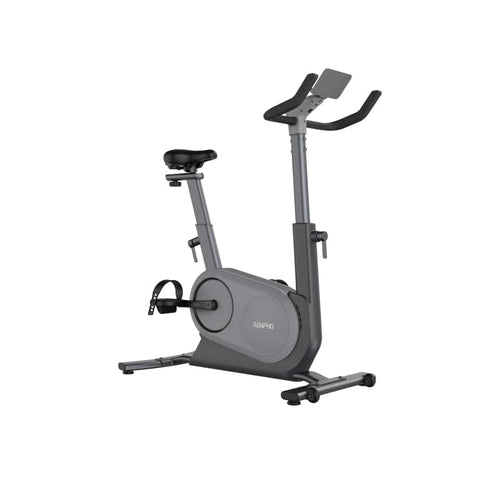
Elis 1 Smart Body Scale
By florence milano.
You might think starting a journey of health and fitness is overwhelming. Your mind quickly visualizes an image of exercise equipment or people staring at you. It can be intimidating, but keep in mind that everybody once started as a beginner.
Deciding to end old habits while making healthy improvements can be a life-changing decision. Not only will this greatly improve your overall well-being, but it can also boost your mood , increase your confidence in yourself while remaining motivated to stay on track.
Coming prepared with the right game plan will help you succeed, so we’ve laid out some strategies to help you get started!
1. Determine Your Reason and Commit to Doing So
One thing to consider when starting anything is why you’re doing it in the first place. Are you doing it for yourself or others? What do you hope to get out of it?
It should be something you want rather than something that you think you need. The motivating factor could be as simple as not wanting to be out of breath when taking the stairs or improving your mental health.
Wanting to have a regular exercise routine , researching the most effective methods and other time-consuming tasks will not yield results. It is entirely up to you whether or not you’re ready to make the change, but you cannot achieve your objectives if you’re not fully committed to the process.
Reassure yourself that you can handle anything and everything that may occur no matter how difficult or challenging it will be.
2. Make a Plan and Set Up a Vision Board
Having a plan is essential to any goal because you need to know what goals you wish to achieve and when you intend to break them when developing a strategy. Be it for exercise, mealtime or meditation; it’s important to establish the best schedule for yourself.
A vision board is typically a list that contains images and graphics rather than just writing. It encourages you to visualize your goal, your journey and the action plans to achieve it.
Create a vision board wherein you can start planning and working on your fitness vision. You may use a bulletin board, a shadow box, a poster board or just a notebook. It doesn't have to look like anyone else’s: it should be what inspires you. Here are some examples you could collect for your fitness vision board:
- Old pictures of yourself
- Pictures of nutritious foods
- Inspirational short stories
- Journal clippings
- Everything that highlights your ambition
Put your vision board somewhere where you'll see it every day. You can even make another vision board for the things you have accomplished.
3. Setting Positive and Achievable Goals
Some people want to build endurance, improve their health and boost their confidence. But what should you do to get there?
Fitness goals are important for several reasons. They hold us accountable, expand our perception of the possibilities, and motivate us to push through temporary challenges to attain long-lasting changes.
Though it’s great to have your big ultimate goal, you should also set smaller and more manageable fitness targets to help you get there.
We all want immediate satisfaction, but it’s important to be realistic about the deadline you set and remember that everything takes time. Major improvements will never be completed within a week.
Choose a goal that you can accomplish over months rather than a year, like getting more exercise and controlling your food intake. In this way, you are more likely to stick to it if you approach it with a long-term mindset than a quick fix mentality.
If you own a RENPHO AI Smart Bike , set smart goals to help make losing weight more manageable by taking AI Gym video courses with certified Les Mills trainers. This can help you with a clear path to success and help you find the motivation to keep going.
4. Start with Baby Steps
It is best to start your fitness journey little by little. There’s no need to run a marathon or lift weights on Day 1, or you’ll end up getting injured and discouraged.
Start with 15 to 30 minutes of daily cardio with your AI Smart Bike to establish a regular exercise habit. Over time, you can add more difficult routines to your exercise.
5. Check Out Different Things and Find Out What's Best for You
You need to know your likes and dislikes so you can be passionate about your fitness program. Every year there are new trends, fun fitness videos and equipment to try.
Experiment where possible and discover your fitness style so you can have the most fun while working out. Whatever you choose, make sure to include strength, training, cardio and high interval training in your exercise schedule.
6. Track Your Progress
It’s important to track your fitness growth to make sure you stay motivated.
Note your maximum reps for each set of lifting weights, building core, or tracking your speed and cycling time with the intelligent bike and RENPHO's IA app for cardio exercises. This will allow you to maintain consistency and progress over time.
7. Stick to Healthy Habits
To achieve your goals, consistency is needed in having healthy habits. These habits can be as easy as going for a 30-minute workout with your AI Smart Bike three times a week and treating it as a ritual.
Make sure the healthy habits you include in your daily routine are in line with your desired outcomes. It's also important to make these habits basic so that you can integrate them into your daily routine every day.
Trying to incorporate too many things at once to construct your ideal daily routine can cause more damage than good because it is unlikely to be sustainable. It’s important to remember that being healthy is a way of life, not a temporary solution.
Sleep improvement and less screen time are examples of integrating healthy routines. It will both make you feel better every day and will also help you recover from your workouts.
Stick to one to three action plans at first, and if you can keep them up regularly, you can add more.
8. Eat a Healthy Diet
Fitness entails more than just physical activity. You must also ensure that your body receives the proper nutrition to fuel your workouts.
The number of calories you burn doesn’t matter when you immediately include it in your eating habits. But over time, the quality of the calories in the food you’re consuming will become more essential.
False fats, sweets, false colors and flavorings, among other things, can affect your immunity and may risk you getting sick and hinder fat-burning hormone production.
The best way to start eating healthy at home is by educating yourself– understanding which foods will help you keep your goals will make it easier to create simple healthy eating habits and incorporate them into your daily routine.
There's no need to stick to the most recent fad diet. Begin by consuming a variety of fruits and vegetables, as well as protein, complex carbohydrates and healthy fats.
The RENPHO Health app, for the RENPHO Smart Body Scale , can assist in setting target goals for you to achieve if you have a specific weight or fitness goal in mind.
9. Choose Water Over Fizzy Drinks
You will normally need to drink more water when you shift into a daily routine and regular exercise. It's a way of your body’s signal, which you shouldn’t ignore!
Hydration refers to drinking enough water before, during and after any activity. It keeps your body cool and your joints lubricated. Water improves the nutrient distribution that keeps you energized and healthy.
Your body cannot function well if you’re not adequately hydrated, which can lead to muscle cramps, tiredness and disorientation and other serious symptoms.
Refresh and hydrate, especially if you do intensive workouts regularly. Drinking plenty of water is just as important as eating healthy.
10. Don’t Let Your Cheat Days Waste Your Progress
Cheat days are fine, just be smart about them. A small slice of cake is welcome, but go overboard with it, or you lose all your hard work.
By balancing workouts with healthy eating and a life filled with the occasional treat, you can enjoy your fitness routine even more and continue to reap the rewards for a lifetime.
11. Find a Fitness Buddy
Starting your fitness journey may be frightening, so having someone with you every step of the way can help. They can help to keep each other motivated and have fun while doing so. In the end, a trustworthy workout buddy increases your chances of sticking to your regimen!
Don't worry if you don't have a willing friend. The RENPHO Power User is a community Facebook group where RENPHO users with similar ideas can share their fitness journeys and encourage one another.
12. Expect Challenges
Life has the habit of throwing you curveballs. You may find yourself busy with work, family, or life in general that you are unable to work as much as you would like.
We've all been there: You stick to your diet for a week before breaching it with a weekend heist. You plan to exercise more, work out for 3 days, and then find it hard to get out of bed after a long day at work.
You build career visions and become enthralled by the possibilities, only to be weighed down by day-to-day responsibilities and not have the energy for fitness for weeks or months.
If you’re having trouble staying motivated to exercise, try a new training approach to see what you prefer. If you’re worried about suddenly losing your motivation, do a strategy ahead of time to avoid it! Find some motivational quotes to keep you focused and remind you why you’re doing it.
The most important thing is to not give up. Return as soon as possible. Try to find small ways to be more active over the day. Never forget that exercise is better than none.
13. Appreciate Recovery Days
Recovery time is as important as the time and effort you put into your workouts. Every workout puts a lot of stress on the muscles .
Because your body goes through a lot during exercise, you need to give yourself adequate time to recover so that you can keep doing it. Therefore, try working out no more than three consecutive days, then allow at least one day of rest in between each workout.
14. Prioritize Sleep
Those who want to achieve their goals must commit to quality sleep . A key component of achieving goals is taking good care of your health.
You may be sleeping less because of other priorities such as work or business. Try to make a sleeping schedule where you can get 7 to 9 hours of sleep per night and manage your activities around it.
Sleep is especially important for the muscles to repair themselves properly and gain strength from the workout.
If you get only a few hours of sleep per night, your ability to think clearly will suffer and it will be harder for you to fulfill your goals. Embrace the deeply restorative powers of sleep for both your body and mind and put them to good use.
Just as taking breaks is important, having good rest is important as well. But make sure you’re getting good sleep so that you’re able to gain energy and keep working toward your goals.
15. Use the 80-20 Rule
Keep in mind that starting your fitness path does not mean that you have to stop doing everything else. For most people, fitness, and health are all about striking a balance. Give yourself a break now and then!
It’s essential to discover something you enjoy while still having an open mind when it comes to fitness: so, be adaptable and change what you do not like. Patience and determination are what you need to achieve your goals. At the end of the day, you have to remember to be kind and loving to yourself.
Now that you have an idea of how to start your fitness journey, download the RENPHO app and discover more fitness, nutrition and health tips.
Renpho Health Tips
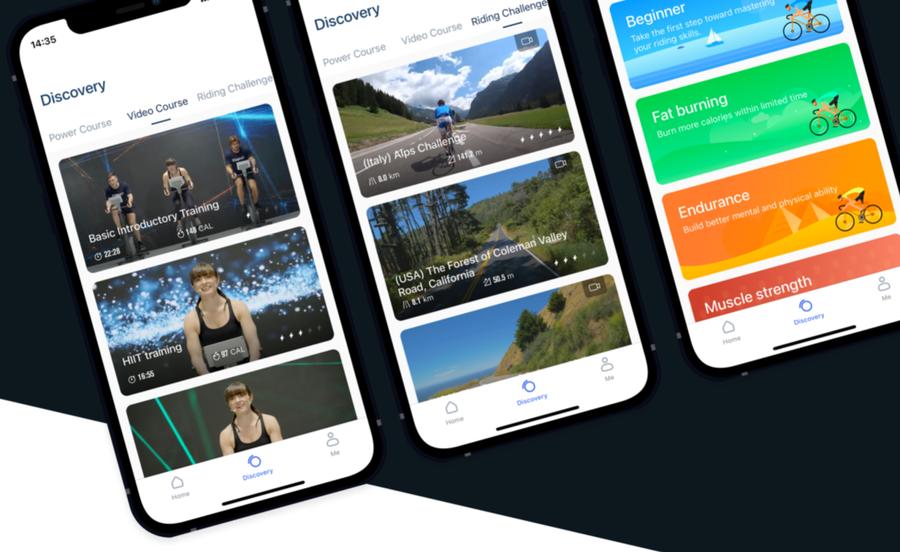
Improve Your Indoor Exercise Bike Workouts with AI Gym App
May 28, 2021
Read more >
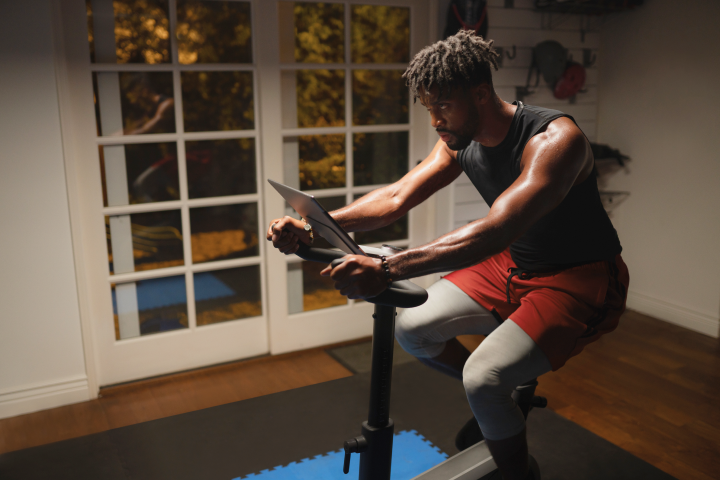
What Is FTP and How Can It Improve Your Workout
Jul 09, 2021
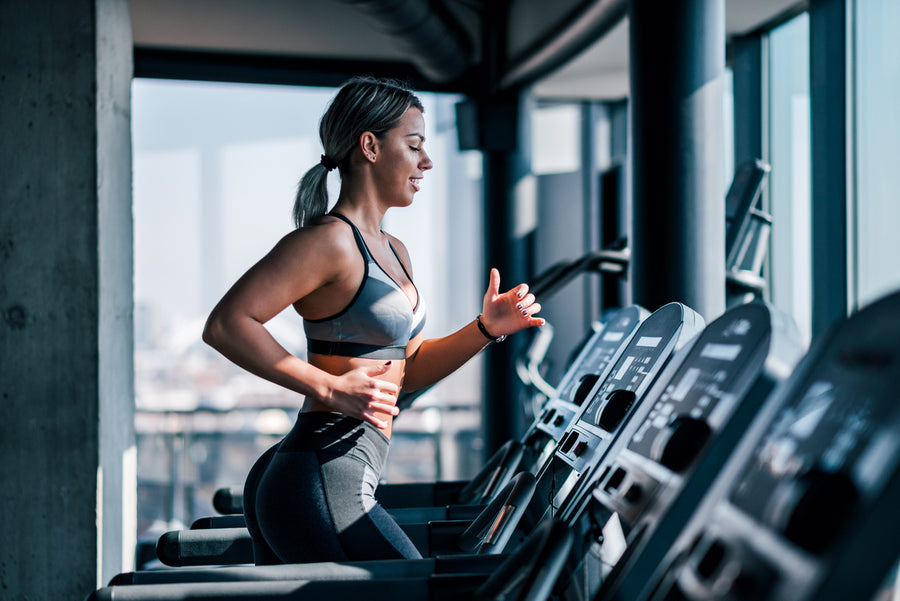
Stationary Exercise Bikes vs. Treadmills: Which Is the Better Workout?
Dec 30, 2021

How Does The RENPHO Smart Scale Work? How Are They Different From Each Other?
Aug 03, 2020

How The Renpho Smart Body Fat Scale Helps Keto Dieters Lose Weight?
Sep 29, 2021

RENPHO Body Fat Scale: Normal Mode or Athlete Mode, Which Is Right for You?
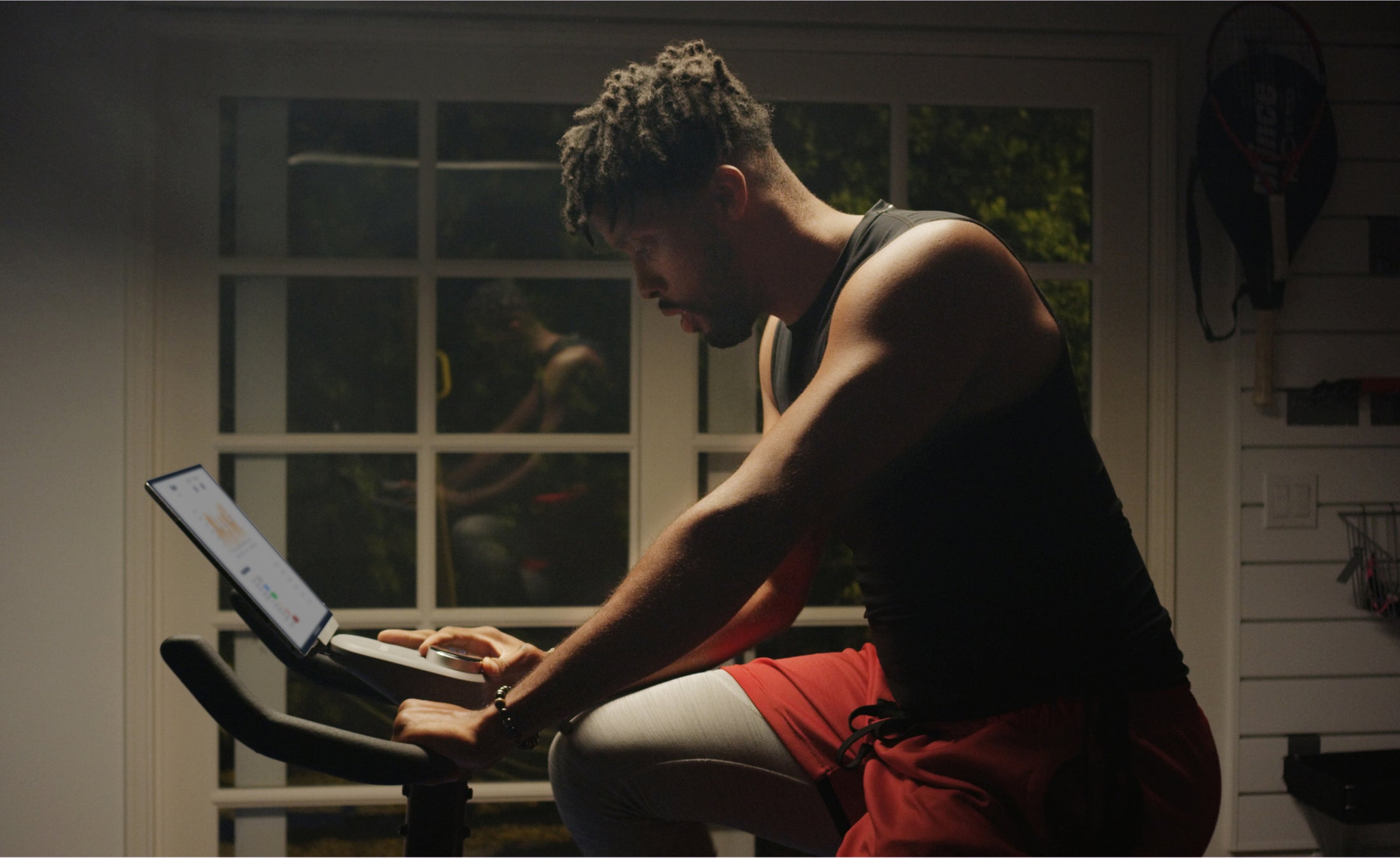
What is Renpho Athlete Mode? Should You Turn It On?
Shipping and taxes calculated at checkout.
Cardio Fitness • General • Gym Fitness • Gym Membership
Designing your fitness journey: how to create a workout plan.
Designing Your Fitness Journey: How to Create a Workout Plan Your journey towards better health is like building a puzzle – you need the right pieces in the right places. One essential piece is a well-structured workout plan. In this article, we’ll walk you through creating a workout plan tailored to your needs, focusing on […]
Published: 11/6/23
Your journey towards better health is like building a puzzle – you need the right pieces in the right places. One essential piece is a well-structured workout plan. In this article, we’ll walk you through creating a workout plan tailored to your needs, focusing on its practical benefits and how it can positively impact your life.
Why You Need a Workout Plan
First, let’s talk about why having a workout plan makes sense:
- Efficiency : Think of it as a roadmap. A workout plan streamlines your efforts, making each workout count towards your goals.
- Goal Achievement : It’s like having a clear destination in mind when you travel. A workout plan helps you reach your fitness objectives effectively.
Setting Your Fitness Goals
Before you start, you must define your fitness goals. This step is essential because it gives your fitness journey purpose and direction.
- Specific Goals : Instead of vague ideas like “getting fit,” aim for specific and measurable targets. For instance, “running a 10k race in six weeks.”
- Measurable Goals : Quantify your goals with numbers and deadlines. This makes tracking your progress easier and keeps you motivated.
Now, let’s explore different types of workout plans tailored to various fitness objectives.
Types of Workout Plans
- Strength Training : If you want to build muscle and strength, consider strength training. It targets different muscle groups and helps with muscle growth. Exercises like squats and pushups are effective for overall strength.
- Cardiovascular Exercise : Cardio workouts are ideal for improving endurance and burning calories. Activities like running, cycling, and swimming are excellent choices.
- Flexibility and Mobility : Don’t forget about flexibility. Incorporating yoga and stretching routines enhances mobility, reduces injury risk, and promotes relaxation. Adding a few cool-down stretches or an effective foam rolling routine at the end of your workout is an easy way to enhance your mobility.
Creating Your Personalized Workout Plan
Now, let’s get down to crafting your personalized workout plan with these practical steps:
Step 1: Assess Your Fitness Level
Begin by understanding your current fitness level, strengths, weaknesses, and any limitations you might have. This self-awareness will guide your plan.
Step 2: Define Your Fitness Goals
Refer back to your specific, measurable goals. With these objectives in mind, you can tailor your workout plan to suit your needs.
Step 3: Choose the Right Exercises
Select exercises that align with your goals and accommodate your current fitness level. Don’t forget to include a mix of resistance training, cardio, and flexibility exercises for a balanced routine.
Step 4: Plan Your Workout Schedule
Create a weekly workout schedule that suits your lifestyle. Here’s a simple example:
- Monday : Upper body strength training
- Tuesday : Cardio workout
- Wednesday : Yoga or stretching for active recovery
- Thursday : Lower body strength training
- Friday : Cardio workout
- Saturday : Flexibility and mobility exercises
- Sunday : Rest day
Step 5: Focus on Progression and Variety
As you progress, update your workout plan to avoid plateaus. Increase weights, reps, or intensity to keep challenging yourself. Variety in your exercises keeps things interesting. You may even want to add in a group exercise class or Team Training session every now and then.
Tips for Consistency and Motivation
Staying consistent and motivated is crucial for long-term success. Here are some practical tips:
- Set Milestones : Celebrate your small achievements along the way. They add up and keep you motivated.
- Workout Buddies : Partnering up with a friend can make workouts more enjoyable and hold you accountable.
- Track Your Progress : Keep a workout journal or use fitness apps to monitor your achievements. Seeing your progress can be motivating.
- Visualize Success : Regularly visualize yourself reaching your fitness goals. This can boost your motivation.
Tracking Progress and Making Adjustments
Remember, your fitness journey is dynamic. Regularly assess your progress and be willing to make adjustments when necessary. If you hit a plateau, consider tweaking your workout routine or nutrition plan. Flexibility is key.
Common Mistakes to Avoid
Avoiding common workout plan mistakes can save you time and frustration. Here are some practical tips:
Overtraining : Avoid pushing your body too hard. Rest is essential for recovery. Consider creating a post-workout recovery routine to ensure you’re recovered well for the workout.
Neglecting Nutrition : Good nutrition complements your workouts. Pay attention to what you eat to support your goals.
Lack of Consistency : Consistency is vital. Skipping workouts can slow your progress.
Ignoring Rest Days : Rest days are essential for helping sore muscles recover and overall well-being. Don’t skip them.
Resources and Tools
To make your fitness journey smoother, consider these practical resources:
Fitness Apps : Apps like MyFitnessPal, Fitbod, or Strong can help you track workouts, set goals, and stay motivated.
Team Training : If you’re unsure where to start, our Team Training HIIT class sessions offer more personalized attention from certified coaches.
Equipment : Depending on your goals, invest in necessary fitness equipment, such as dumbbells, a yoga mat, or a treadmill.
Gym: Joining a local gym can motivate you to complete your workouts and gives you easy access to essential gym equipment. Every Chuze Fitness location is intentionally designed to provide an inclusive and enjoyable workout environment for you to complete your workout plan.
Creating a workout plan is like having a roadmap for your fitness journey. It’s not about dramatic transformations but practical steps towards a healthier you. Your body and mind are a work in progress, and your workout plan is the tool to shape them. So, let’s get started on your journey towards better health, one step at a time.
Chuze Fitness: Your Partner in Running Wellness
Whether you’re preparing for a marathon, enjoying casual jogs, or simply looking to stay active and injury-free, a well-structured stretching routine can make a significant difference in your overall running performance. Remember that stretching should never be painful; a gentle and consistent approach is key.
Chuze Fitness understands the importance of a balanced routine, encompassing not just running, but also strength training, flexibility, and recovery. Just as stretching is vital for a runner’s success, Chuze Fitness offers a wide range of classes and facilities designed to support your overall well-being. So, lace up your running shoes and explore the world of fitness with Chuze. Find a location near you today!
¹Forbes Health. 7 Benefits of Strength Training, According to Experts . https://www.forbes.com/health/fitness/benefits-of-strength-training/
²Mayo Clinic. Stretching: Focus on Flexibility. https://www.mayoclinic.org/healthy-lifestyle/fitness/in-depth/stretching/art-20047931

Ani is the Vice President of Fitness at Chuze Fitness and oversees the group fitness and team training departments. She’s had a 25+ year career in club management, personal training, group exercise and instructor training. Ani lives with her husband and son in San Diego, CA and loves hot yoga, snowboarding and all things wellness.
Related Posts
Denver running trails, el paso activities, outdoor activities san diego, running trails san diego.

Elevate Your Fitness Journey: Insider Tips for Designing Your Dream Home Gym
A n effective home gym starts with choosing equipment that aligns with your exercise preferences and budget. High-quality equipment minimizes injury risks and enhances your workout experience. It's crucial to pick gear that supports your desired exercise types, from cardio to strength training.
Setting Up Your Space
Once you have your equipment, finding a suitable space is next. This area should be free from distractions and easily accessible. Comfort is key, so investing in quality mats, cushioned flooring, and ergonomic equipment is essential. Creating an inviting atmosphere will encourage regular use of your home gym.
Staying Motivated and Flexible
Maintaining motivation is vital for home gym success. Setting clear goals, tracking progress through journals or apps, and being open to routine adjustments are all part of this process. Celebrate your achievements with small rewards to keep your fitness journey enjoyable and sustainable.
Cardio Equipment Essentials
For a well-rounded home gym, consider these cardio machines:
- Treadmills : Ideal for varying workout intensity and tailoring to your fitness level.
- Spin Bikes : Provide a robust full-body workout with adjustable intensity.
- Ellipticals : Offer a full-body workout while being gentle on the joints.
- Rowing Machines : Excellent for overall body conditioning and cardiovascular improvement.
- Stair Climbers : Effective for intense cardio sessions and joint-friendly workouts.
Must-Have Gym Accessories
Beyond machines, certain accessories are invaluable:
- Resistance Bands : Versatile and available in various tensions for a comprehensive workout.
- Free Weights : Essential for strength training, available in multiple sizes and weights.
- Pull-Up Bars : Perfect for upper body workouts, easy to install in any home.
- Jump Ropes : Excellent for cardiovascular health and toning.
- Yoga Mats : Necessary for comfort during stretching and floor exercises.
- Kettlebells and Medicine Balls : Add diversity to your workouts, available in different sizes.
- Wall-Mounted Mirrors : Helpful for monitoring form and technique.
- Foam Rollers and Weighted Vests : Great for enhancing workouts and muscle recovery.
A home gym provides the convenience and privacy to exercise on your terms. With the right equipment and a commitment to your fitness goals, you can enjoy the benefits of a comprehensive workout from the comfort of your home.
This article was co-written using AI and was then heavily edited and optimized by our editorial team.
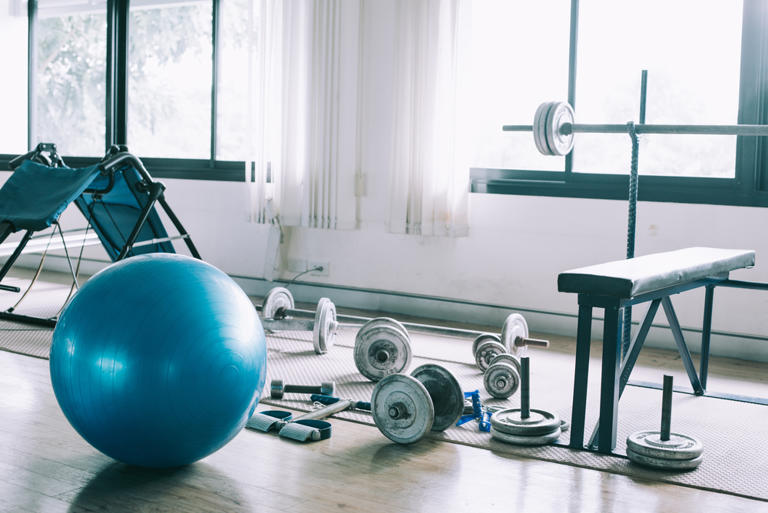
- Intercultural Physical Activity
- Lunch + Lift Workshop Series
- Move More, Learn More
- Move UBC Events
- Move U Crew
- Walk for Joy
- Walking & Rolling Programs
- Memberships
- Child & Youth Programs
- Adult Programs
- Private Lessons
- Aquatics & Lifesaving Certifications
- Youth Programs
- Player Performance
- Baseball Cage Rentals
- Aquatic Centre Schedule
- Fitness Classes Schedule
- SRC Sports Schedule
- Studios Schedule
- Hockey & Skating Schedule
- Moves on MacInnes
- Memberships & Rates
- Group Fitness Schedule
- Women (Trans Women Welcome) & 2STNB Fitness Hours
- Lockers & Locker Rentals
- Cardio, Conditioning, & Strength
- Martial Arts
- Welcome To Personal Training
- Youth programs
- Thunderbird Adult Hockey League
- Drop-In Hockey & Skating Schedule
- Private & Semi-Private Lessons
- Storm the Wall
- Thunderbird Adult Soccer League
- Thunderbird Adult Softball League
- Thunderbird Adult Roundnet League
- Badminton League
- Cross Volleyball League
- Dodgeball League
- Handley Cup Soccer League
- Nitobe Basketball League
- Point Grey Cup Flag Football League
- Pickleball League
- Roundnet League
- SRC Futsal League
- Todd Ice Hockey League
- Ultimate League
- Team Management & Waivers
- Volunteer & Staff Opportunities
- Alpine Skiing SC
- Artistic Swimming SC
- Equestrian SC
- Lacrosse SC
- Nordic Skiing SC
- Quadball SC
- Table Tennis SC
- Women’s Tennis SC
- Men’s Tennis SC
- Triathlon SC
- Women’s Ultimate SC
- Men’s Ultimate SC
- Prospective Athletes
- Team Waivers
- Court Bookings
- Performance Programs
- Search UBC Camps
- Academies & ID Programs
- Fall Pro-D Day & Winter Break Camps
- Spring Break Camps
- Summer Camps
- How to Register
- Withdrawal Info
- Preparing for Camp
- Photo Galleries
- Lockers & Locker Rentals
- Sport Facility Rentals
- Locations & Facilities
- Inclusive Recreation
- UBC Recreation Policies
- Cancellations & Closures
- About Online Registration
- Getting Started with Your CWL
- Online Withdrawals & Cancellations
- UBC Student Rate Eligibilty
The Point Blog

Move U Crew Tips: Starting Your Active Journey
By Puti Hassanah on April 10, 2024
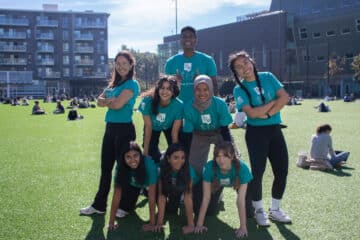
Starting your active journey can feel like stepping into the unknown , but with the Move U Crew by your side, you’re in good company! From beginner-friendly tips to essential do’s and don’ts, our crew members share their insights to help you navigate the world of physical activity with confidence. Whether you’re new to fitness or looking to revitalize your routine, let’s dive in and discover how to kickstart your journey towards a healthier, happier you!
Abishek (He, Him)
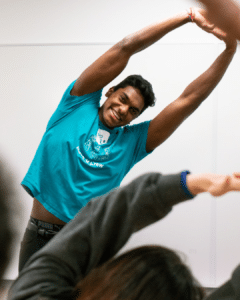
Photo by Tiffany Li
Tip : Incorporate music into your workouts as a source of motivation and enjoyment. One thing that really amps up my workouts is cranking up some tunes. I find that the right music not only boosts my energy but also helps me get into the zone. Find songs that uplift your mood and energize you, creating a personalized playlist that enhances your exercise experience.
Do : Start gradually and listen to your body. Pushing yourself too hard too soon can lead to burnout or injury. Begin with manageable activities and gradually increase intensity or duration as your fitness improves. Embrace your progress and celebrate each milestone along your journey.
Don’t : Compare yourself to others. I know it’s easier said than done but everyone’s fitness journey is unique, and progress varies from person to person. Focus on your own goals, progress, and achievements rather than comparing yourself to others. Recognize that every step you take towards your fitness goals is an achievement worth celebrating.
Bindu (She, Her)

Tip : Open up your horizons with physical activity! A routine is a great way to keep us consistent in our movement journey but it can get boring at times. But I find it baffling that there are so many ways to get our bodies moving from kickboxing to yoga to badminton (which I’ve definitely tried and enjoyed a lot)! So really just immersing yourself in the tremendous variety of moving is the way to go!
Do : Try to understand why physical activity is important for you! This helps encompass your journey into a holistic one where moving your body helps enrich your physical, mental, emotional and even social wellbeing! Personally, physical activity is a way for me to get to know myself better and what my body is capable of doing while improving my quality of life.
Don’t : Forget to fuel your body with FOOD! Exercise and nutrition go hand in hand when it comes to leading a healthy lifestyle. Fuel your body with nutritious foods that provide the energy and nutrients needed for physical activity. Of course, there is no one-size-fits-all but I encourage you to reframe your mindset in a way that guides you in a positive direction!
Chelsea (She, Her)

Photo by Macy Yap
Tip : Find a form of activity that you genuinely enjoy! When I started exercising, I tried copying what people around me were doing, like running. It was only once I accepted that running wasn’t for me, but rather other forms of movement, such as boxing and weightlifting, that made me look forward to moving!
Do : Make movement social! I invite all my friends to fitness classes I go to off campus, especially since studios tend to offer the first visit free for first timers.
Don’t : Be hard on yourself for not moving all the time. Life can get in the way and starting a new commitment is scary for anyone. Be kind to yourself as you navigate a new relationship with your body and movement!
Farrah (She, Her)

Tip : Start slow and create realistic goals for yourself. It is easy to say that you will exercise every day, and a lot harder to follow through with something so intense. When you are just starting a fitness program or exercise routine, setting realistic but challenging goals is going to motivate you in the best way!
Do : Show yourself some grace! We all have those days where we find it harder to follow through with exercise goals and schoolwork and life get in the way. You always need rest days and some time to breathe and unwind. Allow yourself to go through your fitness journey at your own pace.
Don’t : Never skip warming up and cooling down. It is so important to ease into exercising whether you are playing a sport, running, or weightlifting. Spend a few minutes raising your heart rate and energizing your body! Always end off with stretches and a cool down to reduce the soreness you feel the following day.
Isabel (She, Her)

Tip : Find someone or a group of people to get moving with! I have found that I am most consistent with getting active when I join sports teams or have workout buddies. For me, the social aspect of physical activity is almost as important as actually moving!
Do : Try different forms of physical activity to see what you like. Consider trying out both indoor and outdoor workouts, individual and group settings, as well as sports and more relaxed activities. The best activities are the ones you enjoy doing!
Don’t : Hyper-focus on the visible physical changes that accompany activity. It can be demoralizing if you are working out just for the sake of seeing physical changes and they are slow to come. Try focusing on how moving makes you feel! I can’t speak for everyone, but when I stopped focusing on how exercise could change my body and instead on the mental health benefits and getting better at the activities I was doing, I started to have a much healthier and more sustainable relationship with movement.
Puti (She, Her)
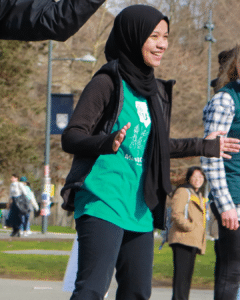
Do : Check out the Move U Crew program and events. There’s a wide variety of activities available, from group fitness classes to outdoor activities. Exploring different options can help you discover what activities you enjoy most and what fits best into your routine. Plus, participating in group activities can provide motivation, support, and a sense of community.
Don’t : Overlook the importance of rest and recovery. While it’s essential to stay active and motivated, it’s equally important to give your body time to rest and recover between workouts. Listen to your body and prioritize adequate rest and recovery to optimize your performance and prevent injury.
Ray (She, Her)

Tip : Find a type of movement you truly enjoy! It might mean trying a bunch of new things at first, but eventually, you may find something that you look forward to doing. Some ideas include going to group classes like yoga or Pilates, joining an intramurals team, doing workout videos online, outdoor activities, etc. All movement is valuable!
Do : Reflect on your ‘inner critic’ and practice self-compassion. It’s as simple as saying encouraging things to yourself just as you would to a friend. Starting your movement journey can feel intimidating and overwhelming, and that’s totally normal! But try to stay positive and give yourself grace throughout the process!
Don’t : Forget your water bottle – trust me, I’ve been there. It sounds silly, but show up to your workouts prepared! Having the equipment you need (water, music, maybe a good pair of shoes or Pilates socks, or whatever else you need) will make the experience more comfortable/doable.
Sam (She, Her)
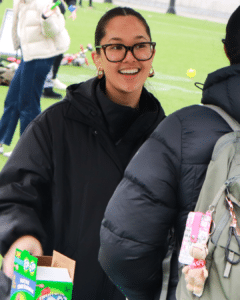
Tip : Don’t be afraid to experiment and try new things! Finding different ways to move your body can keep it fresh and exciting. You may also find a new form of exercise that you enjoy which makes moving so much more fun and enjoyable.
Do : Give yourself grace. Be kind to yourself, encourage yourself, and keep your inner narrative positive. Talk to yourself as if you were talking to a friend. It can be easy to focus on the negative or get down on yourself when trying something new but you should be proud of stepping out of your comfort zone!
Don’t : Get caught up in being perfect. Making new habits and learning new skills take time. Choose to focus on your achievements even if they seem small, over time, they will amount to big impacts on your overall well-being.
Feeling inspired? Keep these tips close as you embark on your active journey. Remember, every small step counts towards a healthier, happier you. If you would like to talk to a Move U Crew member about your movement goals one-on-one, feel free to book a free peer physical activity coaching session ! Stay motivated, stay moving, and never forget: you’ve got this!
Posted in 2024 , Active At Home , Move U Crew Stories , Move UBC , Physical Activity , The Point Blog
- Training Tips
'I was unfit and overweight. Now I'm a fitness icon at 78'
She's shaking up the fitness world
Our articles are dedicated to helping you find the right product at the right price. We may receive revenue from affiliate and advertising partnerships for sharing this content and when you make a purchase. Learn more

TikTok’s convinced women should ‘cycle sync’ their workouts – but is it worth trying yourself?
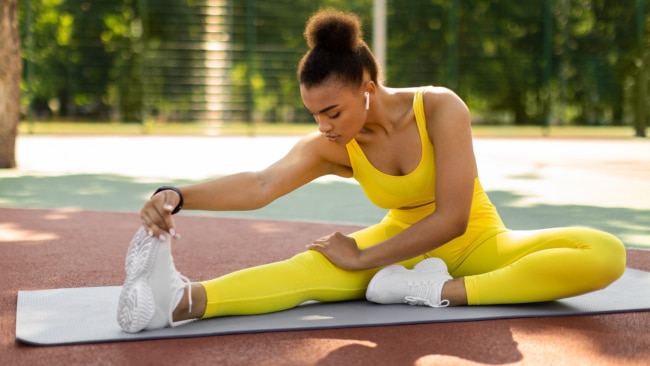
‘I tricked myself back into exercise – here’s how’

5 fitness rules women should actually listen to

Joan MacDonald is entirely untroubled by bingo wings. So taut and sculpted are her triceps, in fact, that she’s been accused of using steroids (she hasn’t), while you could crack Brazil nuts with her biceps. She can bench press 45kg, do the splits and perform full push-ups.
She lifts weights for 90 minutes four times a week and does cardio training daily, while her meticulously planned and portioned diet is heavy on the egg whites and protein powder.
It all pays off, mind you – at 78 years old, she has 1.9 million followers on Instagram and pulls in a comfortable income from brand endorsements and subscriptions to her fitness platform, Train with Joan.
MacDonald is the first to admit that, seven years ago, a future as a global fitness influencer was not on the cards. Back then, she weighed more than 89kg at 160cm tall, was on medication for high blood pressure , high cholesterol and acid reflux, and climbing the stairs left her struggling for breath.
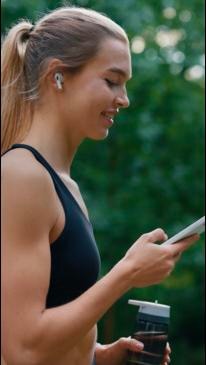
Today, she Zooms in from a white, sun-filled apartment in Tulum, Mexico, where she lives part of the year with her daughter Michelle, a 53-year-old bodybuilder and fitness coach, and her son-in-law JJ. The rest of the year she spends in her native Canada.
In a white shirt, gold-rimmed specs and a tawny shade of lipstick, which she’s taken to only since becoming an Instagram sensation (previously, she confesses, she believed lipstick “made you look like a hooker”), MacDonald is glowing and vital, a compelling advert for the disciplined lifestyle she endorses.
But, she says, it’s been a rough few months. Late last year, her husband Norm died following a fall that caused a serious brain bleed. They’d been married for 56 years, and MacDonald grows teary talking about him. “I’m not one that can hide my emotions very well,” she says.
To glance at her Instagram account @trainwithjoan though, packed with motivational mantras, you’d have little idea she’d been through a lot. There are perky gym selfies, swimsuit shots and pictures of the sprightly septuagenarian looking trim in form-fitting jumpsuits.
“You can’t wallow in what could have been – you’ve just got to go on,” she says. “And all you can think about is the best times you had with them.”

MacDonald’s “transformation” – a word she invokes often – has been primarily physical: from a 99cm waist at 70, it’s now 71cm. “I did get down to [66cm] – I don’t know how that happened, but I looked kind of thin to me,” she muses. “My hips were 107cm or something, and now they’re 94cm. And I lost 10cm off each of my thighs.”
But it also goes beyond the merely corporeal. “I didn’t start living until I started transforming,” she says. “And that’s because I changed everything. I changed my sleeping habits. I changed my eating habits. I changed the way I think about myself – and I’m still changing there. It’s something that’s ongoing, that mindset.”
On paper, MacDonald’s words can sound hackneyed, like some sort of fitness Tony Robbins, littering her conversation with “visualisations”, “manifestations” and “habit stacking”.
In person, however – perhaps it’s the Canadian accent or her evident surprise, still, at where she’s found herself – it feels much more authentic, inclusive and genuinely inspiring.
Among her generation, she says, “So many women are afraid to go to the gym. They say, ‘I don’t want muscle,’ and I guess I was the same way. I didn’t want to look like a guy.” She pauses. “But I don’t look like a guy. I do have muscles, but they don’t look bad.”
At the other pole is the myth you can’t build muscle tone after a certain age. “Hogwash,” says MacDonald.
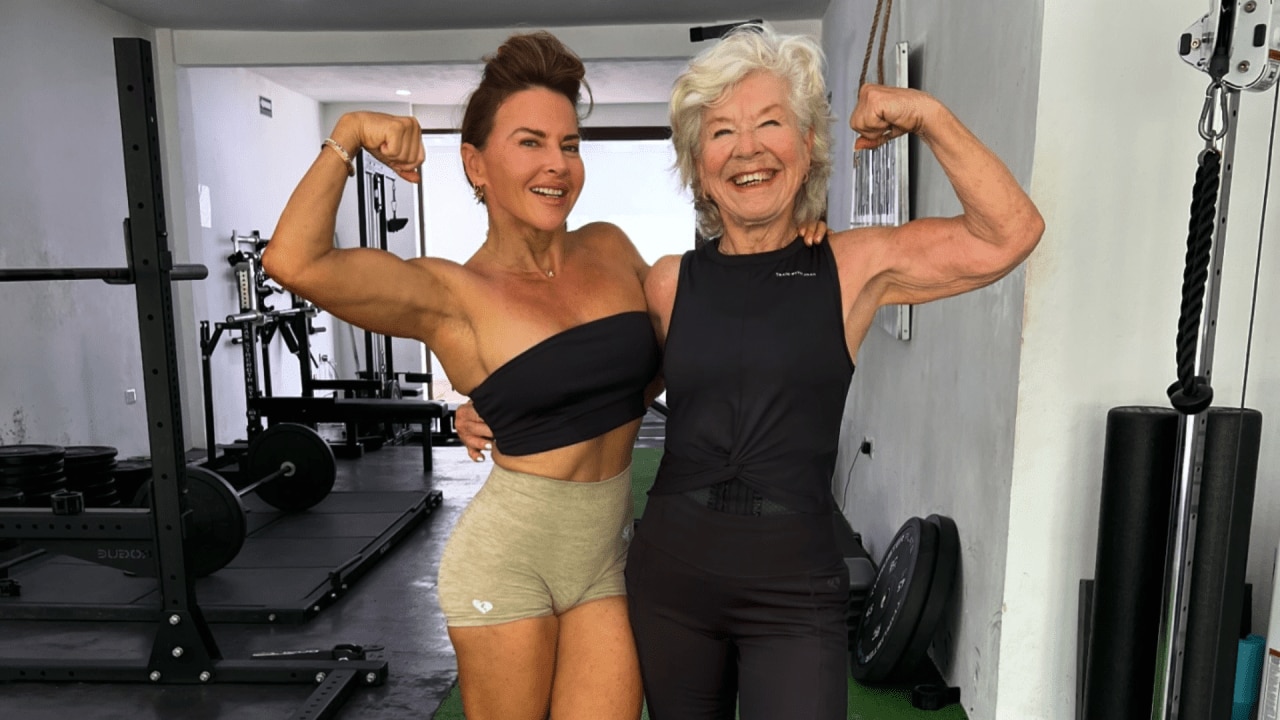
Born in Newfoundland – where her father hunted and fished for some of the family’s food and the staple diet included elk, moose and bear – MacDonald grew up in Ontario, the second of seven children and the oldest girl. “I was second mum to my siblings,” she says.
She met Norm at work – doing administration in local government – got married in her early 20s and had three children. She put on weight with each pregnancy, she says, “and then got bigger after each baby was born. And then I started thinking this was just who I was. That this was the weight I was supposed to carry. By the time I was in my 50s, I’d pretty much given up.”
She had friends more overweight than she was. “I consoled myself with that comparison. I wasn’t fat – I just needed to lose a few pounds. I put off doing things I wanted to do because my weight was in the way,” she admits. “I knew I was overweight, but when I saw photos of myself I’d think, ‘It’s the camera.’”
It was hard, she reflects, to overcome the ingrained idea that, “You should never put yourself first. You were there to care for your family,” she says. “Anything that we’d now call ‘self-care’ was regarded as selfishness.”

Then, one Christmas in Mexico, Michelle watched her mother struggle, huffing and puffing up the stairs. Michelle had always been sporty and was, in her 20s, a competitive snowboarder. She is now a championship bodybuilder and runs The Wonder Women, a team of female fitness coaches dedicated to teaching other women.
She sat her mother down and dispensed some tough love. Joan was going to end up like her own mother, in a nursing home, she said. Did Joan want other people to have to look after her? She could help, she said, but she needed her mother to join her training group.
“She didn’t hold anything back that day. I had to listen to her and it was a reversal of roles,” says MacDonald. Michelle said that she and her husband were off to the gym. “I thought, ‘Well, if she helps other people, maybe she could help me,’” says MacDonald. She remembers finishing the first exercise that first day “and collapsing” but, within a few days, feeling a growing sense of commitment. “It was like learning a different language,” she says.
Michelle’s coaching program requires participants to photograph themselves at regular intervals. “The first thing that got to me was having to take those before-and-after shots,” says MacDonald with a groan. “You have face-on, side-on and back-on. Taking those pictures when I was that big, I was horrified.” But, she says, they were crucial. “Because you do not remember exactly what you looked like. And if nothing else can motivate you, that will.”

Even more challenging, however, was the tech. “I’d only had an iPad for about a year before I got started with this. I didn’t have a phone or a computer that I could really do things with.” Back in Canada, she struggled to download the PDF workout sheets she was sent.
Yet MacDonald persevered and was soon seeing dramatic results. In six months she had lost 20kg. After a year, she’d lost another 6kg. She now weighs just over 57kg. Michelle realised the powerful potential of her mother’s journey and in 2018 launched her on Instagram as Train with Joan.
After such a tremendous weight loss and suddenly being on social media, did she feel the need to buy a whole new wardrobe? “Yes, but I was afraid to buy too much because I thought, ‘Well, if I’m continuing to lose weight, I can’t afford to buy new clothes all the time,’” insists MacDonald. “I was on a pension and had to be careful with my money.”
She bought a few pieces and, she says, “Workout clothes stretch, so you don’t need to replace them all the time.” But one of the great joys of her new body was “that I now get to dress the way I always wanted but didn’t think I could before”. And thanks to her epic social media stardom, “When I see something that I really like, I don’t even look at the price tag anymore. If it looks good on, I’ll just get it.
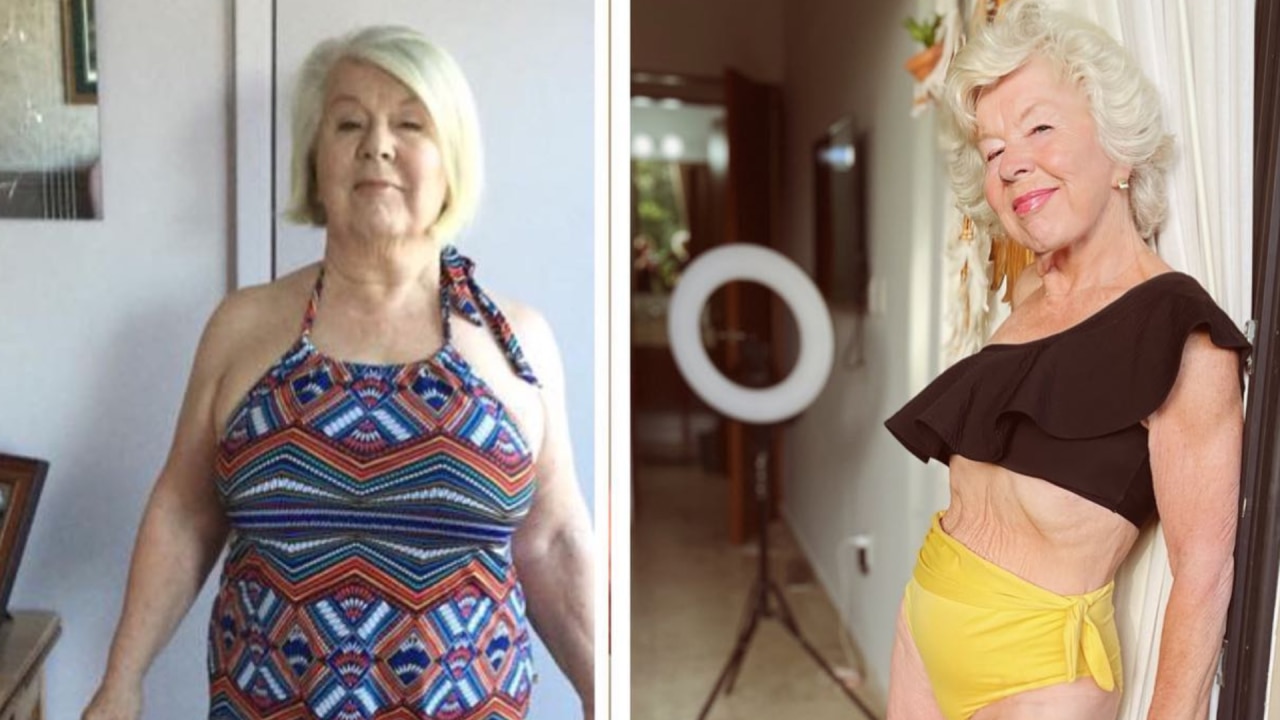
“I have no idea what my [financial] worth is,” she says with a shrug. She doesn’t look after the business side. “All I know is I can do things I never used to be able to do. Like travelling.” And the eyelid surgery she underwent in 2019.
MacDonald is rigorous about meal planning, aiming for a daily intake of 150g protein, 120g carbs and 40g fat. She eats five small meals a day at three-hour intervals, starting the day with porridge before having a second meal of egg whites, cheese, lean protein, vegetables and an English muffin.
Meal three is yoghurt, blueberries and protein powder. The next is a lot of vegetables plus protein, and meal five –really not a meal at all in anyone’s book – is coconut water and protein powder blended with ice. “It’s like a parfait, like dessert,” claims MacDonald.
And she doesn’t drink. “It’s a waste of calories. And wine puts me to sleep.”
Does she never – especially when in Tulum – pop down the road for a burrito? “Burritos aren’t that bad, if you know what’s in them and how they’re made,” she says, thereby discounting the whole point of a burrito to many of us.

“I do treat myself once in a blue moon.”
MacDonald clearly has discipline in spades, but, she says with evident regret, could not convince her husband to join her in her new regimen.
“When I met him, he was very active,” she says. “He was a good baseball player, a good hockey player. But he lost interest. In his 50s he just dropped everything, which was kind of sad.”
While she was pulling on lycra and heading to the gym, “He stayed at home,” she says. “I tried to persuade him, but you have to be in that mindset.” Which is not to say Norm wasn’t proud of his wife’s efforts. “Oh, he bragged about me when I wasn’t around,” she laughs.
Although the idea behind her platform was to encourage other older people to become active, MacDonald reports “most of my following is younger people, late 20s upwards”. Many of them, she says, want to help parents or friends.
Michelle runs the account but MacDonald responds to all the questions and comments herself. “I’ve been told I spend too much time doing that,” she says with a sigh. “I just feel they put the time in to read and ask questions so they deserve an answer. But I’m very slow and I have to think things out, and you don’t want to hurt anyone’s feelings.”
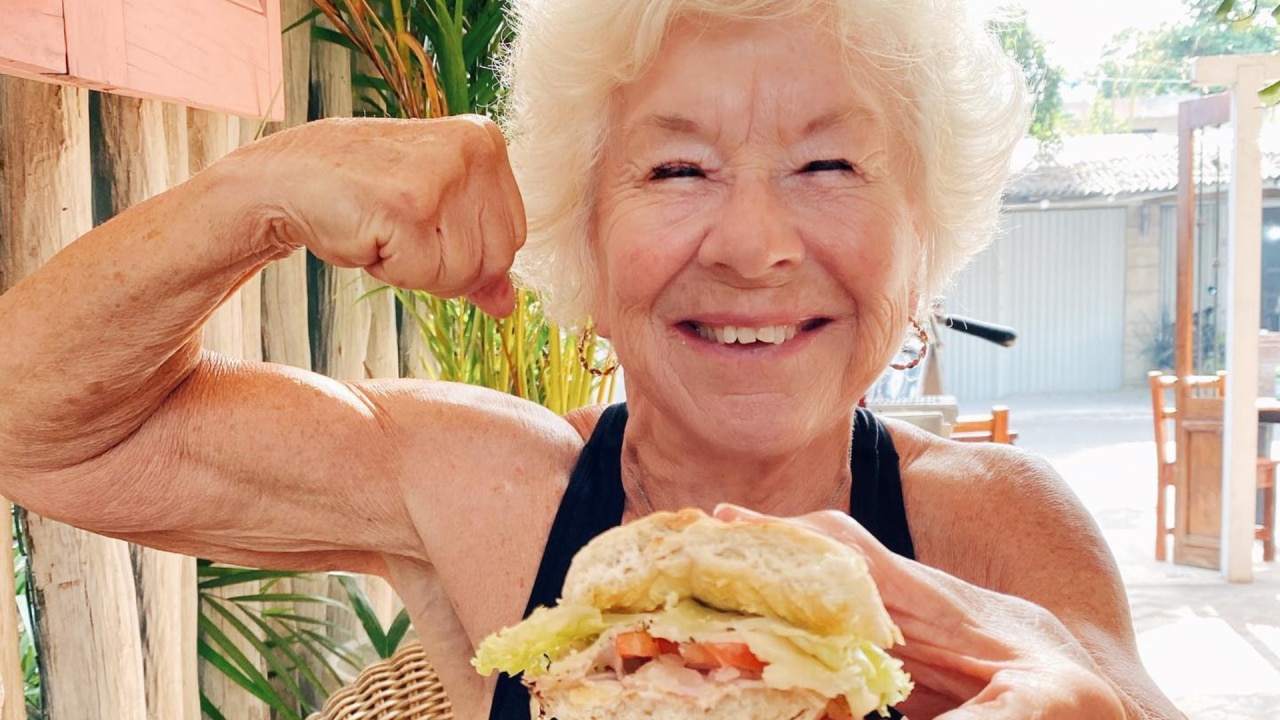
She has also established a reputation for “telling it like it is”, she says. “If someone is saying, ‘I can’t do this,’ or, ‘That didn’t work for me,’ I’m going to say, ‘Did you put your all into it? Because if you did, you wouldn’t be saying that as you would have results.’”
For all that MacDonald is softly spoken and amiable, it’s clear she takes no prisoners. Of her peers who accept the advice of doctors unquestioningly, she says, “They don’t want to try anything different. I’m going, ‘All you have to do is give up those cupcakes.’”
Of men growing complacent, she says, “They get too damn comfortable. They don’t want the challenge any more.”
“You have to change the story,” she says. “Stop feeling sorry for yourself. There are no easy answers to anything in life. You have to own your mistakes and that’s a hard pill to swallow, but you feel better when you do something about it.”

Even after losing Norm, MacDonald hasn’t deviated from her regimen. “It’s part of my life now,” she says. “And, all in all, I feel a heck of a lot happier than I did seven years ago.” A few days after we speak, she’ll be heading to Canada to organise her late husband’s estate.
After that, she hopes to travel more. “I’ve never been to Europe. And I would just like to see more people – more women, especially, but it wouldn’t hurt for men, too – taking life in their own hands and making a commitment to be healthy,” she says. “I would sooner see more people doing preventative care than fighting for more healthcare funding.”
Ultimately, she believes, we all have it within us to be ‘more Joan’. “You don’t have to accept ill health or an erosion of your life. It’s not a done deal unless you want it to be.”
Joan’s not-so-secret tips for regaining your health at any age
#1. Eat more protein
“Eat at least 1g of protein for every pound [500g] you weigh, based on your ideal healthy body weight. The older we get, eat more not less of it.”
#2 .Create a diet rich in quality produce
“Choose vegetables from all the colours of the rainbow, as well as healthy fats like cheese, nuts and avocado, plus quality starches like sweet potato and rolled oats.”
#3. Strength train
“Even three times a week for 30 to 45 minutes can do wonders for bringing back your reflexes, general strength and tone. Exercising with weights is one of the best antidotes to the muscle loss and poor posture that we generally see with ageing.”
#4. Find more joy in your life
“Surround yourself with people who help you flourish. Do things that bring abundance into your life. You are the only one who can make yourself happy.”
More Coverage

#5. Keep learning
“Develop a growth mindset; chase after things that expand your mind and challenge your thinking.”
Feeling inspired? Read Joan's full story in her book Flex Your Age: Defying Stereotypes & Reclaiming Empowerment, $42.99 from amazon.com.au
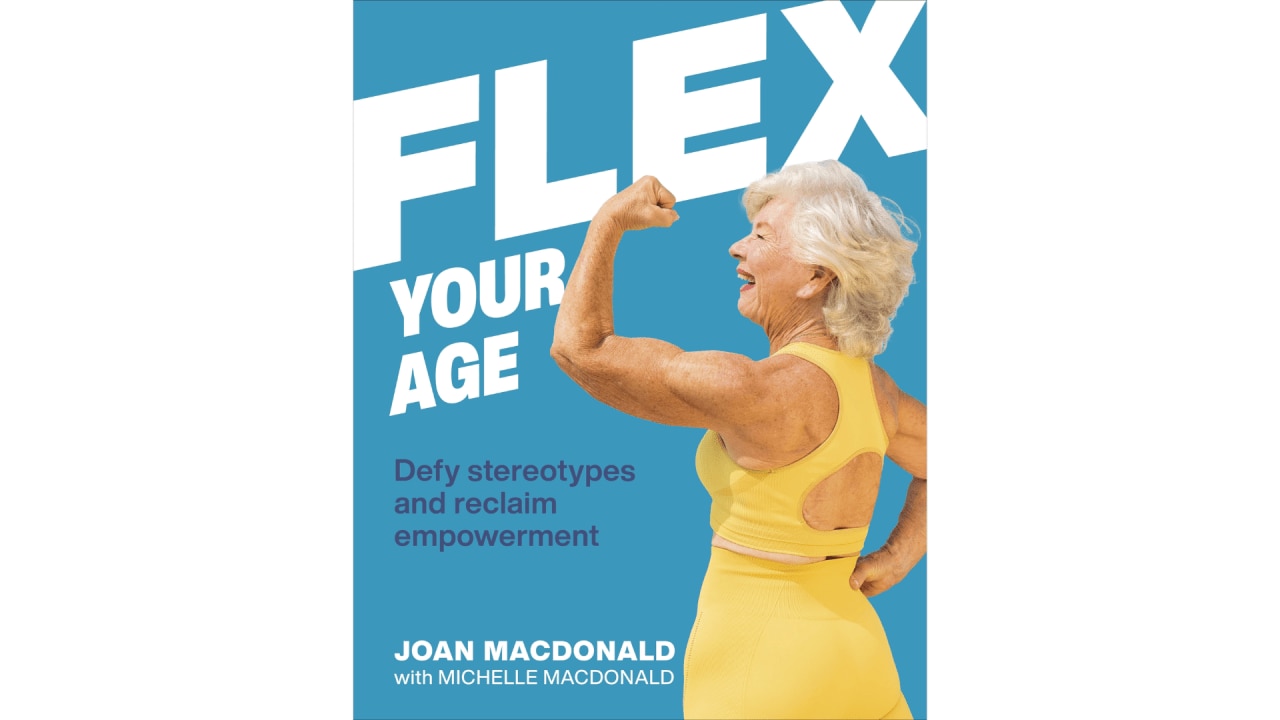
Here's what the experts say
Go from couch to crushing it
The ultimate guide is finally here
This 7-Day Diet Plan For Weight Loss Helps You Eat Healthy And Stay Full
Here's how to pack your plate for long-term results.

Devoting time to meal prep can be a helpful component of weight loss, she says. “For many individuals, planning ahead is key to successful weight loss since it may help decrease the guesswork and negative outside influences at meal time,” Gans says. To help, she has offered up several healthy food options that will help you stay full, satisfied, and support your weight loss goals.
Check out the 7-day meal plan for weight loss below, including a handy grocery list to take with you on your next stopping trip (because eating healthy shouldn’t be complicated).
Meet the expert: Keri Gans , RD, is a New York City-based nutritionist and the author of The Small Change Diet .
7-Day Diet Plan For Weight Loss
Every meal on this eating plan is a good mix of protein, fat, and carbs to help you fill up, stay satisfied, and hold your blood sugar steady—all key factors in losing weight.
Breakfast : A piece of 100 percent whole wheat toast topped with half an avocado, two slices of tomato, and two poached eggs
Lunch : Mixed green salad with carrots, cucumbers, ½ avocado sliced, and 3 to 4 ounces broiled salmon, topped with a dash of olive oil and vinegar
Snack: Three cups air-popped popcorn
Dinner : One cup of cooked pasta (whatever kind you prefer) tossed with 3 ounces of grilled shrimp, as much asparagus as you want, sautéed garlic, and a dash of olive oil
Breakfast : One cup cooked oatmeal mixed with one tablespoon of peanut butter and a medium-sized banana sliced on top
Lunch: Fresh roasted turkey sandwich on 100 percent whole wheat bread with lettuce, sliced tomato, and 1 tablespoon of mayo (or drizzle of olive oil)
Snack: ¼ cup raw almonds
Dinner : Three to four ounces of broiled salmon with baked potato (you can add a pat of butter or dollop of sour cream), and as much broccoli as you want
Snack: Two pieces of dark chocolate
Dinner : Four ounces of grilled chicken breast with one medium-sized sweet potato and sautéed spinach
Breakfast : A cup of plain Greek or Icelandic yogurt topped with 1 cup of sliced strawberries and 1 ounce of sliced almonds
Lunch : One individual can of tuna mixed with 1 tablespoon of mayo (or dash of olive oil) on 100% whole grain bread, topped with lettuce, two slices of tomato, and a few slivers of red onion
Snack: A small handful of dates
Dinner : Four ounces of grilled chicken breast with one medium-sized sweet potato, steamed, and sautéed spinach
Breakfast : One cup of cooked oatmeal mixed with one tablespoon of peanut butter and a medium-sized banana sliced on top
Snack: Carrot or celery sticks dipped in ½ cup cottage cheese
Dinner : One cup of cooked pasta (whatever kind you prefer) tossed with 3 ounces of grilled shrimp, as much asparagus as you want, sautéed garlic, and dash of olive oil
Breakfast : One piece of 100 percent whole wheat toast topped with half an avocado, two slices of tomato, and two poached eggs
Lunch : Fresh roasted turkey sandwich on 100% whole wheat bread with lettuce, sliced tomato, and 1 tablespoon of mayo (or drizzle of olive oil)
Snack: Hummus with pita chips and/or veggies for dipping
Lunch : Fresh roasted turkey sandwich on 100 percent whole wheat bread with lettuce, sliced tomato, and 1 tablespoon of mayo (or drizzle of olive oil)
Snack: One cup raspberries, blueberries, or strawberries
Dinner : One cup of cooked pasta (or zucchini noodles!) tossed with 3 ounces of grilled shrimp, as much asparagus as you want, sautéed garlic, and dash of olive oil
7-Day Healthy Eating Plan
Add this list of food staples to your pantry to encourage healthy meals all week long.
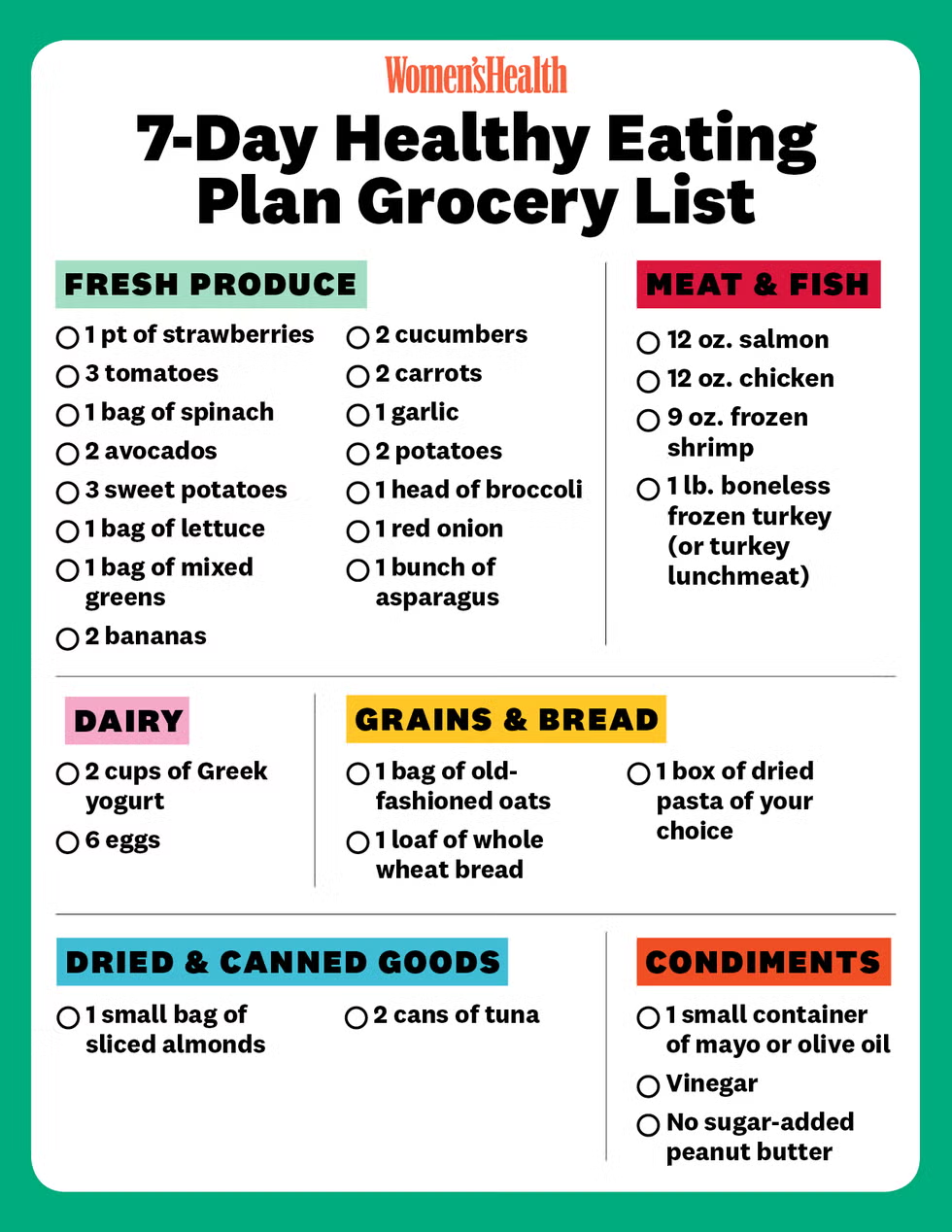
- Greek yogurt (2 cups)
- Pint of strawberries
- Tomatoes (3)
- Avocado (2)
- Sweet potatoes (3)
- Mixed greens
- Bananas (2)
- Garlic clove
- Baked potato (2)
- Zucchini (1)
- Red onion (1)
- Container of old-fashioned oats
- Sliced almonds (2 ounces)
- No sugar-added peanut butter
- Loaf of whole wheat bread
- Dried pasta of your choice (3 cups)
- Salmon (12 ounces)
- Chicken (12 ounces)
- Frozen shrimp (9 ounces)
- Individual can of tuna (2)
- Boneless frozen turkey (or 1 pound of turkey lunchmeat)
- Small container of mayo or olive oil
- Air-popped popcorn
- Raw almonds
- Dark chocolate
- Cottage cheese
- Raspberries
- Strawberries
- Blueberries
Tips For Weight Loss
Being on a weight loss journey can feel overwhelming, but little changes go a long way. In addition to following the above meal template, prioritizing nutrient-packed foods can help you feel satiated while dropping weight sustainably.
One pro tip? Add more veggies and fiber-rich foods to your routine. "Always start your dinner and lunch with a large mixed green salad [and] light on the dressing of your choice," Gans says. "Salads are packed with fiber and help to fill you up."
If you love dessert and snacking throughout the day, try a cup of berries or a piece of fruit, like oranges and apples. Over time, this can help satisfy your sweet tooth while encouraging less-processed foods—which is key for losing weight in a healthy way.
Emily Shiffer has worked as a writer for over 10 years, covering everything from health and wellness to entertainment and celebrities. She previously was on staff at SUCCESS , Men's Health , and Prevention magazines. Her freelance writing has been featured in Women's Health , Runner's World , PEOPLE , and more. Emily is a graduate of Northwestern University, where she majored in magazine journalism at the Medill School of Journalism and minored in musicology. Currently residing in Charleston, South Carolina, Emily enjoys instructing barre, surfing, and long walks on the beach with her miniature Dachshund, Gertrude.
WH Exclusives
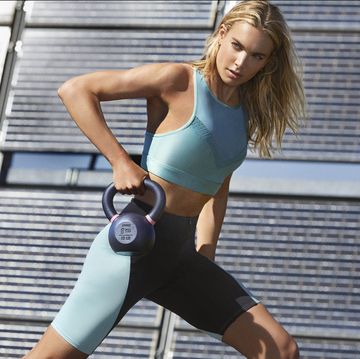
3 Ways To Nix Knee Pain During Lunges
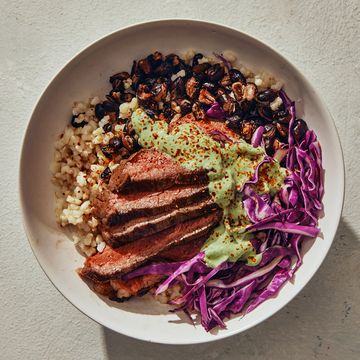
Steak Burrito Bowl Salad Recipe
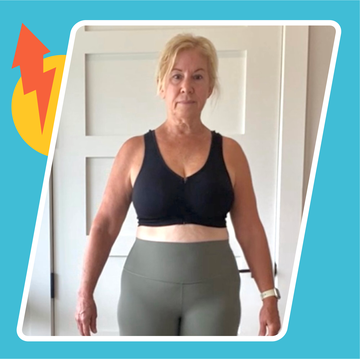
'Resistance Training Reversed My Osteoporosis'
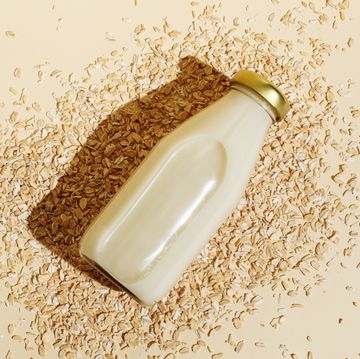
Is ‘Oatzempic’ Legit For Weight Loss?
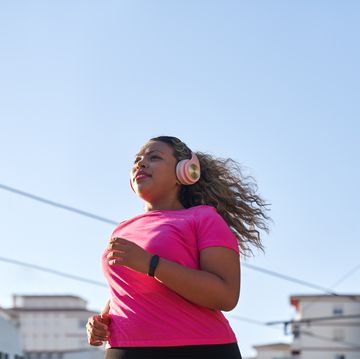
Here's How Walking Can Help You Lose Weight Fast
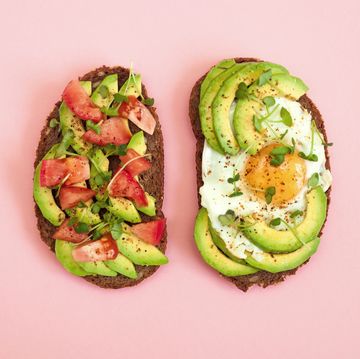
25 Best Low-Calorie Foods To Support Weight Loss
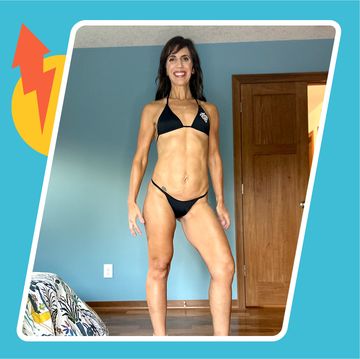
‘I Tried Every Diet, But This Changed Everything'
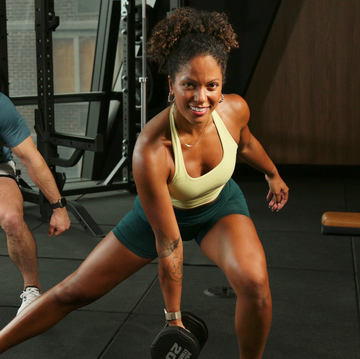
Try This 20-Minute Dumbbell Arms And Abs Workout

10 Remedies To Help With Facial Puffiness

10 Ways To Naturally Reduce Water Weight

What To Eat During 75 Hard, According To RDs

IMAGES
VIDEO
COMMENTS
Starting a fitness journey can be intimidating. There are workouts to learn, diets to follow, willpower to conjure, and self-consciousness to overcome. But making the decision to start a fitness regimen and making strides toward improving your health are the absolute best things you can do for yourself—mind and body.So give yourself a big pat on the back, then listen to the sage advice of ...
5. Don't cut static stretching out altogether. After your workout, static stretching is just fine. In fact, it can help prevent muscle stiffness, according to the Cleveland Clinic. Just make sure ...
A "rep" is a single repetition of a given exercise; think curling a dumbbell up and lowering it back down again. A "set" is a cluster of repetitions performed back-to-back with no rest in ...
Keep Your Mindset (and Self-Talk) Positive. Pro tip: Remember to be thankful for what your body can do. Start each workout by saying (in your head or out loud) one part of your body that you're ...
Here are our top five tips to get you started off on the right foot so you can meet your goals! Know your goals. Find your "why.". Going to the gym without goals in mind can be like driving a car without a destination. When creating a goal, it can be beneficial to think about the process that it takes to accomplish your goal.
0. Embarking on a fitness journey refers to the intentional and structured pursuit of improving one's physical fitness, overall health, and well-being. It involves setting goals, adopting healthy lifestyle habits, and engaging in regular exercise and physical activity to achieve desired outcomes. A fitness journey is a personal and ...
Moving, resting, and, above all, patience, will keep you on a good path to your fitness goals. Sandra Gutierrez is the former Associate DIY editor at Popular Science. She makes a living by turning ...
1. Look inside and find your "why". No journey worth pursuing just happens. There's a strong "why" behind it that propels it forward and keeps it going when, well, the going gets tough. If for example, your main motivation for starting a new fitness journey is that you want to be skinny again, your chance of long-term success is nil.
Tips for structuring your workouts, including warm-up, main exercises, and cooldown. 4. Starting with the Basics: Essential exercises and movements for beginners, such as bodyweight exercises, resistance band workouts, and beginner-friendly equipment. Proper form and technique for each exercise to ensure safety and maximize effectiveness.
Prioritize rest, sleep, and proper nutrition. Treat yourself with kindness and listen to your body's needs. Nurturing your physical and mental well-being will optimize your energy levels and overall motivation. The Bottom Line. Staying motivated on your fitness journey is a lifelong process.
Day 3: Cardio, Strength, and Stretch. Workout 1: Beginner walking or cycling — Length: 10 to 13 Minutes. Workout 2: Basic strength— Equipment Required: Light dumbbells, an exercise ball or chair, and a mat— Length: 10 to 15 minutes. Workout 3: Soothing stretch.
10. Don't skip your warm-up and cool down. "Warm-up before starting your routine—a proper warm-up [with dynamic stretching] is important to get the body ready for injury-free movement. Take ...
Set SMART goals. This mnemonic device for goal setting is popular for a reason—because it works. SMART stands for: Specific. Make sure your goal is specific rather than being broad and vague. For example, instead of a goal of "get stronger," a better goal might be to "build up the strength to do push-ups.". Measurable.
Fitness Tips. 16 Clever Ways to Boost Workout Motivation, According to Trainers ... Connecting positive experiences with your fitness journey reinforces the idea that exercise is a rewarding and ...
Fat loss: Bodyweight x 10-12. Maintain weight: Bodyweight x 13-15. Gain weight: Bodyweight x 16-18. Example: 150 x 10 = 1,500 and 150 x 120 = 1,800 (Between 1,500 and 1,800) You don't need to count calories to be successful. But as Yale researchers showed us, for fat loss creating a calorie deficit is important.
1. Set Realistic Goals. To begin a fitness journey, it is important to establish practical objectives/goals. These objectives should be attainable, precise, quantifiable, and have a time limit. For instance, rather than aiming to shed 50 pounds in a month, strive to lose 1-2 pounds every week for six months. 2. Find an Exercise You Enjoy.
Best Weight Loss Diets. No. 1. WeightWatchers. WeightWatchers is focused on inspiring members to eat healthier and move more for improved health overall. No. 2. Mediterranean Diet. This diet ...
Aim to get in two or three sessions a week and do a minimum of one set for each major muscle group. To maximize your time, do compound movements that involve more than one muscle group at a time (i.e. squats, push-ups, lunges and rows). Include joint stability and core into your program (i.e. planks, bridges).
Catie Dull/NPR. Exercise can look like a lot of different things — lifting weights and doing circuits, yoga and spin classes. "Find a fitness facility that resonates with you," suggests Howell ...
4. Start with Baby Steps. It is best to start your fitness journey little by little. There's no need to run a marathon or lift weights on Day 1, or you'll end up getting injured and discouraged. Start with 15 to 30 minutes of daily cardio with your AI Smart Bike to establish a regular exercise habit.
Step 5: Focus on Progression and Variety. As you progress, update your workout plan to avoid plateaus. Increase weights, reps, or intensity to keep challenging yourself. Variety in your exercises keeps things interesting. You may even want to add in a group exercise class or Team Training session every now and then.
Reality: You don't need to spend hours in the gym every day to see results. For beginners, even 30 minutes of exercise per day can be beneficial. Focus on quality over quantity and gradually increase the duration and intensity of your workouts as you get stronger. Myth: Cardio is the only way to lose weight.
Kettlebells and Medicine Balls: Add diversity to your workouts, available in different sizes. Wall-Mounted Mirrors: Helpful for monitoring form and technique. Foam Rollers and Weighted Vests ...
From beginner-friendly tips to essential do's and don'ts, our crew members share their insights to help you navigate the world of physical activity with confidence. Whether you're new to fitness or looking to revitalize your routine, let's dive in and discover how to kickstart your journey towards a healthier, happier you!
Joan's not-so-secret tips for regaining your health at any age. #1. Eat more protein. "Eat at least 1g of protein for every pound [500g] you weigh, based on your ideal healthy body weight. The ...
Day 7. Breakfast: A cup of plain Greek or Icelandic yogurt topped with 1 cup of sliced strawberries and 1 ounce of sliced almonds. Lunch: Fresh roasted turkey sandwich on 100 percent whole wheat ...
By embracing a holistic approach to fitness, Wilson was able to maximize calorie expenditure, build lean muscle mass, and improve cardiovascular health, all essential components of a successful weight loss strategy. ... Insider Tips 3. Journey to Success: Lainey Wilson's Weight Loss Secrets 4. Lainey Wilson's Weight Loss: Lessons in ...
jovanagiudiciApril 9, 2024 on : "Basic tips if you are just starting your fitness journey.. 1️⃣ 3-4 workouts per week that consists of 4-5 exercises is more than en..." Basic tips if you are just starting your fitness journey..